Tagged: rg

Real Grade Tallgeese EW
You never forget your first.
I’m probably the only western Gunpla blogger alive or dead who didn’t grow up on a steady diet of Gundam Wing, and that, if you’ve been wondering, is the reason why you don’t really see any Wing kits on this blog. The Tallgeese, though, has kind of a special place in my heart.
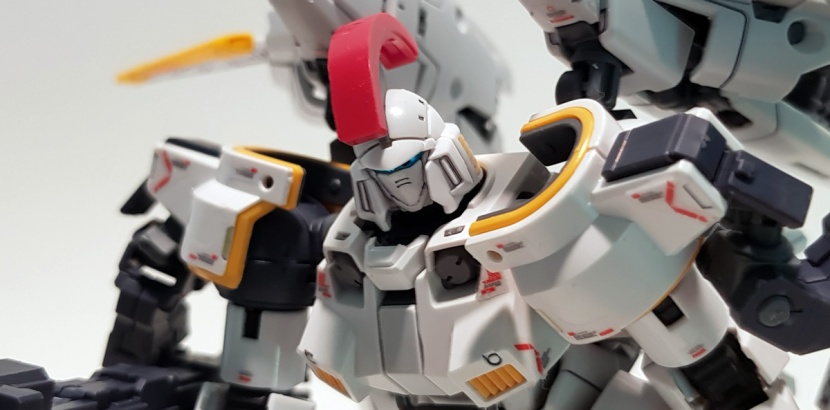
See, way back around the turn of the century, I was really exclusively into Tomy Zoids and wanted to do a bit of kitbashing. Word around the Zoids community at the time was that “Gundams” made for good parts fodder, so I bought a few. The first of them was the 1/144 Tallgeese (this No Grade version, if memory serves), and while I did raid it for parts, I also built it first because I was curious about the kit. And honestly, taking it apart to slap the boosters on a Redler and use the shoulder joint to mount a cannon on kind of hurt. I really liked the design, and it was hard not to notice the quality of the kit, even back then.
Years later, I still sometimes thought of the Tallgeese and kind of meant to replace it. I’ve had the MG version sitting in my closet for a while now, but I’ve always been a bit apprehensive about whether I’d be able to do it justice. It’s white and it needs pre-shading, but all those curvy armor pieces look like they’re going to be a bitch and a half to shade.
Needless to say, when the RG was announced, I got my preorder in faster than a fat guy orders his supersize meal at Mickey Dee’s. Finally a quick fix for the glaring absence of a Tallgeese in my Gundam collection, and it’s the right version, to boot.
So here’s what’s in the box.
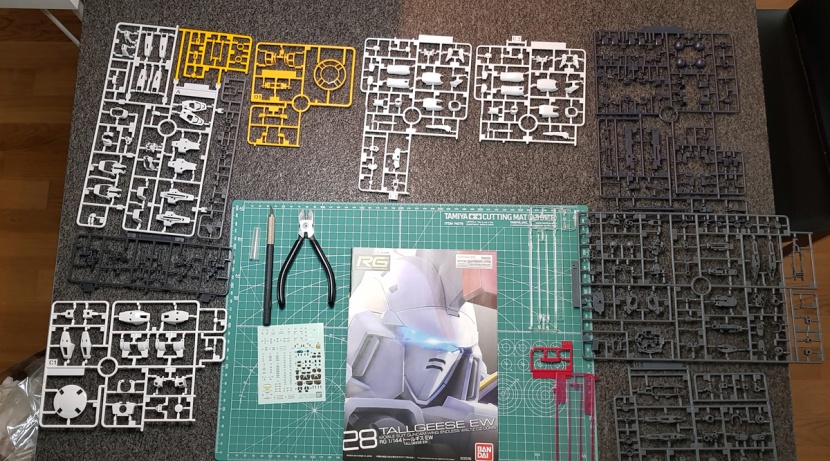
For some reason, the kit includes two clear beam saber effect parts along with the usual red ones. Sadly, the camera for the Dober Gun is also molded completely clear. There’s a blue sticker for this, but I decided to paint it clear red instead because clear blue always comes out too dark. Turns out the red did too. Oh well.
The sticker sheet is fairly small, which shouldn’t be too surprising – they opted to keep the general slick look of the Tallgeese and not clutter it up RG style with too much surface detail, and so there also aren’t that many stickers.
The white plarts are molded in a similar glossy plastic to the Sinanju and also pretty much all undergated; I don’t think there’s a single visible nub mark on any of the armor.
The big thing to notice here, though, is the small size of the B sprue. The internal frame on this kit is almost completely assembled the old-fashioned way with only a small handful of the usual pre-molded joints.
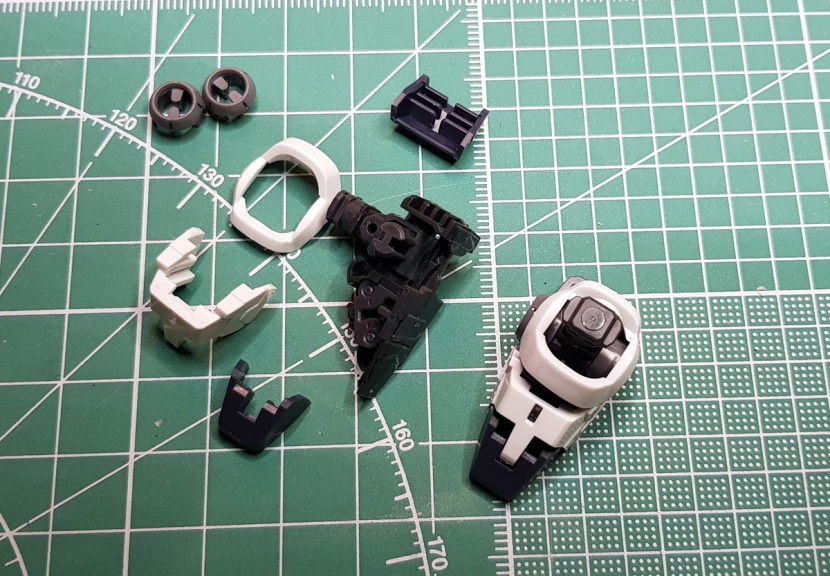
Nothing out of the ordinary about how the build starts, though – it’s with the feet. You take the internal frame part for them (which is really chunky in this case) from the B sprue and slap the armor on it.
What follows is unusual, though. Here’s the inner frame for the legs.
Only the part in the top left of the first picture comes from the B sprue, the rest is just regular grey plastic. You then assemble the knee joint with the mechanism for the armor separation much like you would on an MG.
Then you add the armor and you’re done. Nothing fancy here, although of course the ball-shaped joint for the hip also doesn’t come pre-molded.
An amusing idiosyncrasy is how the bottom of the armor goes on – at first I thought this was the ankle armor and just sat loosely on the foot, but you actually click it into place after assembling the rest of the leg like so:
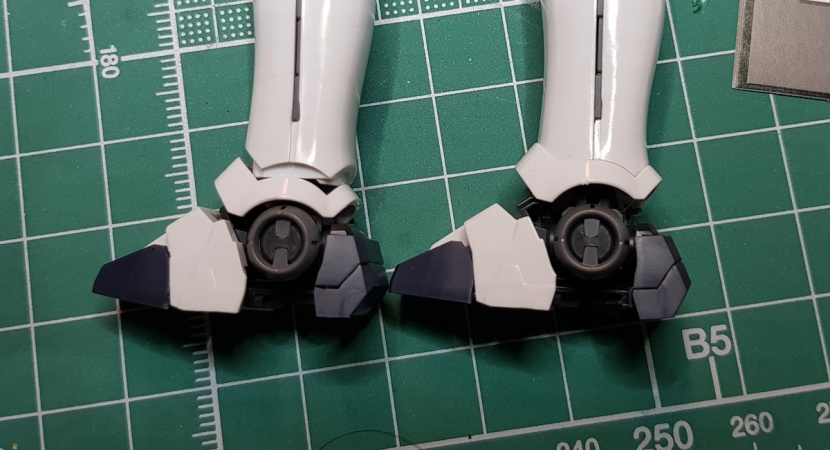
The waist unit is a rather massive undertaking, of course, because all the skirts have to open. It also doesn’t have a B sprue part, you actually start by sandwiching its halves together with the moving parts in between.
The extending crotch thruster gimmick will never not be weird. How many more kits with alien genitals are we going to get, Bandai? Wasn’t the Nightingale enough?
The rear and side skirts are next; the rear skirt section is one piece, but it still consists of a number of parts because it has two separate hatches that open to reveal thrusters, and the side skirts are actually double jointed.
Speaking of the side skirts, they also have this little connecting rod that plugs into a hole on the side of the thigh to help them move along with the legs. This works very poorly, though, as the rod keeps unplugging from the leg. And frankly, if it didn’t, you’d probably snap it in half within five minutes. So it’s all really kind of pointless.
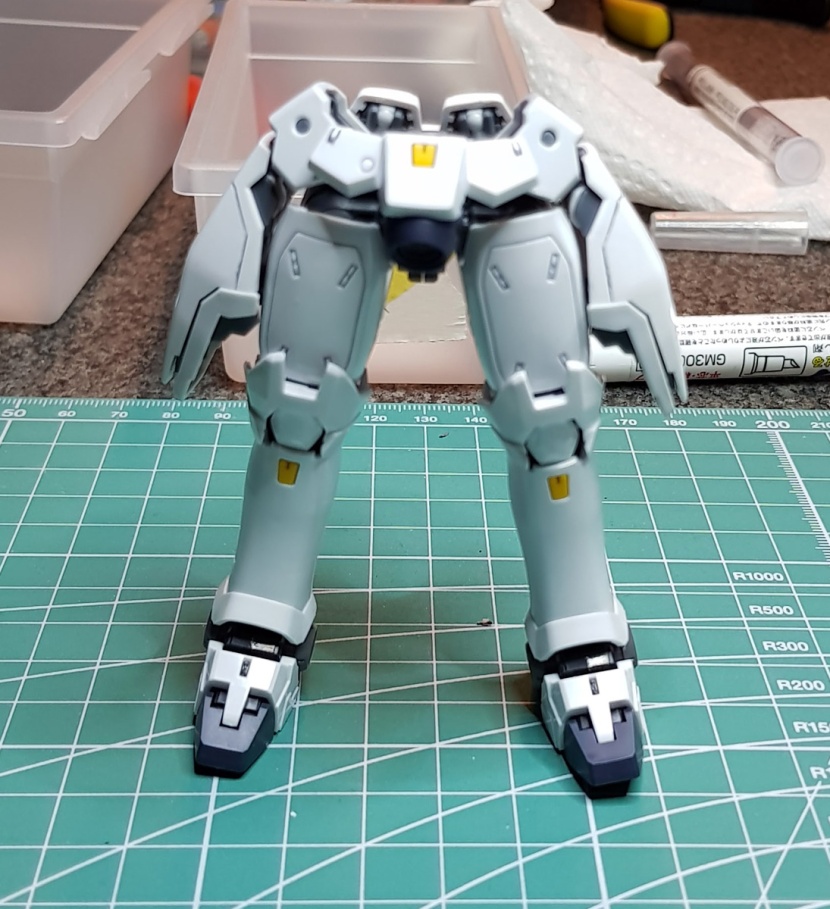
Yep, starting to look like the Tallgeese alright. Next is the torso. You’d think this section would be simple as it’s so tiny because Katoki proportions, but you’d be wrong.
As there’s no B sprue part for the torso either, it all has to be assembled; the advantage of this is that the white part for the cockpit hatch can simply be attached between the two torso halves.
The arms have the only B sprue part that really looks like your standard RG inner frame. In another amusing bit of Tallgeese assembly weirdness, though, the orange yellow trim part for the wrist doesn’t just click on, but you put it on and then rotate it 90 degrees to lock it into place. Same with the entire shoulder armor assembly. Be careful not to get the B parts for the arms mixed up – they look almost identical, but they’re not, and if you rotate the shoulder armor the wrong way to lock it, you end up causing damage. How do I know this? Oh, just something I heard.
Another oddity about this assembly is that you do not, in fact, attach the arms next, but build the head, in two parts.
The instructions specifically tell you to first attach the bottom part of the head to the neck, then the dome/face combo. I have no idea why. Or why the instructions are done in a way that forces me to break with my Headless Hessian tradition. Anyway, it’s a nice looking head, but they really could have added some detail to the crest/fin/whatever. This thing looks beyond weird for a RG.
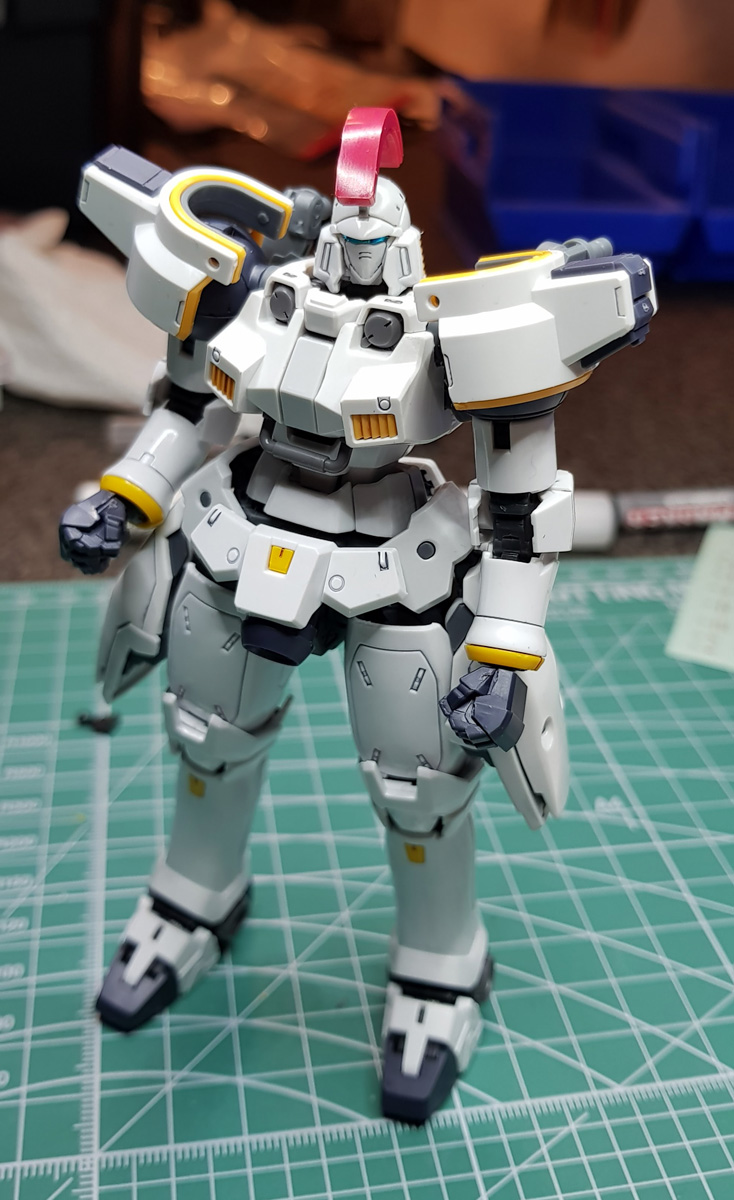
And here we are sans boosters. Needless to say, their assembly is pretty involved. Everything has to open and close, so the boosters are broken down into several interlocking sections.
In all honesty, I’m not terribly impressed with the engineering here. These things certainly look nice, but there’s a moving lever part in the middle (just under the armor piece with the yellow bit) that does basically nothing, and everything else has to be pried open and moved into place manually without any kind of mechanism making it slide into place on its own.
But anyway, here’s a shot of the suit with and without its accessories before I put the stickers on. As you can see, it stands up just fine, which comes as a pretty big surprise.
The accessories are about what you’d expect, except for the hand options. You get a pilot figure, the aforementioned four beam saber effect parts and two handles, the Dober Gun and the shield, plus no less than seven hands. Two fists, two open ones, two holding hands for the beam sabers and the handle on the shield, and one trigger finger hand for the gun. Also, the beam saber handles can be stored inside the shield.
The holding hands have angled wrist joints and also hold the sabers at a forward angle; this works really well for posing, as you can see here. The suit can hold the sabers at a much more natural angle than the awkward 90 degree TF G1 toy pose that you tended to get with the older RGs. No poseable hands, by the way, and thank god for that.
What doesn’t work as well, sadly, is the Dober Gun. The big contraption that attaches it to the shoulder armor works fine and can hold it up on its own, but it’s pretty ugly. Also, if you want to have the suit actually holding the handle as in the last picture here, you’re pretty much stuck with one pose for the arm – it’s a pain to wiggle it around until it all goes together, and there’s pretty much only one way to do it.
Poseability is pretty good considering all that’s going on with the kit. The torso has a considerable amount of ab flexibility and the head can also be tilted backwards so you can get some decent forward flying poses out of the kit. It’s also really, really solid – I don’t think a single piece fell off while I was working with the kit for these pictures.
And of course it looks great. I was a little apprehensive about the design choices here when I saw the preview pictures – obviously the designers struggled with the fact that the Tallgeese’s look doesn’t really lend itself to an RG kit. It’s meant to have a lot of large, clean surfaces and too much clutter wouldn’t have made it look meaner or more interesting, just weird. I think ultimately they struck a really good balance here where the kit looks detailed, but also retains the character of the original design.
I’d definitely recommend this kit if you’re a fan of the Tallgeese. If you’re not, though, I’m not sure there’s any urgent reason to get this. It does everything it needs to do, it works, it’s sturdy, and it’s also a really fun and smooth build without too much frustration or fiddliness, but on the other hand, there’s just nothing all that special about it, other than maybe the near total absence of the usual RG inner frame parts. It’s just a good, solid RG kit of a classic suit that won’t disappoint you if you like said suit, but if you don’t, it also won’t change your mind.
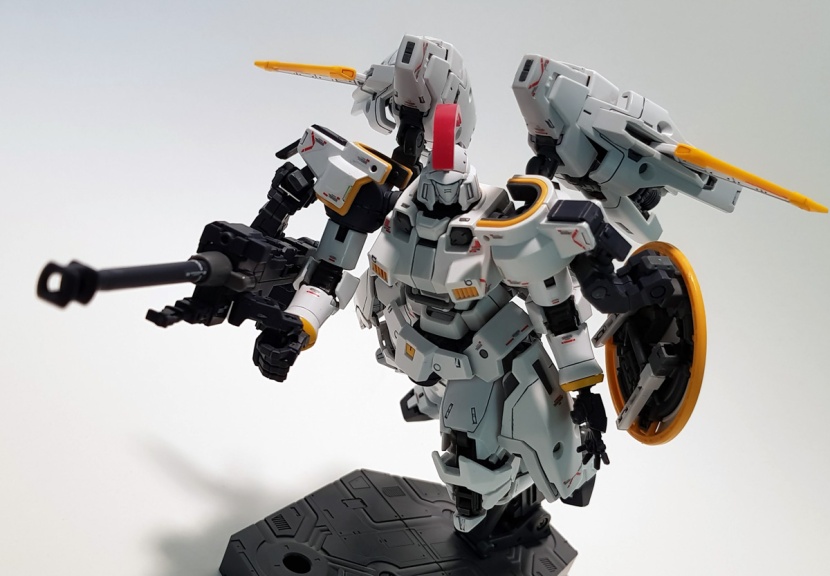
Real Grade Gundam Exia Build Review
Yeah, I thought I was going to get some photoshoots done this month, but guess what… I didn’t. So what I’ve got, and you know I have to get this one here so my archive isn’t missing a month, is a build review of the RG Exia that I snapped together a few weeks ago. No pose pictures, or at least not yet – you might remember I did the same thing with the RG Unicorn… and also haven’t gotten around to the photoshoot yet.
Anyway, the original plan was for this to be the first time I use waterslides on an RG, but once I started prepping the parts, it became pretty obvious that that wasn’t going to happen. The RG Exia isn’t super complex or anything, but it does have a ton of clear parts with foil stickers under them and these clear sheet strips for the GN power lines, which really makes it impossible to just assemble the limbs and then topcoat them. And frankly, I just still can’t deal with the idea of painting RG parts individually, even if it’s just for a topcoat over waterslides. So I just did my usual thing here, panel lined everything on the sprues, then cut the parts loose and got to building.
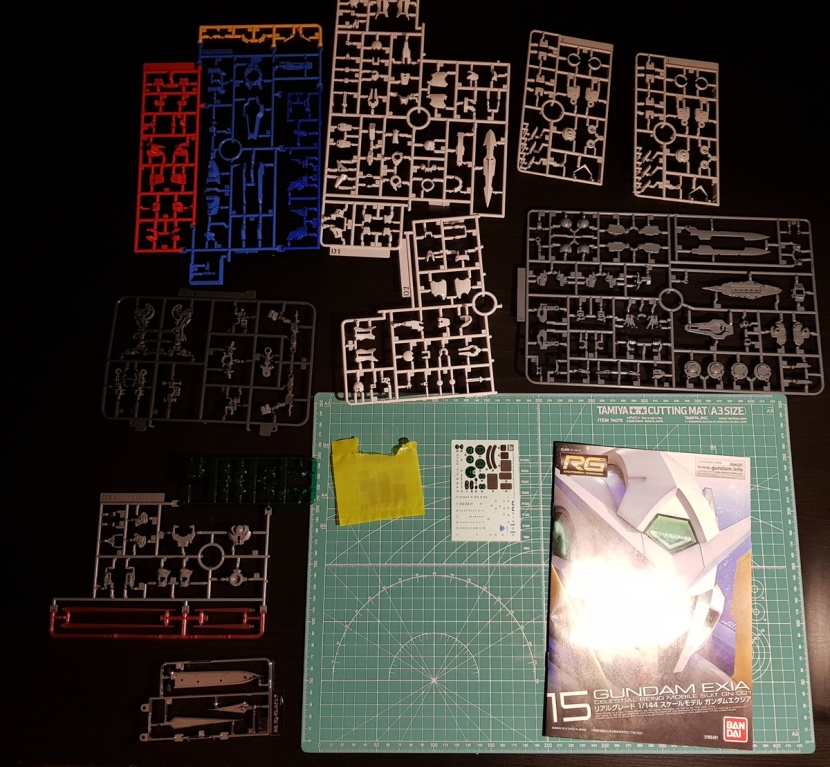
Behold the worst box contents shot in the history of RoboShop. Sorry about that, folks, but obviously by the time I noticed that this picture sucks, I kinda couldn’t put the toothpaste back in the tube anymore.
Anyway, nothing too unusual going on here, with two exceptions – there’s a chrome plated sprue for the blades, and inside that little yellow bag is the sheet with the GN power line parts. More on that later.
The build starts with the legs, which, funnily enough, are actually not one piece on the B sprue. As you can see here, the foot comes attached to the lower half, but you actually put together the double-jointed knee from two other parts. It all works just fine and dandy, it’s just odd for a Real Grade, I guess.
The GN power lines are this weird iridescent sheet plastic. To be honest, it doesn’t look that great. In some places, like on the upper thigh, they have a foil sticker under them, but it really just ends up looking like you glued a piece of tinfoil to the kit. I guess this is just an aspect of the Exia’s design that’s difficult to pull off. You know, unless you want to pay three figures for the PG with the LEDs. I hear it looks pretty neat on that one.
The rest of the leg assembly is pretty straightforward. As you’d expect on an RG, there’s a fair number of moving parts, the foot articulation actually works for once, and the green foil sticker with the graphic printed on it actually looks really nice under the clear piece.
The torso is where the Exia’s commitment to the circle as a design element is the most extreme, and I have to admit, I got quite enamored with it when I was putting this section together. The armor pieces layer on top of each other in a way that really creates depth and detail, and there’s a real sense of functionality here where you get the feeling that this part powers the suit. Even though, you know, none of it makes any sense. It just looks convincing if you can suspend your disbelief long enough to believe in teenage boys that can control giant robots with space magic.
The GN drive, of course, plugs into the back. It’s very nicely detailed and has these three clamps that close to… well, look like they hold it. It actually clicks into place securely without them and then won’t really come off anymore, but it looks pretty cool.
The waist section isn’t built separately but attached directly to the torso as you assemble it. No side skirts, just front and back, and I’m happy to report they’re all two pieces each. This shit matters, folks. The beam saber handles, uh… plug into the Exia’s ass cheeks, I guess. Moving along…
Nothing unusual going on with the arms. There’s another clear piece with a sticker underneath, otherwise they’re very simple and don’t do much. I made a really bad mistake here, though.
See, the long GN power line that goes from the shoulder armor to the upper arm is meant to hook on to this peg on the side, and then you secure it with a small armor piece. This works perfectly, but the problem here was that there’s a friggin’ nub mark right on top of that peg, and so I more or less cut it off completely on the other arm. I did leave just enough there so it held the GN power line in place well enough to glue everything together, so it looks fine now, but… well, don’t cut off this peg, folks.
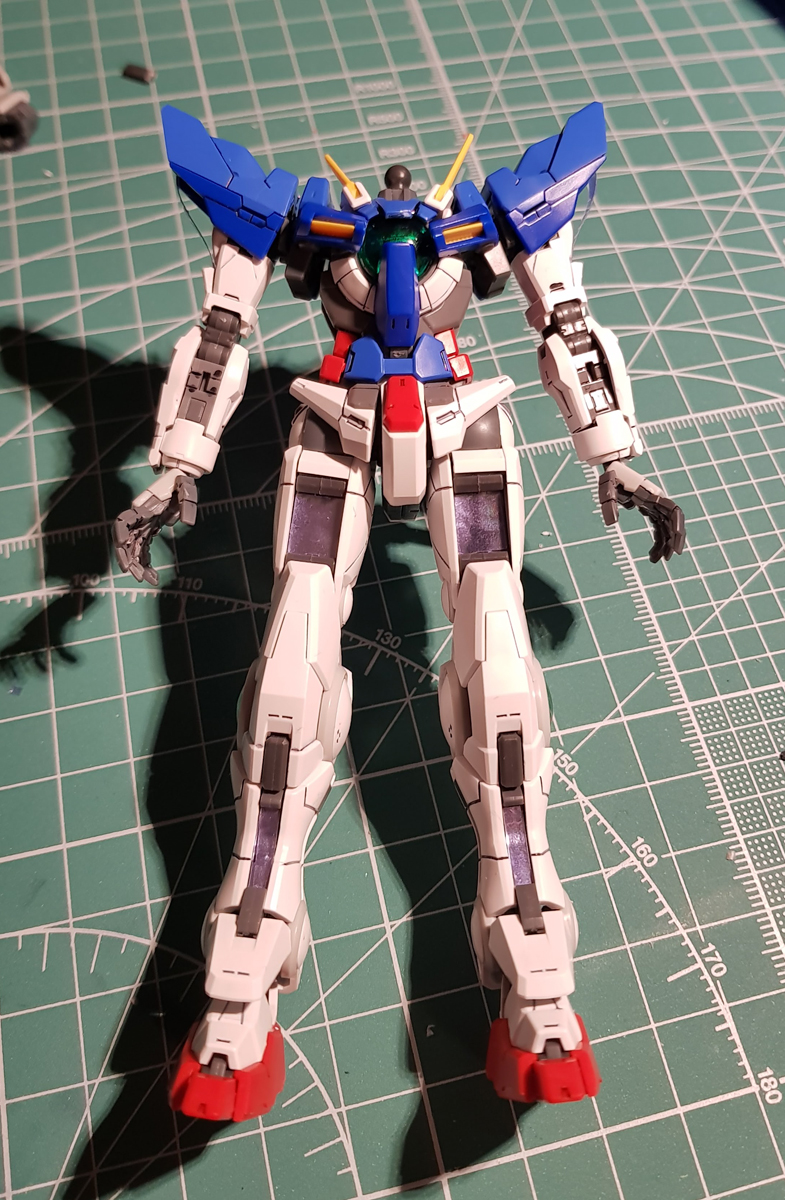
I don’t know why I keep taking the Headless Hessian pic, but here it is. I think it was at this point that I realized the fixed-pose open hands are laughably out of proportion with the rest of the kit. Notice also that I forgot to clean up some of the panel lines on the right arm. Oops.
The head is… urrk. Sure, it looks nice, but this may well have been the most difficult Real Grade head I’ve ever assembled. Those little yellow vent pieces fell out at least half a dozen times before I got them in place, and while you’re trying to prevent that from happening, you’re pressing down on a GN power line piece with one finger, trying to tuck it into the armor part that goes on top of it. And also, these weird little ear pieces have an absolutely massive nub mark on them. Which is actually kind of a running theme for this kit. It’s really well engineered and super solid, especially for an RG, but man, does it have some big, fat nub marks in really conspicuous places.
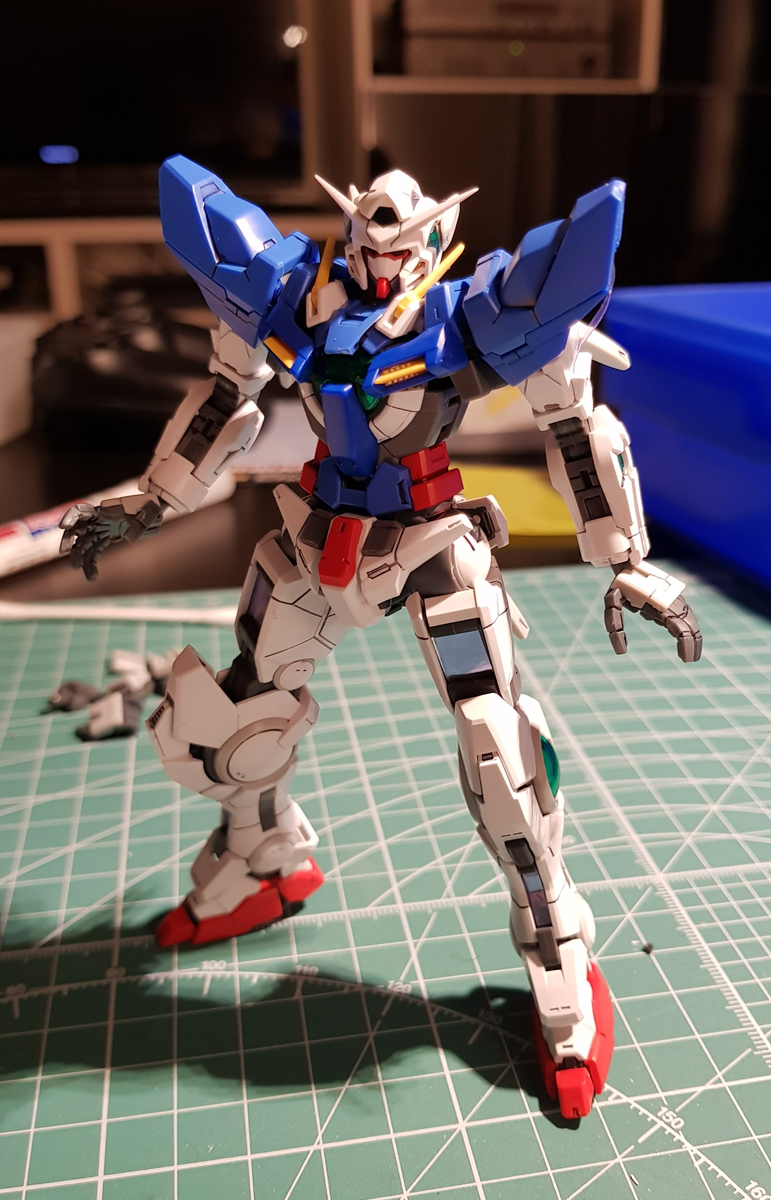
Anyway, head goes on, suit looks like zis, ja. I tried to do a pose with the open hands, but as you can see, it didn’t work out too well. I trust I’ve said enough times that I’ll always prefer fixed-pose hands like these, and I usually really like open “emote” hands for posing, but the way these bend at the wrist really make them useless, plus, like I said further up, they’re way too big for the kit.
And that’s it for this one, folks. I’ll have to post a second blog for at least the accessories and some pose shots, obviously, because the GN Sword’s kind of a big deal.
In the meantime, do I recommend this kit? If you like the Exia, yeah, absolutely. It’s designed with a lot of attention to detail, it poses well, and it’s one of the RGs that don’t explode when you touch them.
Real Grade Astray Red Frame
Yep kids, another update already. As I said previously, I’m really behind with documenting my builds, and I just finally had some time to snap some pictures. So here’s the Astray Red Frame.
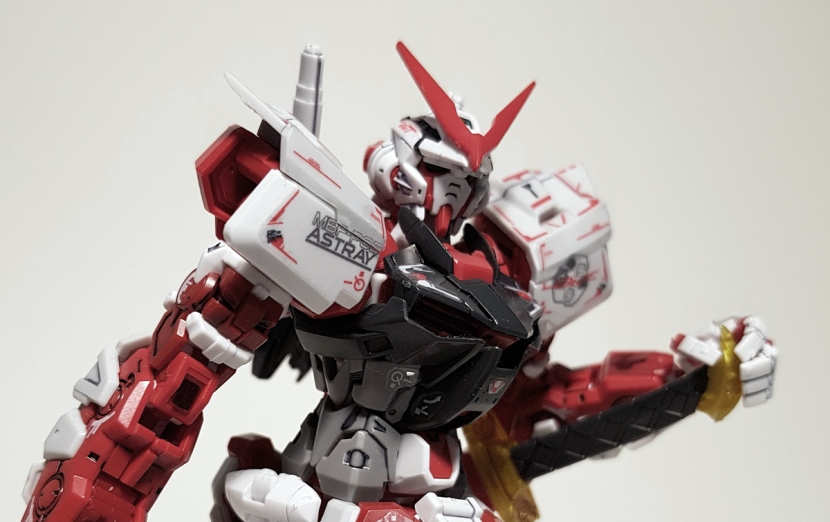
I really just bought this kit because I looked at it online one day, and an idea for a pose popped into my head that I couldn’t get rid of until I got the kit. Turns out, though, I really like this one, and I may get the PG someday. If and when I prove to myself that I can paint another PG and not just the Unicorn, that is. Anyway, here’s what’s in the box.
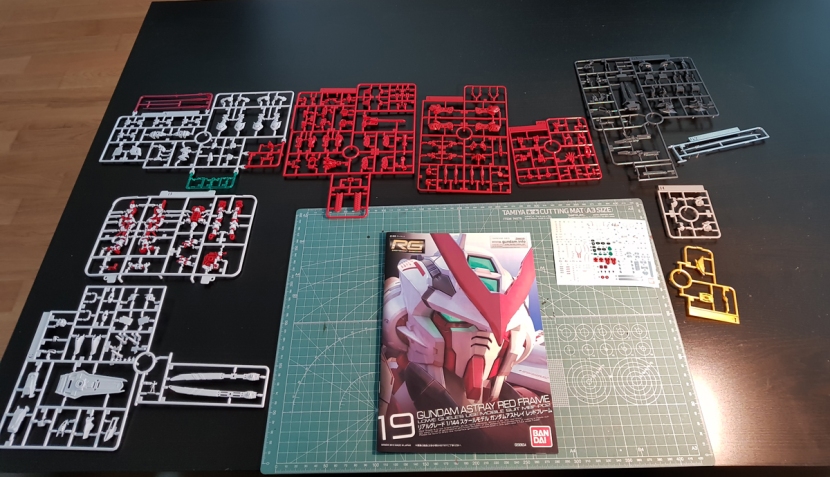
As you’d expect, it’s not much. The Astray has a lot of visible inner frame, which means few armor parts. I went with my now-standard method of panel lining everything on the sprues and then cutting/trimming all the parts before assembly here.
In a frankly shocking break with RG tradition, you don’t start the assembly with the feet, because the feet don’t come off the inner frame part for the legs. They do totally have you slap on the foot armor first, though.
There are definitely more parts on the legs than you’d think – the armor pieces layer over one another to create all sorts of interesting visuals. The inner frame is also molded in two different colors, as you can see, which looks pretty striking.
The waist section is a pretty simple affair, other than the opening gimmick that allows for extra poseability. Everything comes in two parts, though, with an inner red piece to add detail, which you probably know by now is something I really like.
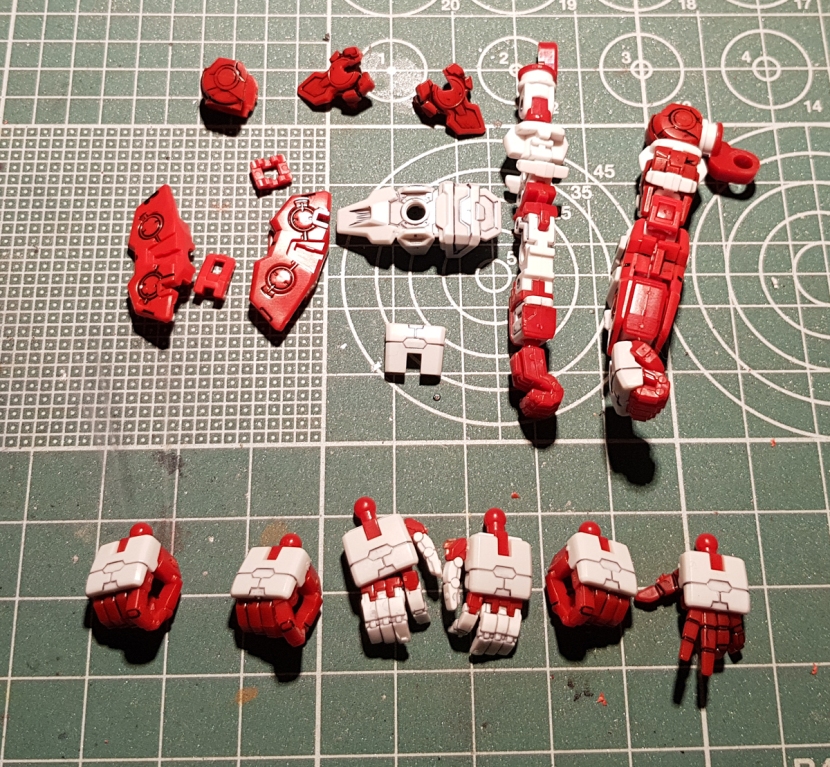
The arms are really simple, with barely any armor parts. Also pictured here is the array of hand options. Unfortunately, only the poseable hands come molded in the correct colors, but other than that, the Astray is one of those kits where they got it right, and of course you could paint the fixed-pose hands. Although white over red is a nightmare, and as you can see, I couldn’t be bothered.
The torso also has a good bit more parts than you’d think. You put the arms on first, then the armor parts. I do so like this torso design, and the RG captures it perfectly.
And here are the steps before the Headless Hessian Stage. The shoulder armor is really simple, but it doesn’t appear as boxy as it looks here once the stickers are on and you pose the kit a bit. You also add this waist piece with the side skirts. Nothing fancy here, which is why I grouped these steps together.
Regular readers will also notice you-know-what.
The head is a Real Grade head and so it’s frickin’ beautiful, of course. The v-fin takes a good bit of force to snap on, though, so keep that in mind.
The eyes here are actually just a clear piece. There’s a sticker, but I accidentally destroyed it when I put the parts together, and frankly, it’s not necessary anyway.
The backpack is maybe the most unusual looking part of this MS. It’s super sleek and doesn’t seem to serve much purpose other than holding the beam saber handles.
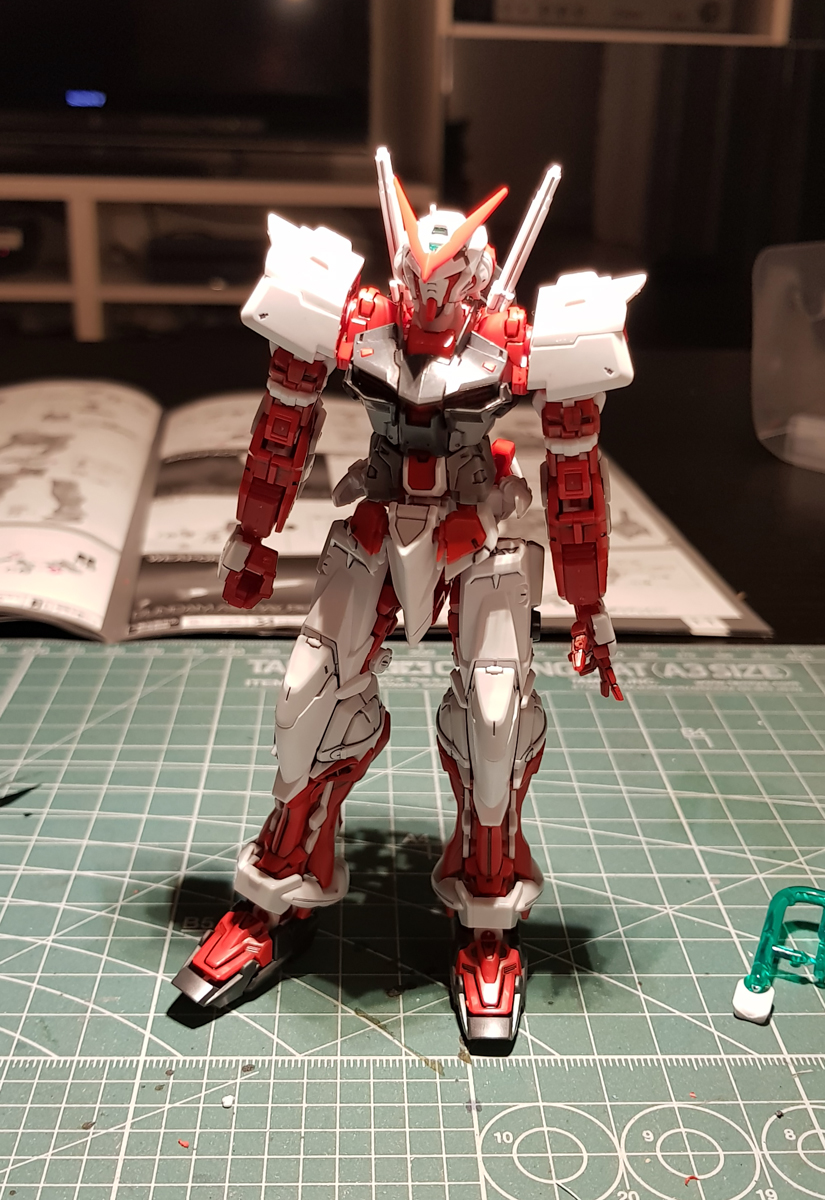
And here’s the suit all put together sans stickers and weapons. Looks pretty good already, but check out these accessories.
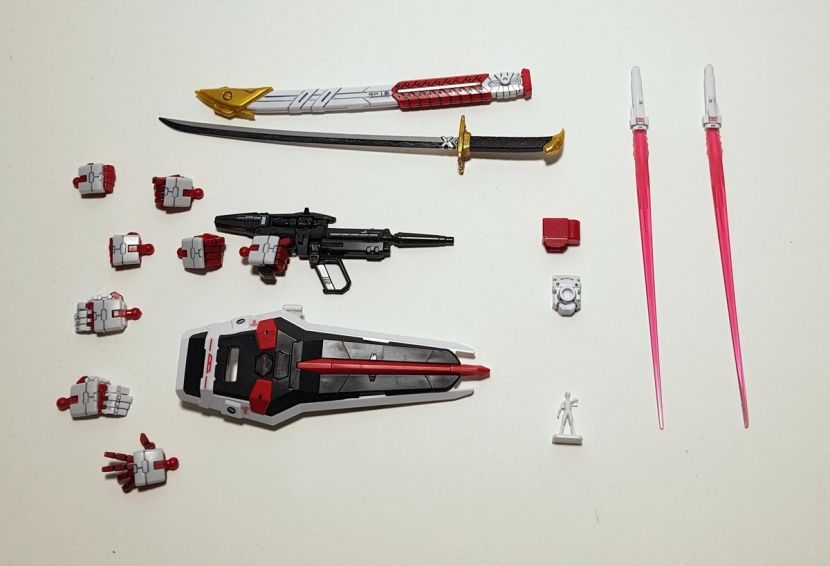
Yeah, that’s a lotta swag. You get two beam sabers, the shield, the beam rifle, the Gerbera Straight katana and sheath, an extra part to mount the sheath on the hip instead of the leg, an action base connector, a pilot miniature and the eight hands I talked about earlier. Now usually I’d complain about the dummy beam saber handles on the backpack, but the more I think about it, the more I come to favor these separate ones with the peg because the folding pegs on other RGs are a nightmare and just don’t friggin’ work. Everything here looks great and works perfectly.
Which is why I took a lot of pictures. This kit is just so easy to work with that it’s hard to resist. Everything clips into what it’s supposed to clip into and stays there. The only issues I had were the toe armor falling off exactly once, and one of the legs popping out of its socket once or twice. Otherwise, I haven’t had an RG photoshoot that went this smoothly since the Mk-II.
I will say, though, that while poseability is certainly serviceable (and it helps that things don’t pop off left and right while you’re posing the kit), it’s not as good as you’d expect it to be given that there’s really no armor to get in the way of anything here. For as spindly as they are, the ankles move very little, the disproportionately long lower thighs make a lot of poses look weird, and a lot of the joints just don’t move the way you’d expect them to and need to be twisted and yanked around to get them into position.
That’s it for my criticisms, though – this kit certainly gets my stamp of approval. It’s fun to build, looks good, poses well, it’s about as sturdy as an RG’s going to get, and it comes with tons of cool accessories. I guess some people are just going to dislike the kit’s overall appearance, but if you like the way it looks, you absolutely need to have this.
Oh, and that pose I bought the kit for? It couldn’t quite pull it off. This is as close as I got.
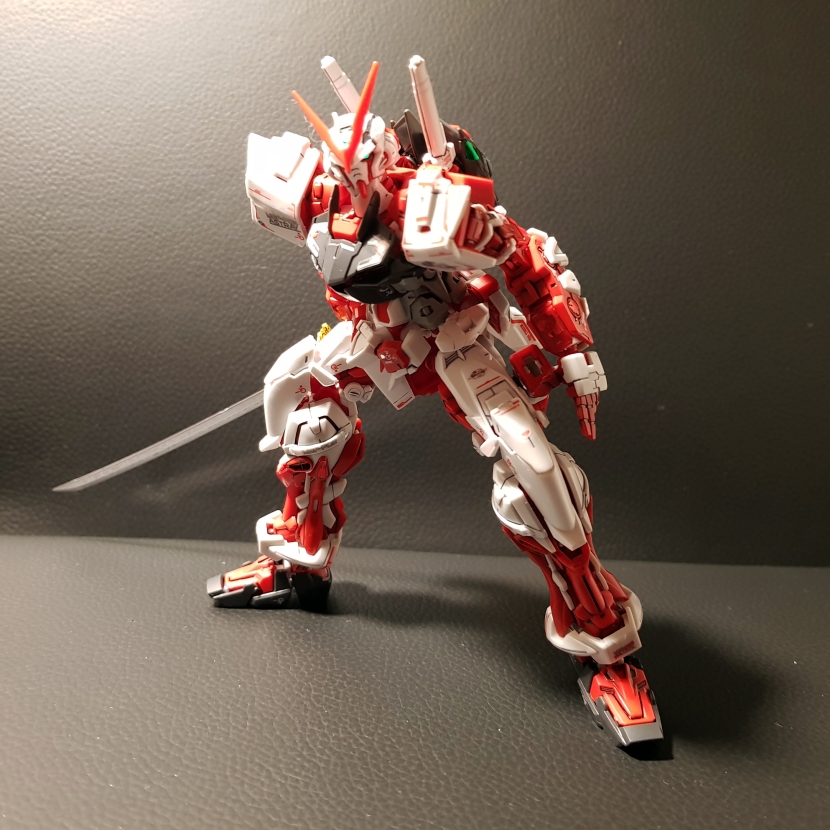
Real Grade Aile Strike Gundam
Yeah, I know, where the hell have I been. Like I said last month, I have actually been building lots of things, I just really haven’t had time to take pictures. Winter means it’s usually dark when I’m home and since I rely on daylight for my photoshoots, it’s been hard to find time to snap good photos of my build. I may have to get a photo booth or just live with night pictures for the next few months.
Anyway, while I was waiting for the Skygrasper to go with my PG Strike, I decided I’d build this kit to tide me over. I was also in the middle of painting an MG Banshee Norn, but since I was kind of going through a slump with that one, I figured maybe actually finishing a kit would, I dunno, help me regain my Gunpla mojo.
Also, Real Grades are like crack, and I can’t stop buying them.

The RG comes with the Aile Striker unit, obviously, unlike its PG ancestor, but the parts count still isn’t that crazy. It’s only the 3rd kit in the RG line and still relatively simple.
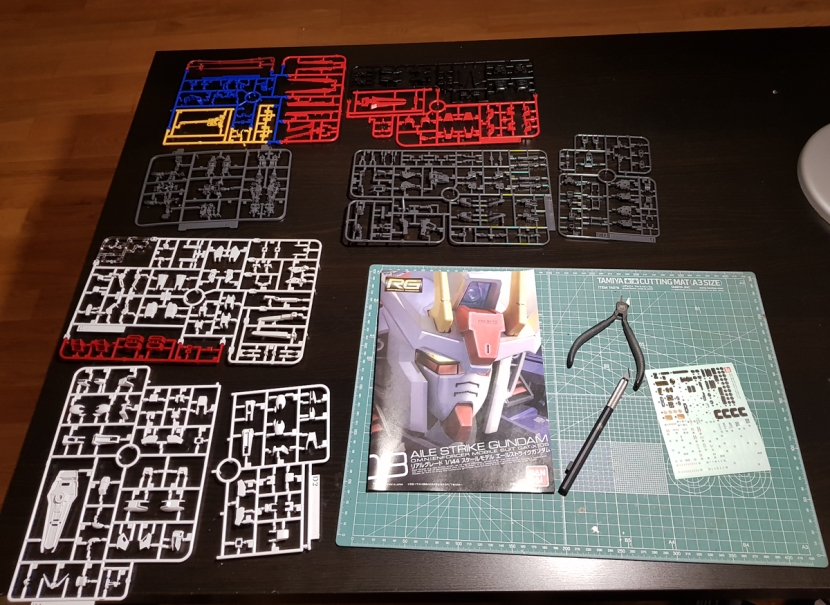
Note also the small sticker sheet. There’s an obnoxious amount of foil stickers, but only 74 regular markings, not counting multiples. Certainly far less than for the RX 78-2 and the Zaku that immediately preceded this kit.
Partially motivated by this, I decided to try something new and panel line this one. I never did this on Real Grades before – many of them look cluttered as it is, especially once you get the stickers on, and I always thought it was weird to have so many “real” panel lines because of all the parts separation on the armor and combine that with panel lines that are painted on. With hindsight, I’m glad I did it, and at least the Freedom probably could’ve used it too.
The way I decided to go about this was, I panel lined everything on the sprues with liquid ink Gundam markers – black for the blue and the dark red parts, grey for everything else. This seemed by far the fastest way to get the job done, and when you’re using these markers on bare plastic, it’s actually best to let them dry for a while anyway. For some reason, when they’re dry, they wipe off the surfaces more easily than when they’re still wet, and they stick to the panel lines like glue. So I just did basically a pin wash on everything first, then cut the parts loose and wiped off the excess during assembly. By the time I got around to each individual part, it had had enough time to dry to make cleanup really easy.
Once I’d cut all the parts off the sprues, I ended up with this.
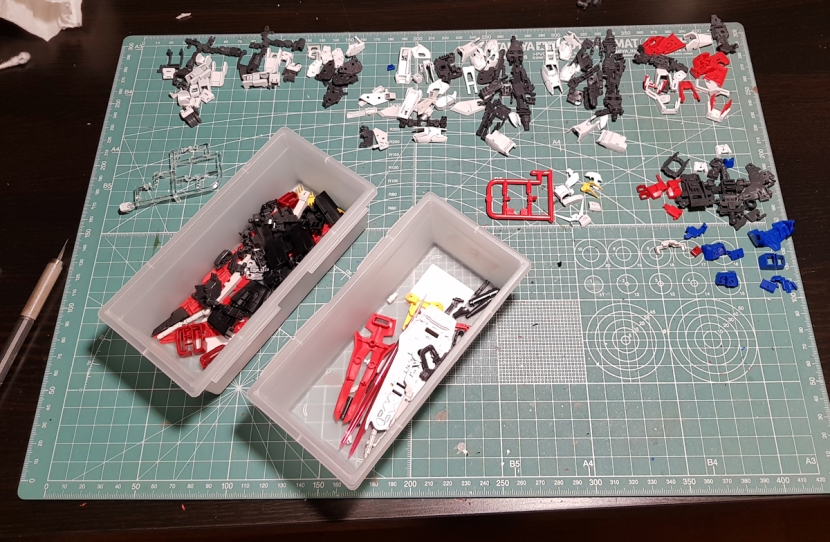
The trays contain the parts for the Aile Striker and the weapons, the rest is sorted by the steps in the instructions. It took about four hours to get here, and those four hours weren’t particularly enjoyable, but then again, they were followed by 90 minutes of uninterrupted assembly, so that part was really fun, and I’ll probably build all my RGs like this from now on.
Now stop me if you’ve heard this one before, but the build starts with the feet.
As you can see, they look nice (note the color separation on the soles) and consist of quite a few parts. As usual, though, articulation becomes virtually nonexistent once you get the armor on. Y’know, it’s an RG, so… yeah. That’s what happens.
The legs are one of my favorite things about any version of the Strike, so I was really looking forward to the next step, and it didn’t disappoint.
There’s not as much going on here as on the PG – the way the knee armor moves is far more simple, and the side pistons aren’t connected to the ankles. But the legs still look really, really nice with all the parts separation and the inner frame showing through the gaps. Right about here I also realized that panel lining this kit was a good idea as there’s tons of small detail on every armor part that pops nicely once it’s lined and adds to the mechanical feel of the legs.
The skirts are also relatively involved – each of them consists of two parts, and the side skirts have three because of the opening hatch for the Armor *snicker* Schneiders.
And I swear, you guys, this was the first build I documented with my new phone, and it did that thing where only the feet are in focus again. Both phones are Samsung. Do Koreans have a foot fetish? Sigh.
The shoulders are a disappointment, I’m afraid.
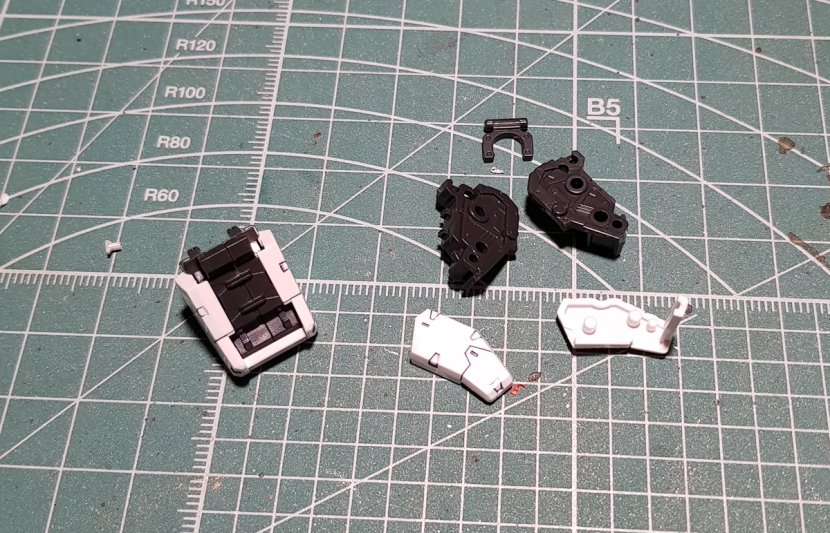
It’s ok that they’re this simple because they don’t really have to do anything, but they just look blocky and ugly. In fairness, there’s another part for each of them, but they don’t tell you to do this until you plug the arms into the torso – it’s the contraption on top that folds out where the add-on parts attach that come with the Skygrasper.
The arms aren’t all that hot either. Of course this is kind of inherent to the design of the Strike, but to me they look like a bunch of dice stacked on top of each other. That straight line down the front really is a bit much.
Also, the closed fists on the B sprue are the usual cat’s paw hands that nobody in their right mind would want to use, and since there aren’t any other options, you’re stuck with the articulated hands. And no, I won’t stop saying that those are ugly. Because they’re ugly.
The torso’s next, and I’m happy to report that it’s very detailed and much less frustrating to build than the PG’s torso.
I also still think the Aile Strike looks like a Camaro that thinks it’s a robot that transforms into a plane. Just, y’know, for the record.
Other than the opening cockpit hatch revealing the usual empty pilot seat, the torso doesn’t do anything, but it doesn’t need to – it’s just where you plug in the Aile Striker, after all.
The head is next, and, well, what can I say – it’s a Real Grade head, so you know what to expect.
Everything’s molded in the correct colors, and the detail is great. Like on the Freedom, though, the camera piece is inexplicably molded in clear plastic instead of the blue shown on the box, so you’ll have to paint it if you want accuracy. I skipped that this time because I’m still miffed about how dark it came out looking on the Freedom.
I also have to say that looking at the kit in real life, I don’t really think the head’s too big. That’s a common complaint about this one, and looking at pictures I always kind of agreed, but now that I’m looking at it on my shelf, it’s really fine.
Anyway, since I have the PG sans Skygrasper, of course the Aile Striker was the main attraction for me. It was getting late at this point, but no way was I going to stop without getting to see the suit with the wings on.
Speaking of the wings, for a pair of what’s basically straight airplane wings, they do consist of a lot of parts, which of course means they look really nice.
Up next are the boosters, which are also very detailed. They also come with a bunch of foil stickers that go behind those red grills, if you’re into that sort of thing. I didn’t use them.
And once the boosters are done, you plug it all together and your Aile Striker pack is done.
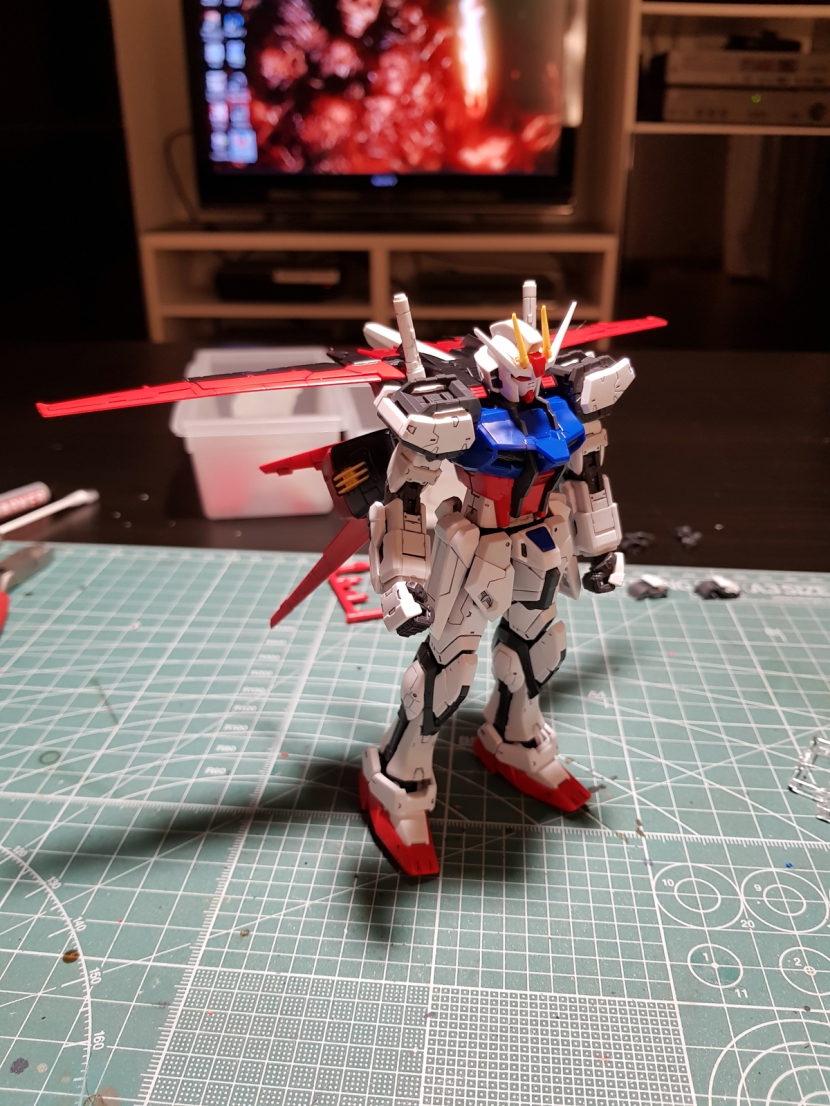
Now here’s the real shocker. You see that? No, not Gravelord Nito in the background. The kit is standing up straight. Only leaning forward a little. With that giant backpack on. I don’t know how that’s physically possible, but I saw ‘er with my own eyes, mister.
Now, accessories. The instructions actually tell you to build these before the Aile Striker, but I skipped ahead and then built the weapons the next day.
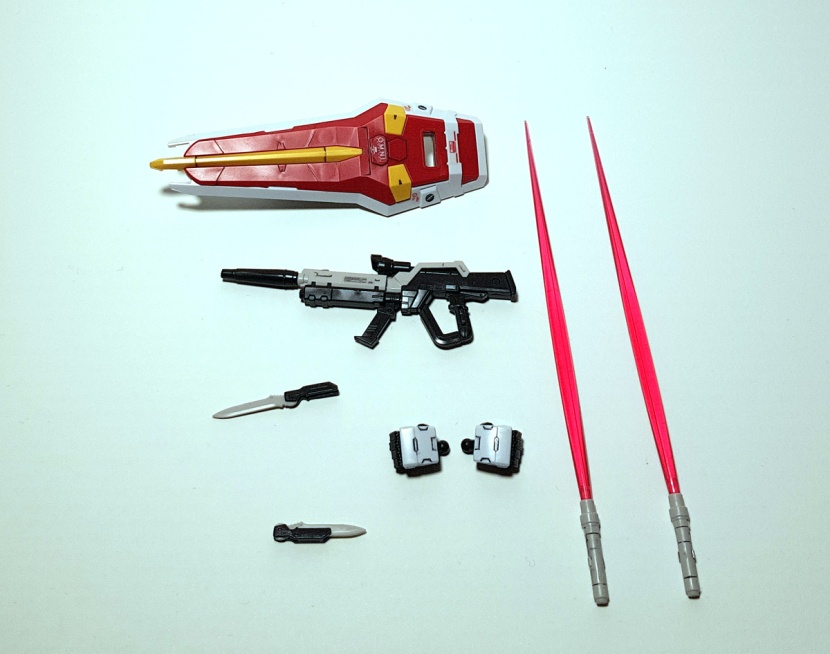
It’s not much – you get two beam saber effect parts, closed fist and articulated hands, the beam rifle, the Armor-Schneiders (no, I didn’t type that without giggling), the shield and the usual action base connector. It all looks very nice, but it’s not perfect.
The camera piece for the gun is also molded in clear plastic, and attaching said gun to the hand is a massive pain because the tab that folds out is so loose that you end up folding it back in instead of getting it into the palm about a dozen times before it works. There’s a trigger finger hand that comes with the Skygrasper set, but that doesn’t work either.
I also don’t like how the beam saber handles that go on the back are dummies and you have to store the real ones that actually go in the hands separately, especially because you only get two of the top pieces that the blade effect part plugs into, so you have to swap them out if you want to pose the kit with the sabers. Just seems like a totally unnecessary omission to me. And finally, while the Armor-Schneiders are actually better than their PG counterparts (they’re two separate pieces instead of the pre-molded stupidity on the PG), the hands can’t hold them for shit, which is why there are no pictures here with them.
Poseability is ok, but those side skirts do get in the way of a lot of leg movement, I’m afraid. Somehow, though, probably because of the backpack, almost every pose you do with this kit looks really cool.
As you can see, I did end up using a good number of those foil stickers for the wings, and for some unfathomable reason I actually quite like them. I don’t know what’s wrong with me.
Anyway, I’ll have another blog coming about the RG Strike someday – I also bought the Skygrasper with all the extra weapons, but there’s so much in there that it really does warrant a separate entry.
Meanwhile, do I recommend this kit? Absolutely. Other than the shitty hands, it’s very solid without sacrificing poseability – one of the least fragile RGs that I’ve built for sure. Of course if you’ve never liked the Strike or generally refuse to buy SEED kits, this one won’t change your mind, but I happen to be a fan of this particular design, and the RG is a very nice representation. In fact, I have a second one that I plan to detail paint and matte coat.
Real Grade Freedom Gundam
A while back, I tried to order the MG Freedom 2.0 from HLJ, basically because absolutely every review I’d read or watched on Youtube was gushing about what a great kit it is. turns out my attempt to get one fell right into the time when it was temporarily OOP, and while I waited for that to change, I decided to get the RG to pass the time, basically. Well, that, and apparently I’m now one of those people who can’t stop building RGs, and I needed an excuse for another one.

But while the MG 2.0 might be some sort of shining example of its class, I have to say the RG is profoundly middle of the road. Nothing seriously wrong with it and like most RGs, it looks pretty enough, but I do have a lot of small complaints that kind of add up, and I’m just not particularly impressed with it overall. But let’s take a look at the build first.
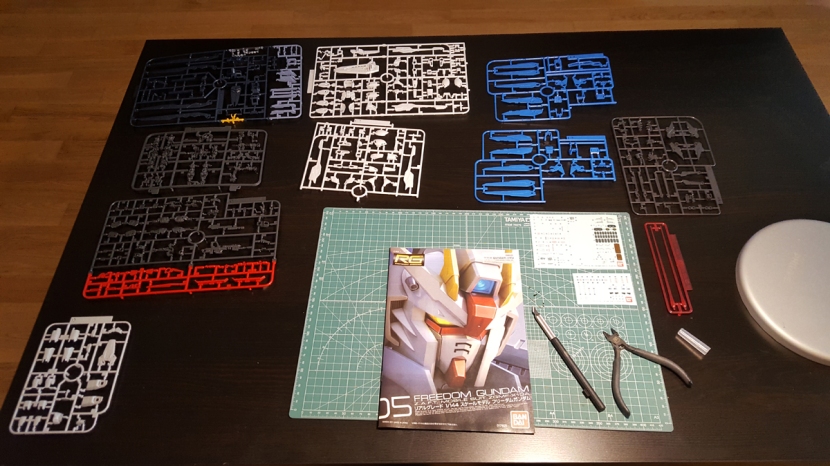
Here’s what’s in the box. That’s a surprisingly small number of parts for a Real Grade kit of a mobile suit with a massive backpack, and I’m afraid that brings me to my #1 complaint, which is that this kit is just kind of underwhelming in the complexity department.
As per usual, you basically work your way up from the bottom, starting with the feet, followed by the legs. Also as per usual, once you slap the armor on the inner frame for the feet, the joints become essentially useless. The knee bend is the 180 degrees you’ve come to expect, and otherwise there’s not much going on here. Because this is the Freedom, the legs are fairly spindly compared to other suits.
One word of warning – the last picture here points out a peg on the inner frame that’s very easy to mistake for a sprue nub. Do not cut off this peg. There’s a booster that attaches to it, and since (as you can probably guess) I accidentally cut off the peg on one of the legs, I ended up having to glue the booster. Not that that’s a big problem or anything, but it’s annoying, so, like… don’t do it, okay.
Up next is the waist section, which consists of a measly ten parts plus the inner frame. There’s one missing in the picture that I didn’t notice until I’d started assembling, but this is pretty much it. Now sure, part of the reason for this is that the Freedom has the massive rail guns instead of side skirts, but it still kind of tells you something about the amount of detail here. I could’ve done the same “look how few parts” shot for every section of the kit, this one just kind of stood out to me.
Note also that my camera did that thing again where only the feet are in focus. Sigh.
Up next is the torso, which is also nothing too spectacular, although the color separation is nice enough.
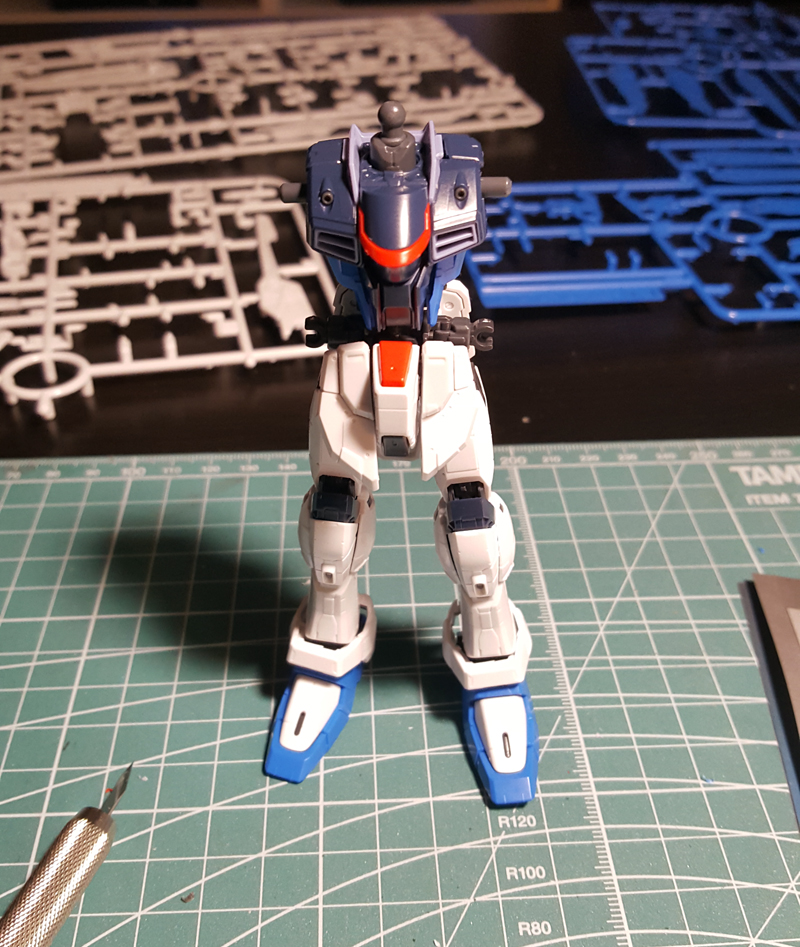
The waist only looks so spindly here because there’s a white armor part there that I forgot to put on, and I didn’t realize this until I was all done and started raiding the sprues for the parts for the weapons. Could I have gone back and taken these assembly shots with the error corrected? Sure. But then you guys couldn’t tell what an idiot I am, and that wouldn’t be any fun.
The shoulder armor is another disappointment. There’s a decent amount of color separation with the grey, white and red, but look at that booster. It moves, sure, but there’s no inner detail, it’s just one solid block of blue. I’m sorry, but I’ve just kind of come to expect this kind of detail to be done properly on RG kits, i.e. the grill should have been a separate piece in a darker color. They did do this on the rail guns, but not here, for some reason. Weak.
Now the arms are a bit more interesting. If you look at the way they attach to the torso, it looks like something’s gone wrong at first, but what you actually do is that you plug them onto the peg at a 90 degree angle, then turn the peg backwards into the torso. This allows a good degree of forward movement, so that the Freedom can actually cross its arms, which helps if you want to use the beam sabers in Darth Maul mode. Also, of course the elbow bends more or less 180 degrees.
The head is probably the most detailed section of the kit. Tons of great color separation, and it just looks excellent all around. However… yes, I have a complaint here too. The camera is molded in clear plastic, and there isn’t even a sticker to remedy this. The box picture clearly shows a blue camera, and there’s literally no reason at all why it couldn’t have been molded in clear blue, like the green camera on the Mk-II, and it would’ve looked fine. Needless to say, I had to go back and paint this as it just looks unacceptable.
Up next are the rail guns, which are another section of the kit where the color separation’s done right. They fold up into these still relatively chunky side skirts that really improve the overall look of the suit. Obviously these are the reason why the legs need to be so spindly, and once they’re on, it all makes sense.
Then we get to the wings. Now you’d think these would be the most annoying part of the kit to build, but they were actually what I enjoyed the most. They just work really well, and it’s interesting to see how it all comes together.
Notice also the nice detail with the overlapping dark and lighter blue, the red stripe on the guns, the inner detail in the boosters, etc. Clearly whoever designed these knew that the wings are the main attraction on the Freedom.
Of course the downside is, once they’re on, you’ve got yourself a drunk robot who can’t stand up straight. You can get him to stand with the wings folded and pointing down because they touch the ground, but that’s it. The whole thing is just way too heavy for the kit to hold it up. There’s pretty much no way to display it without an action base, and the point could be made that the kit should come with one. Other than that, it’s really not a problem – the connector piece that’s included with the kit works fine and dandy, and in all honesty, I don’t see why you’d want to display this one any other way than airborne.
Notice also that I took the second picture after I’d finally realized the white waist section was missing. It does, um, look better with it, doesn’t it. *cough*
And finally, here’s a shot with the shield and the gun, OOB sans decals.

And in case you hadn’t guessed it, that’s my segue to, yes – accessories.

Of which there aren’t a whole lot. You get two beam sabers, the gun and the shield. You also get two articulated hands, a trigger finger hand, an open one and the two semi-closed fists that come with the inner frame.
And that brings me to perhaps my biggest complaint about this kit, which is that the hand options are so stupid that I still can’t quite believe they’re an actual thing on an actual Gunpla kit. The “closed” fists on the B sprue, as you can see in the build pics, aren’t actually closed, they’re these half-closed fists that look like they’re supposed to hold weapons and otherwise evoke something like a G1 Transformers toy. Except they can’t hold any of the weapons. The beam sabers don’t fit in them, and even the handle on the shield is too big. So if you want to use the beam sabers or the shield, you’re stuck with the articulated hands, which, as I’ll never tire of pointing out, look ugly, especially when you combine them with the better looking fixed pose hands, like, oh, say, if you want the beam saber in one hand and use the perfectly nice looking open hand to go with it.
Oh, and also, the camera for the gun is molded in the same clear plastic as the one on the head, so that also needed to be painted, which is why the scope is empty in the final build picture, in case you were wondering. And what you can’t see is that the muzzle part fits on its peg so tightly that I ended up with a massive stress mark on it. That’s… not something I expect from Bandai.
I really think painting these parts made a big difference, but I’m also a bit miffed because the clear blue came out so dark that it really looks like glossy opaque paint, especially on the head. Still looks better than before, but I’m going to have to insist that the clear parts should’ve been molded in blue.
The stickers, as you’d expect, are many, and many of them are tiny. I thought it was kind of amusing that there are two sticker sheets, especially because the smaller one consists mostly of something like two dozen copies of the same “circle with illegible text next to it” marking. It’s as if they were all done with the kit, and then Hajime Katoki stumbled into the office drunk that evening, looked at what they had done and yelled, MORE STICKERS.
The kit comes with markings to either do it up as a generic ZAFT suit or as Kira Yamato’s personal suit – or so I’m told, I actually haven’t seen SEED yet. I just went with the Kira markings because I thought the ZAFT emblem looked to busy.
Poseability is pretty good – you’d expect a kit like this to be a brick, but it really isn’t. The folding skirt rail guns work well, the guns in the wings fold out, the arms and knees move well enough, and the kit has more mobility in the waist than most Gunpla kits, which helps get some more “natural” looking poses.
The articulated hands, aside from being ugly, don’t really work well here, though; the pegs on the beam sabers are too small and don’t help them stay attached at all. You’re going to have these falling out of the hands left and right if you want to use them.
The kit is also just flimsy as hell in general. If you’re wondering why I didn’t try more poses even though I just praised the kit’s poseability, it’s because it took me half an eternity just to get these ones right. Everytime you move one thing, something else gets knocked out of whack, and it’s not just the wings, it’s everything. Getting that one pose with all the extra armaments pointing forward made me want to throw the kit out the window and drive my car over it a couple of times.
I’d say this is another case of “recommended if you like the way it looks.” It’s not a particularly fun build and it’s somewhat disappointingly simple (I seriously considered doing panel lines here, which I never do on RG kits), but once you slap all the stickers on and you get it into a good pose, it does look pretty impressive. But if you’re looking at pictures and you’re not sure whether you like it, actually having the kit in your hands probably won’t change your mind.
Real Grade Unicorn Gundam: Build and Transformation Review
So today we’re doing something a little different. I just got my RG Unicorn in the mail, and I thought since the kit is brand-spankin’ new and there aren’t all that many reviews of it out there yet, I’d snap it together and write this. It’s not every day I get to actually write about something that hasn’t already been out for half a decade, ahem.
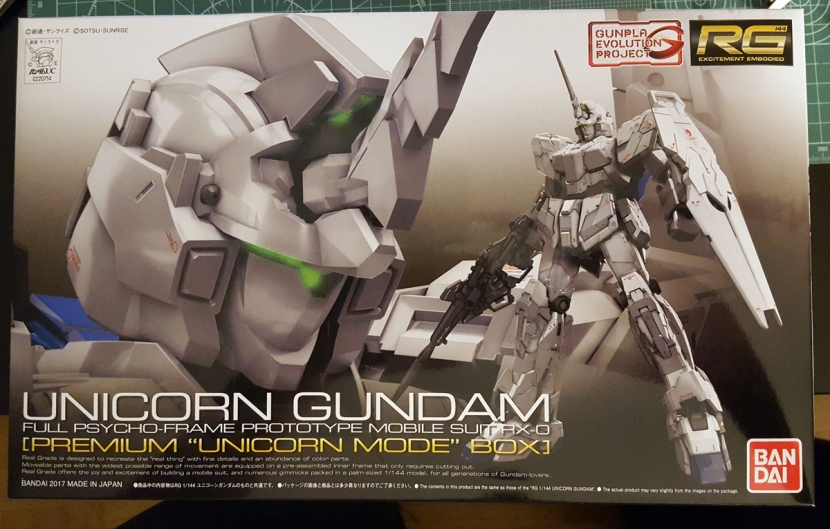 I was lucky enough to snag one of the last of these “Premium Boxes”. I’m really not sure why I cared enough to buy both this and the regular version. Other than the artwork on the front, the only difference is this:
I was lucky enough to snag one of the last of these “Premium Boxes”. I’m really not sure why I cared enough to buy both this and the regular version. Other than the artwork on the front, the only difference is this:
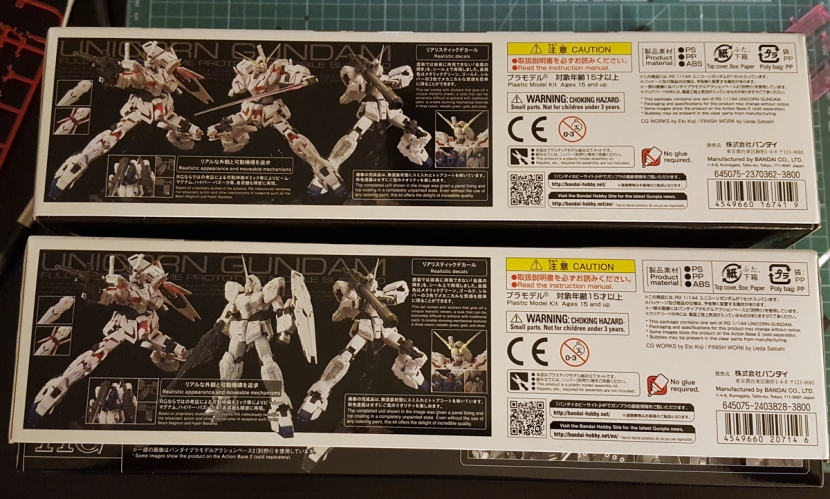 The box contents are exactly the same. Given my well-documented soft spot for Unicorn mode, I kind of wanted the premium version, but it’s really not that big of a deal if you missed it, unless you’re the completist collector type, in which case, have fun with the scalpers on eBay.
The box contents are exactly the same. Given my well-documented soft spot for Unicorn mode, I kind of wanted the premium version, but it’s really not that big of a deal if you missed it, unless you’re the completist collector type, in which case, have fun with the scalpers on eBay.
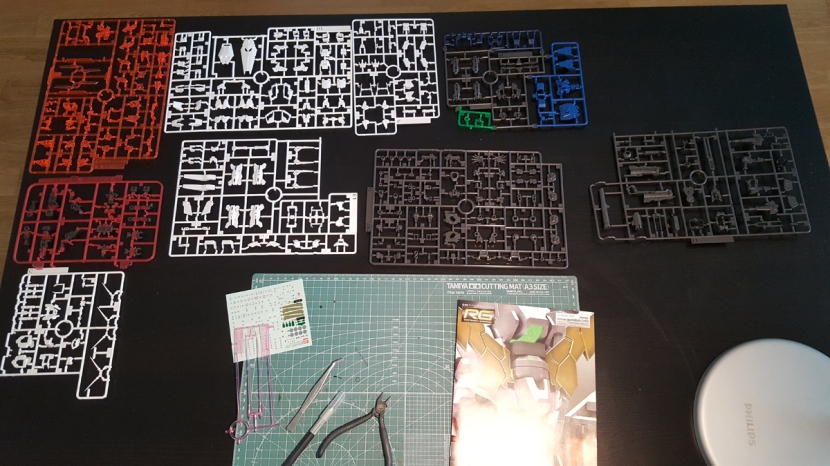
Here’s what’s in the box. It’s a surprisingly manageable number of sprues, but as you can see, there’s a ton of parts per sprue. For some reason, four of the sprues have a number 1 next to their letter, but there’s no number 2. I wonder if this means we’ll get 2s of these sprues with future variants like the Banshee that’s inevitably coming (and it better not be a frickin’ P-Bandai release, either.)
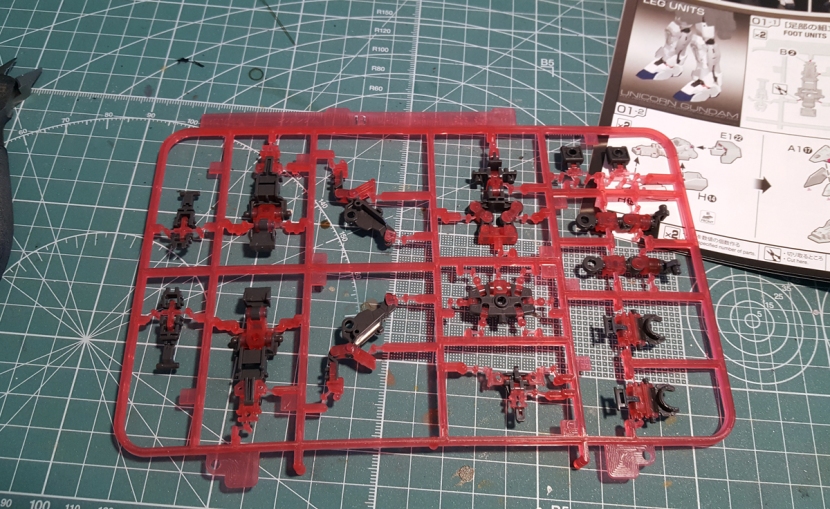
Here’s a look at the B sprue, which I’m guessing everyone has seen by now. It really does consist of clear red and opaque grey plastic, although, as you can see in the previous picture, most of the psychoframe parts are on their own sprue.
Also this. 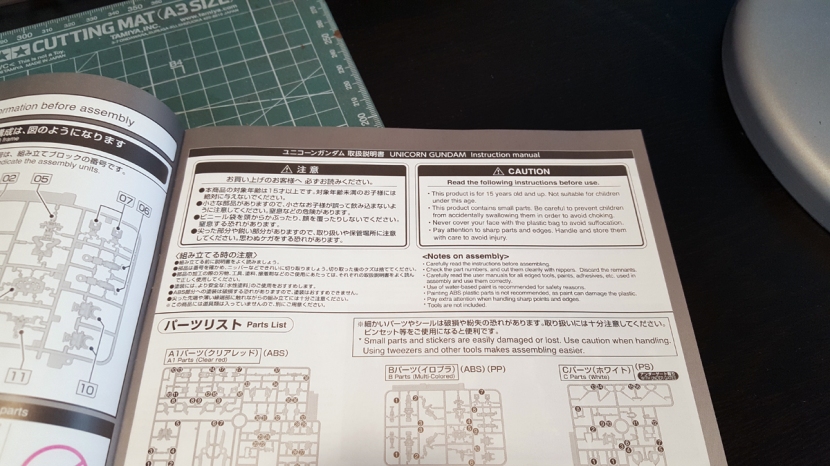
Yep, nearly everything in the instructions is translated to English. I’m not 100% sure, but I think Bandai started this with the High Resolution Barbatos, and apparently it’s now happening with the RGs as well. The translations are good, and while I never felt like I needed them, they’re nice to have as they do further clarify certain things, and I’d always wondered what exactly all that text said. It’s also cool to see Bandai finally acknowledging that they’re actually selling to an international market.
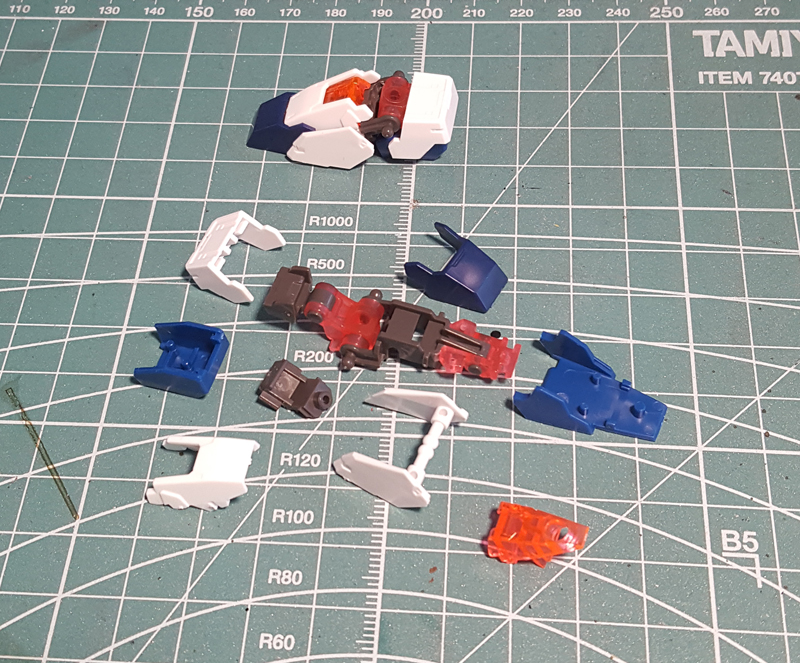
Unsurprisingly, the build starts with the feet and then you work your way up. The feet are only marginally more complex than what you’d expect – there’s your inner frame part from the B sprue plus a bunch of armor, and that’s it. For some reason, the instructions don’t have you attach the two armor plates on the side that rotate for the transformation yet. This is kind of a running theme with this build – everything works fine, but the order you do it in is sometimes a bit odd. Case in point:
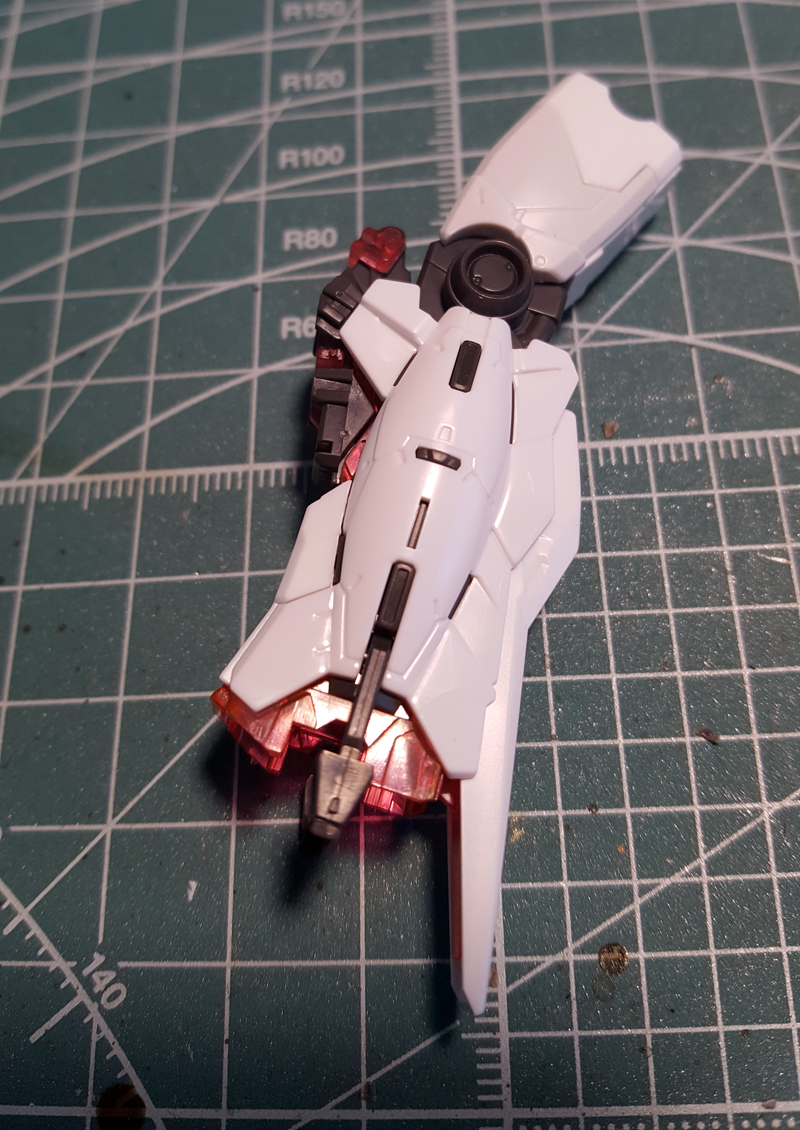
The next thing you build after the feet is one leg, or most of it anyway, and then you build the ankle to go with it.
At this point it really kind of struck me how similar to the MG so much of this kit is. Look at the assembly for that floating armor piece that goes on top of the foot here – it’s almost exactly the same.
Next you put it all together and start on the second leg. Here’s a shot of the completed leg with all the parts for the other one next to it, to give you an idea of just how complex this thing is.
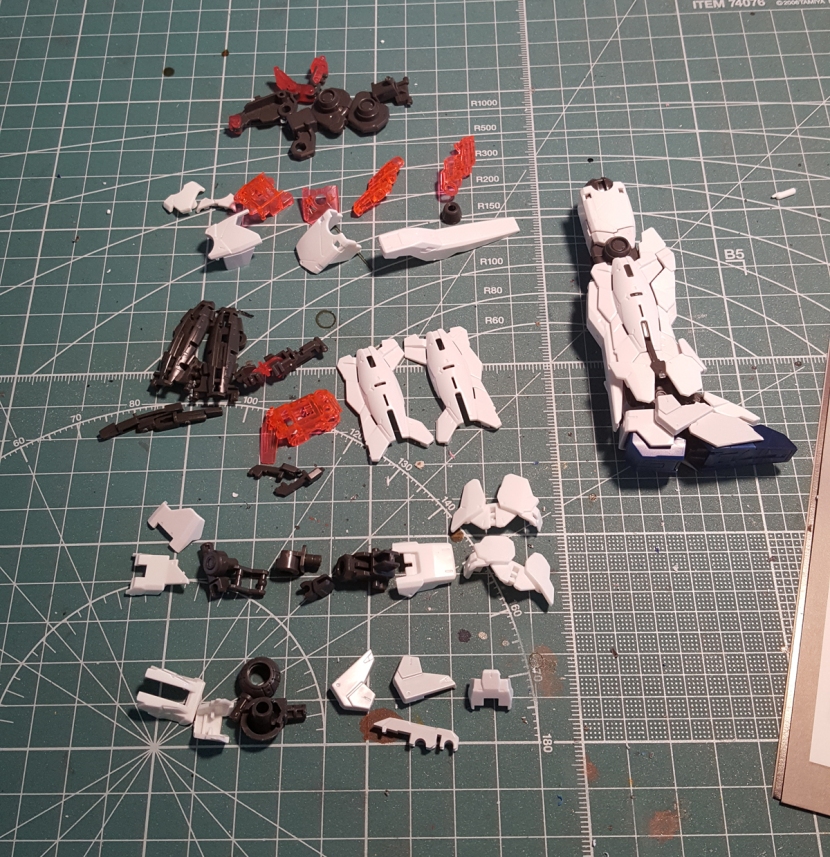
If you’ve built a Unicorn before, it shouldn’t come as a surprise that the legs are by far the most involved part of this kit. I didn’t clock myself, but I think it took me close to an hour to get one leg assembled, and they do literally everything the legs on the MG do, except, well… better.
Note the knee bend of nearly 180 degrees, for example. And speaking of the knees, the way the transformation in this version works is that there’s a mechanism that causes that infamous psychoframe piece to move outward when you pull the flap with the thruster away from the calf. It’s still a bit difficult to do and the knee armor still doesn’t properly attach to it (plus it has a tendency to pop off), but it’s infinitely better than the screaming nightmare of frustration that is the MG’s legs. All that, and they bend farther as well.
Note also the panel lines on the sides of the lower legs mimicking the opening panels for unchained mode on the PG version.
Obviously the waist section is next. Look at all these parts. Since all of the skirts transform individually, you’ll be working on this for a while.
Perhaps my favorite part about this section is the way the front skirts transform. Even on the PG Unicorn these are a problem; the moving panel is on a hinge and keeps popping off. The way it’s done here, it’s nearly impossible for this panel to detach itself. You do have to pry at it a bit to get it out, but it never comes off.
The side skirts, conversely, are a bit of a problem. They’re really tight, and I’ve had them pop off when I tried to transform them.
Far more importantly, though, I finally managed to take a legs and skirts picture where the top isn’t out of focus. Are unicorns supposed to be good luck or something?
Uh, moving along, we’ve got the torso, and here’s where I kind of figured out how this kit is different from previous RGs and what makes it work.
It’s actually more obvious in the legs, but here’s where I noticed it – the Unicorn’s inner frame isn’t so much plugged together out of the parts on the B sprue as a sizeable portion of it is actually built during assembly. They did something similar previously with the Sinanju, but of course on that kit it was a way to recycle the Mk-II frame. Here it’s a necessary part of the design because so many things have to move for the transformation. You’ll also notice the contents of the box are quite heavy when you first pick them up – there’s several sprues of ABS plastic here. Hopefully that means we’ll see the use of that material more frequently again in the future.
Anyway, as you can see, you put together some of the torso first, then you attach the inner frame of the arms, and then the rest of the torso basically in modules. When it’s all done, it transforms with an ease that’s almost irritating if you’ve built previous versions of the Unicorn. The shoulder vulcans pop up like it’s the most natural thing in the world, and you can’t help but wonder why this was ever a problem on other kits.
The arm assembly is similarly modular. First you build the wrist sections and the beam tonfa holders separately. I’m very happy to report that the parts with those triangular flaps on the sides of the beam tonfa holders stay in place very securely. Owners of the MG kit know why I’m pointing this out.
Next you attach a bunch of small armor parts here and there and then the two larger assemblies shown above. And you’re done.
The transformation of the arms isn’t particularly problematic on the MG and PG Unicorns either, but Bandai’s designers still managed to add a small twist here.
The part at the bottom of the beam tonfa actually functions as a locking mechanism that you fold out, then transform everything, then snap back in place. This way, the arms don’t collapse into Unicorn mode every time you pose them. Works beautifully.
Speaking of the arms and everything that’s great about them, here’s a shot of all the hands you get with this kit.

Open, closed and weapon holding for the left and right, all fixed pose. If you’re a fan of the RG articulated hands, you’re probably not happy about this, but me, I think this is what should come with every damn Gunpla kit. The articulated hands are ugly, and they don’t frickin’ work. I really, really hope this is a sign of things to come.
Anyway, up next is the shoulder armor. If you’re like me, you might have noticed in pictures of this kit that the shoulders look a bit too bulky, especially in Unicorn mode. That’s because all of this crap is in there.
Not only is it a lot of parts, it’s also really difficult and fiddly to put together. This was actually the only part of the build that gave me trouble. The tradeoff, though, is yet another section that transforms extremely well. You just open up the top, rotate the vent on the side and move the top back down. Done.
And what does that get us? Yep, another headless Hessian.
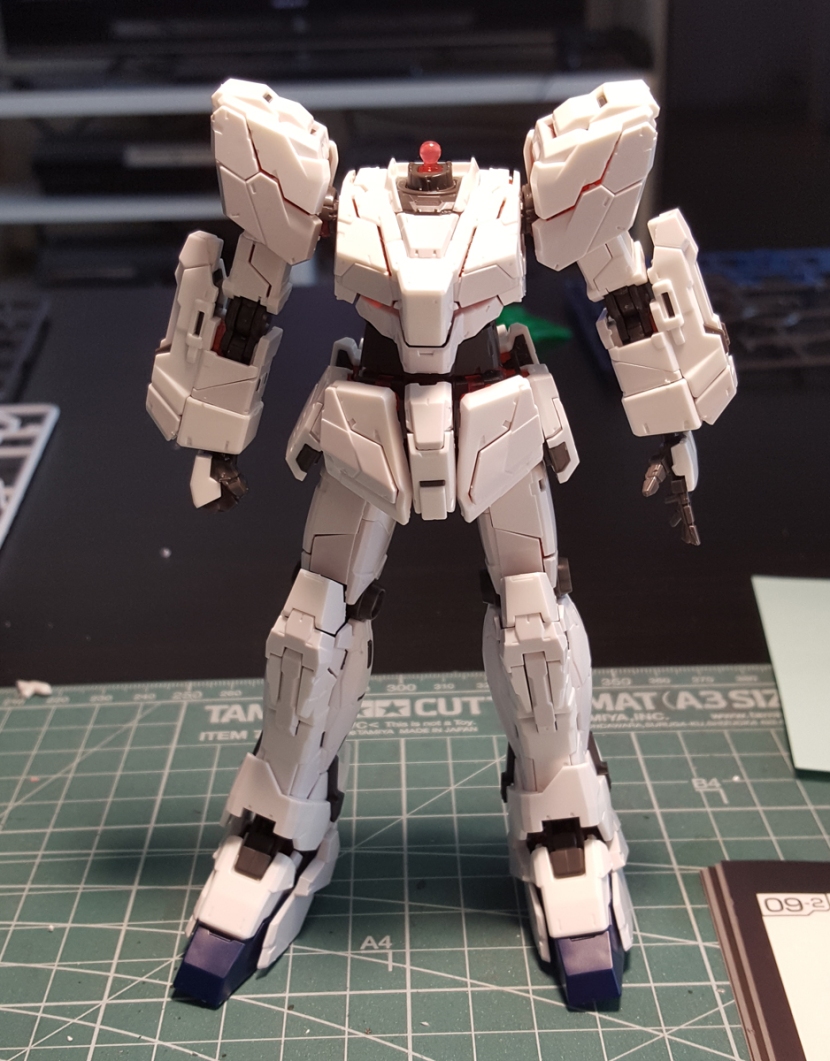
The head isn’t as complicated as you’d think. Clearly they decided it just wasn’t going to be possible to have it “transform” so much as be disassembled and put back together, which is pretty much how the transformation works.
The kit comes with foil stickers for both sets of eyes and the cameras. As you can see, the cameras are molded in clear green, so there really wasn’t any need for those stickers, but I did use the one for the eye slit in Unicorn mode to make it pop more. Plus obviously the one for Destroy mode.
Note also that the transforming horn works quite well in this version. You usually have to wiggle the halves around a bit to get them in place, but there’s hardly any visible gap. Hard to say if that’ll still work with the foil stickers for the gold side on there – I didn’t use them here as I’ll probably paint these parts. I do think I’ll be using the transforming horn, though. It works fine. Which is, of course, pretty amazing.
No proper slits on the face mask in Destroy mode, though. That’s a pretty disappointing omission.
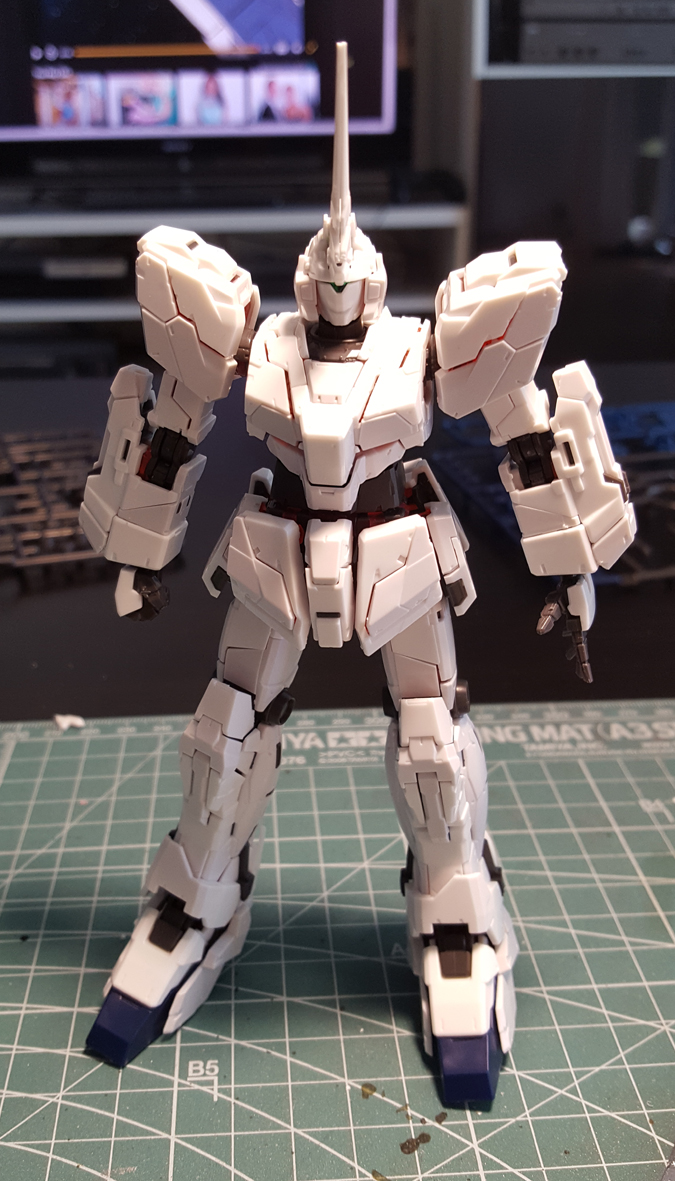
And here’s your Beast of Possibility sans backpack. You see that gap on the horn? Yeah, me neither.
From what I remember, the backpack is basically the same as on the MG. The big difference being that you can actually transform it without the beam saber handles popping off. It should be pretty obvious from these pictures that that comes at a cost, though – the proportions are very different as the handles and the parts they’re mounted on are much, much bigger compared to the backpack than on the larger scale versions of the suit.
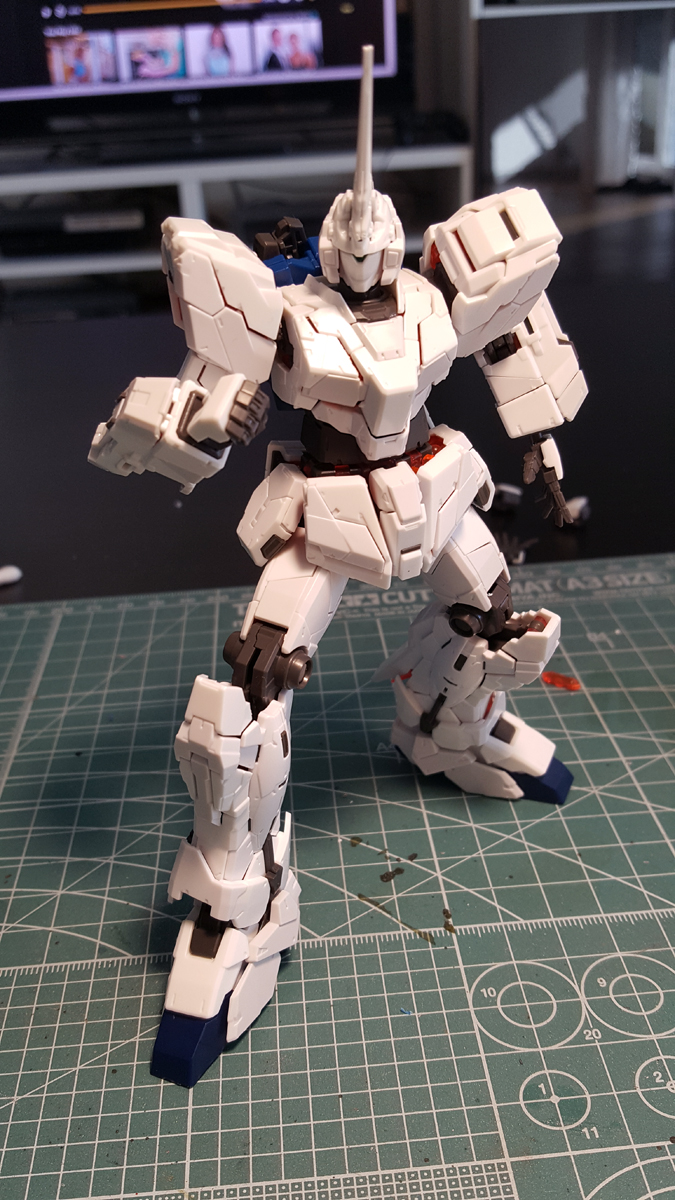
And here we are, about to heave the customary “now for the accessories” sigh.

Here’s what you get, aside from the aforementioned hand options. No surprises, of course – there’s the shield, the magnum, the bazooka and a (very strong) action base adapter. I’m also convinced at this point that the whole thing where the Unicorns almost all come with four sabers and only two effect parts is some sort of in-joke at Bandai because whaddayaknow, they did it again. Also, no spare ammo clips for the weapons, though you can mount the ones they do come with on the rear skirts.
The weapons, as you can see, are basically scaled-down versions of their MG counterparts. There are very few alterations, like the fact that the ammo clip for the magnum isn’t made up of individual shells, but for the most part, they’re the same.
What really frustrates me about this is the fact that for some reason, all these parts come on the same sprue and are molded in the same color. Color separation is a big part of what sets the RG line apart from others, but for some reason, they decided to make these weapons just solid lumps of grey even though they’re made up of enough parts to allow for something more interesting.
Sure, you can paint all that, but this is an RG kit, it’s not supposed to need painting.
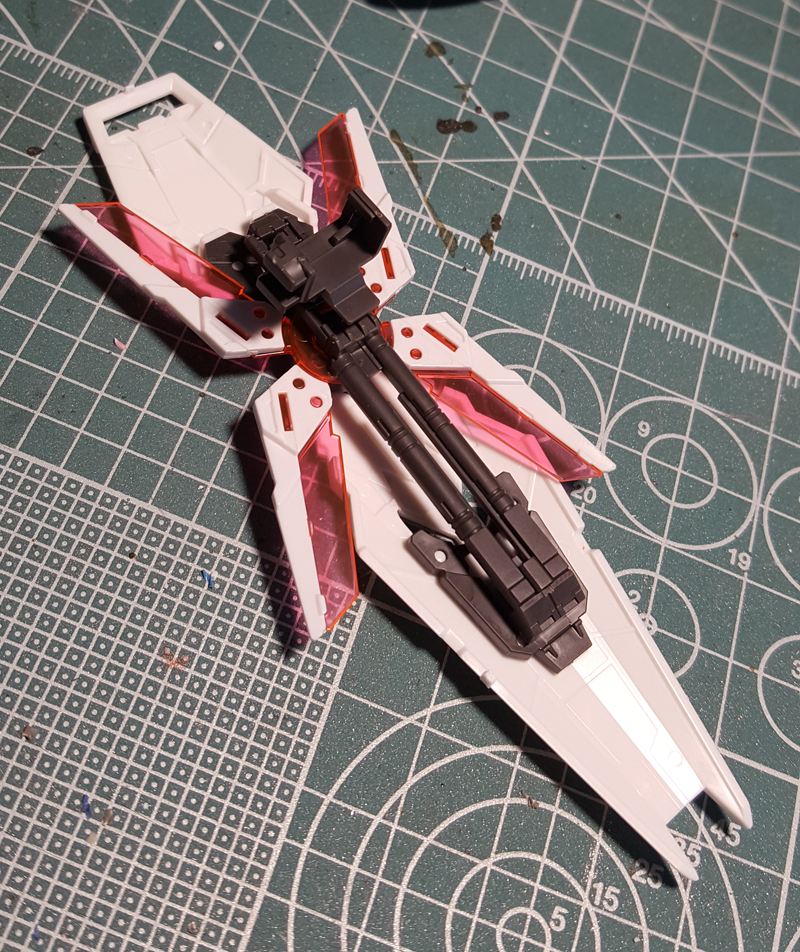
The shield is basically the same as the MG shield. Lots of parts underneath. I’m not a big fan of the way it attaches to the arm, though, it ends up being too far away from it. You also can’t attach it to the back for some unfathomable reason.
Well, and that’s it. I’m not doing a full-blown photoshoot just yet because I still need to sticker this kit and I’m thinking I’ll make an exception and actually panel line it as well – I never do this with RGs because I think they look cluttered as it is, but I think this one could use it. Anyway, as you can see, the kit can actually do a full split and it can almost pull off the Seed pose, though the feet won’t quite move enough.
So does this kit live up to the hype? For the most part. When it was first announced, everyone basically expected it to be the ultimate RealGrenade, and instead it’s now the sturdiest, most poseable and most easily transformable kit of the Unicorn in existence. And it’s a really fun build too, at least if you like ’em complex – it took me something like 7-8 hours to put it together, but just because there’s so many parts. Except for the shoulder armor, it’s not difficult or frustrating at all, just time consuming.
But is it perfect? No. Sorry. No, it’s not. First of all, it still has parts that pop off when you transform it, especially around the knees. Secondly, while poseability is certainly fine, a lot the joints are too tight for their own good. I’m terrified I’ll break something everytime I move the arms, and it makes posing the kit kind of a chore.
And thirdly, I really think the transformation comes at something of a cost to the kit’s appearance. The proportions are clearly off because they had to cram so much into such a small-scale kit – everything feels too bulky, especially the shoulders and the lower halves of the arms. This is especially odd because the legs are actually more or less accurate, and you’d think that would be the hardest part to get right.
The bottom line is, though, that this certainly is a step up in engineering for Gunpla, and I’m as amazed as anyone that Bandai pulled it off. This really wasn’t supposed to work. So if you’re a fan of the Unicorn Gundam, I’m afraid I have to tell you you’ll need this one as well, along with what I have to assume is several others that you already have. It’s a really special kit, and you kind of have to build it to believe it.
Real Grade Gundam Mk-II A.E.U.G.
So here’s the deal with me and the RG Mk-II, okay. I fucking love this kit. I literally jumped online to order the Titans version within an hour of finishing the A.E.U.G. because I had so much fun that I wanted to do it again. And aside from it being an extremely fun build, the end result not only looks fantastic, but it’s also really sturdy and ridiculously poseable. It’s just an all-around near perfect kit. Definitely my favorite RG that I’ve built and also among my favorite Gunpla kits in general.
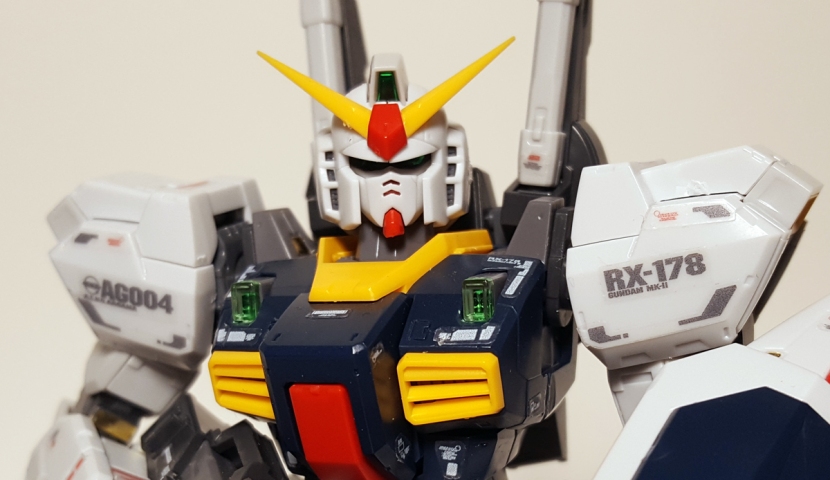
The only thing I’m not crazy about is the stickers, but more on that later. Let’s do that thing where we discuss the build first.

The number of parts is about what you’d expect – not as crazy complex as the Sinanju, but slightly more than the RX 78-2, though that’s mostly because of the accessories.
One peculiarity of this kit is the cloth tubing for the legs and the backpack. There’s a length of hose made out of cloth that’s kind of like a shoelace, which… isn’t as stupid as it sounds in theory. Along with it you get some coated wire that goes inside of the cloth hose and helps it hold its shape.
The instructions tell you how much of the hose and wire to cut off for the various sections where it’s used, though you don’t have to be super fussy about this – I ended up with well over a centimeter left of both, so my advice would be err on the side of cutting it a little longer rather than shorter because if it’s too short it can pop out and you have enough to add half a millimeter here or there.
I’m not crazy about this – it looks okay, but I prefer coil springs for this sort of thing, and the cloth hose tends to get frayed really quickly if it takes you more than one attempt to get it where it’s supposed to go. All of that ended up hidden away inside the parts, but it was kind of annoying and one of the few parts of the build that are a bit fiddly.
Unlike the other RGs that I’m aware of, you then build the entire inner frame first. This is done with the usual limbs that come pre-molded on the B sprue plus regular grey plastic parts, as seen above for the legs.
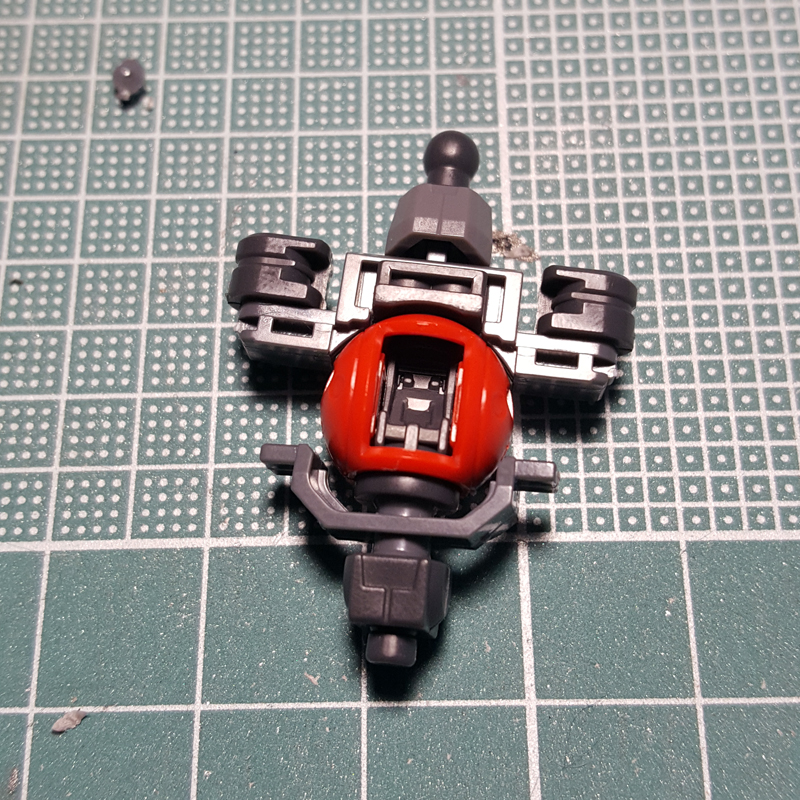 For some reason, the sphere for the panoramic cockpit is red on this one. It’s a bit difficult to tell what you’re looking at here, but there’s a fully detailed cockpit seat in there, as with all the RG kits, and also as with all of them, there’s no seated pilot figure, but only a standing one. This will never not be odd to me.
For some reason, the sphere for the panoramic cockpit is red on this one. It’s a bit difficult to tell what you’re looking at here, but there’s a fully detailed cockpit seat in there, as with all the RG kits, and also as with all of them, there’s no seated pilot figure, but only a standing one. This will never not be odd to me.
When the inner frame’s all built up it’s very solid and ridiculously poseable, of course. I snapped the picture of it doing its best Jean-Claude Van Damme impression thinking this probably wouldn’t be possible anymore when the armor’s on, but surprisingly enough, it actually still works with the completed kit.
One thing about the inner frame that I just couldn’t stop giggling about is how the chest looks like a face with a shocked expression. Here’s a little draw-over to show you what I mean. You can now never un-see this. You’re welcome.
I know, I’m a monster. Anyway, after you finish Shockeyface the Anorexic Cephalopod, you just slap the armor on it from the bottom up, starting with the feet and legs. As you’d expect, the leg armor doesn’t restrict movement at all and the knees actually bend about 180 degrees. I’m starting to think I can stop taking this picture of every RG I build.
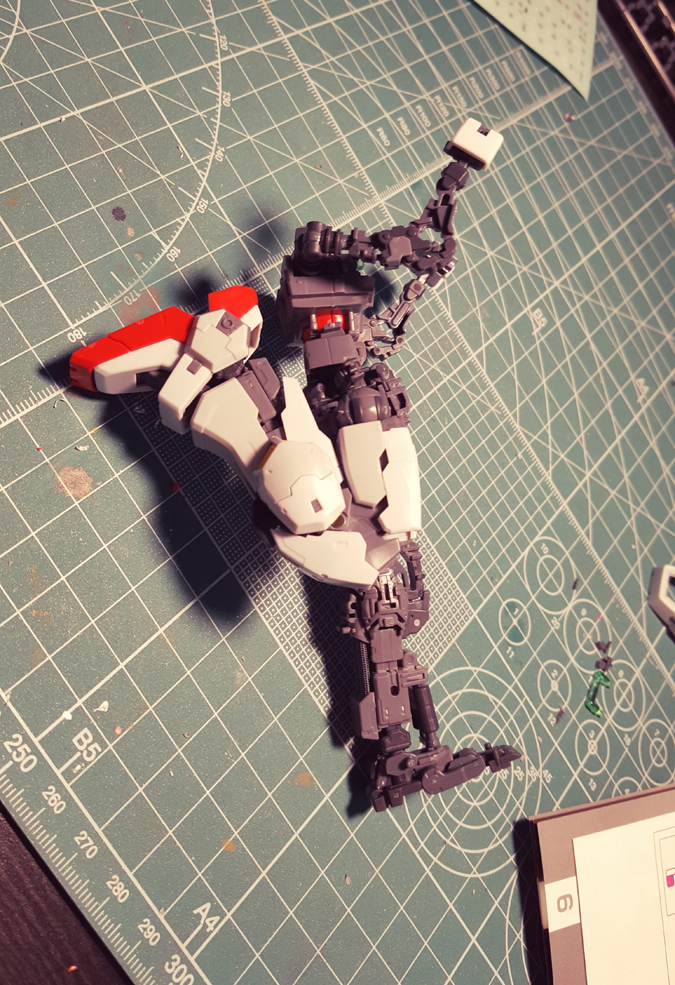
Up next is the waist, which is quite an involved build, as you can see. The side skirts consist of two pieces each and are actually already assembled here because I decided that I wanted to show just how many parts there are for the skirts after I’d already snapped those together. Each individual skirt has a dark grey inner part, so they look really nice, and more importantly, the way they attach to the inner frame makes it almost impossible for them to randomly pop off while you’re posing the legs.
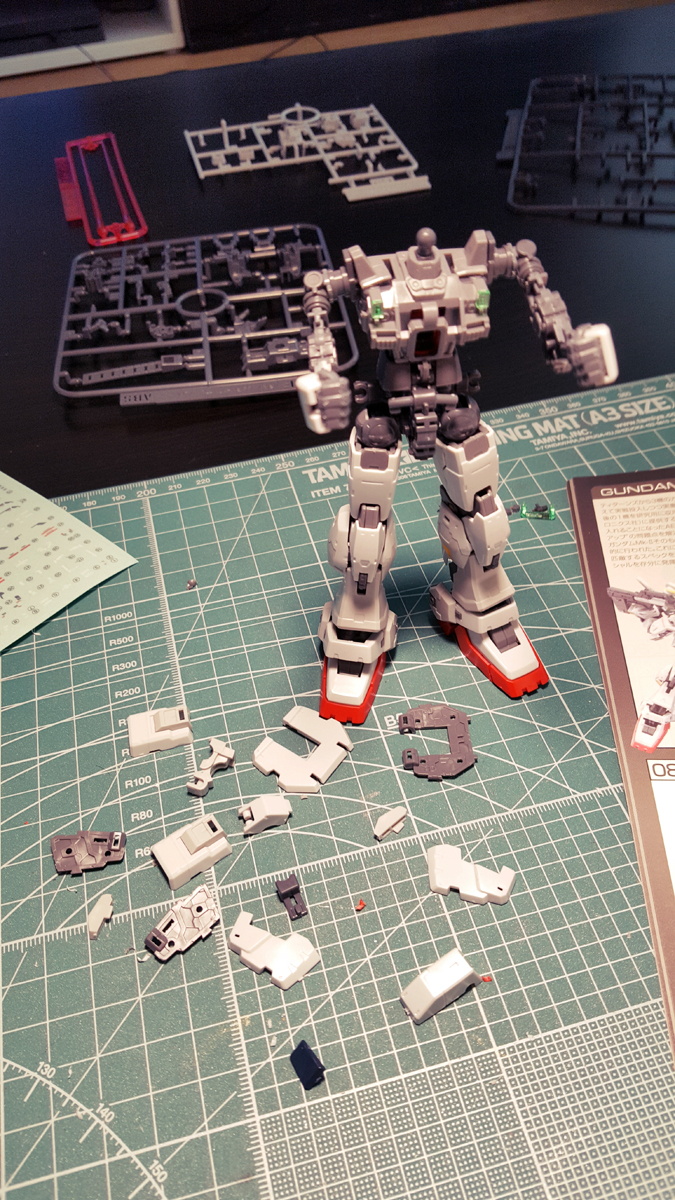
The skirts go on like so. Actually there are two parts missing for those grills on the front here, one of several dumb mistakes I made during this build that are now documented on the internets for all eternity. Shockeyface was clearly shocked by what I’d done and I didn’t even realize why he was flailing his arms around when I took this picture.
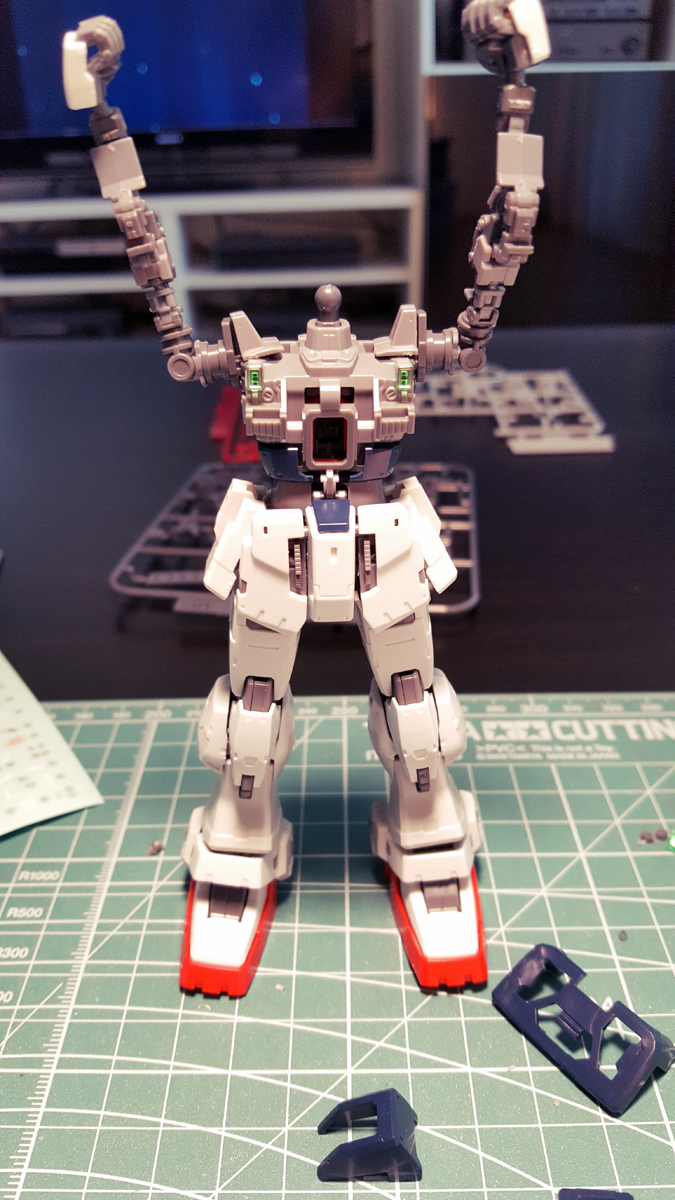
Unsurprisingly, what follows the skirts is the chest. Nothing too unusual going on here. There’s an opening mechanism for the cockpit, of course, and mobility stays pretty good even with the armor on.
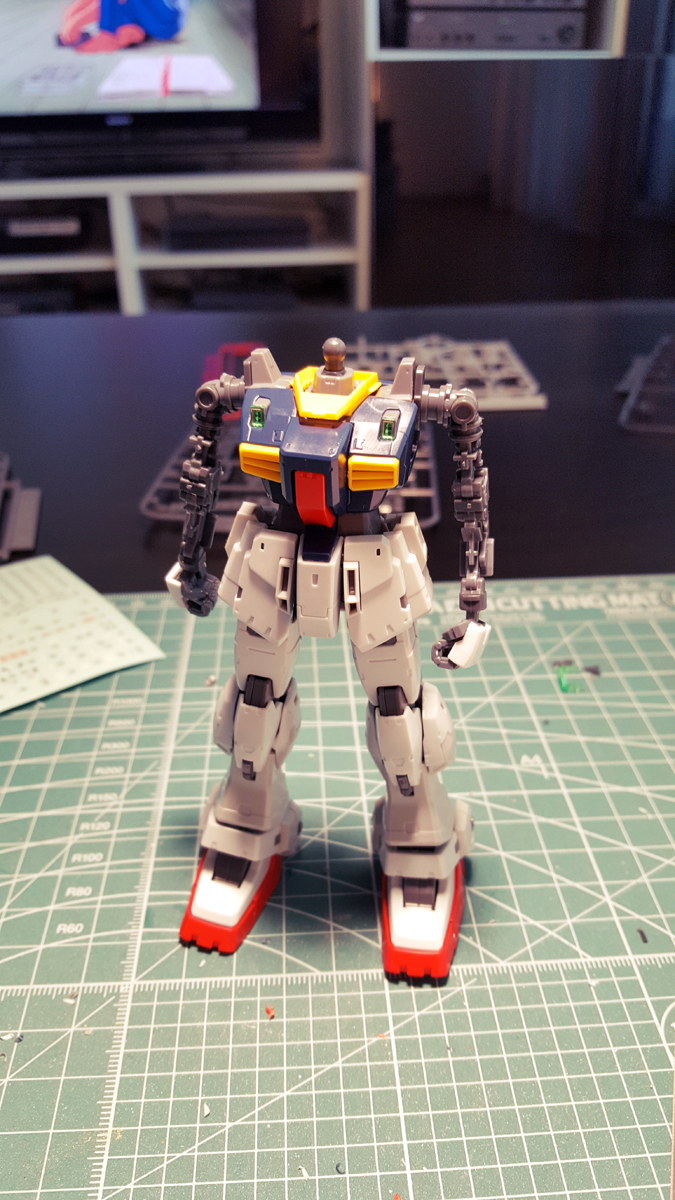
Up next are the shoulders and the arms, all of which don’t really consist of more parts than absolutely necessary, and then you’ve got yourself another Headless Hessian. I do love that bulky shoulder armor.
I actually took the following picture of the head because it’s just a regular part of my build documentation and because I wanted to show that there’s no sticker for the forehead camera. Since the clear piece sits inside a white shell, it actually pops very nicely without a sticker or any painting.
What you’ll notice, though, is that the head halves don’t seem to fit together very well. That unsightly gap between the camera and the v-fin isn’t supposed to be there. I later pried the head apart again to see if there was a nub getting in the way, but it turned out that I had, ahem, put the armor on the cameras on backwards. And I’m totally showing you this because I like to embarrass mys… I mean, so you won’t make the same mistake. Yeah, that’s it.
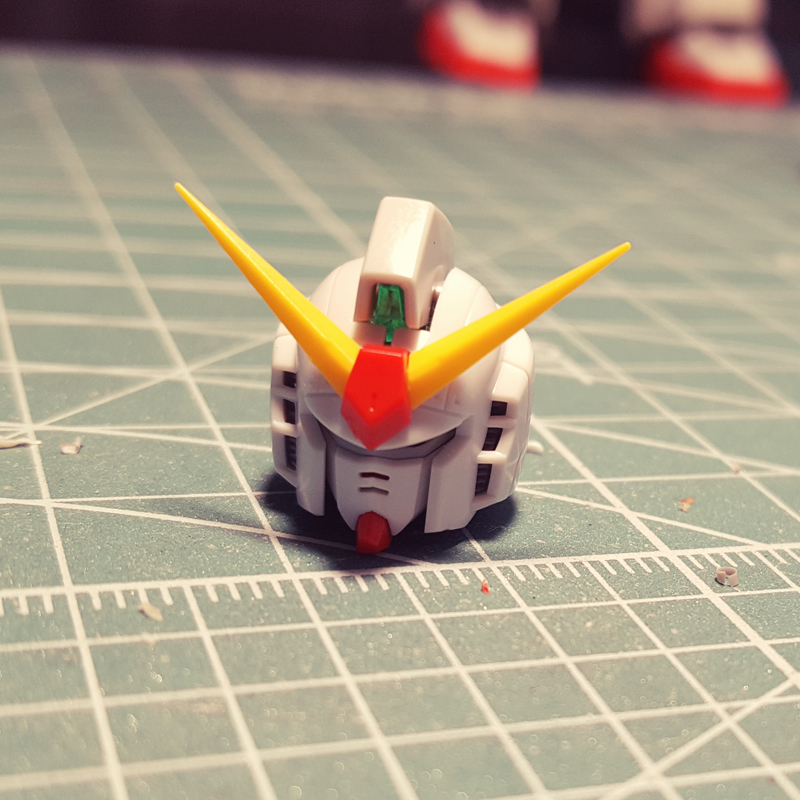
Finally, we have the backpack. More shoelace tubing here, as you can see, and those thrusters are the one thing on this kit that just. Will. Not. Stay. Attached. They’re mounted on tiny little balljoints, and the moment you put them on you can tell from the complete absence of resistance or a clicking noise that the only thing holding them in place is your belief in miracles.
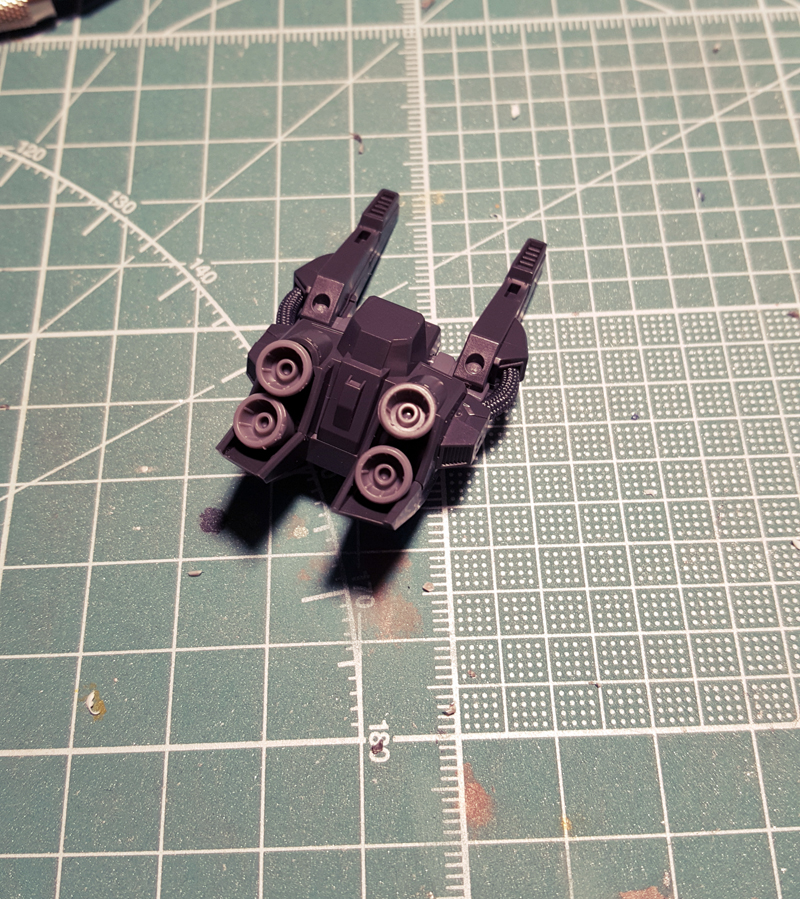
I should probably just glue these thrusters on – there’s really no need for them to be “poseable” anyway.
Another minor issue I have with the backpack is that it looks ugly without the beam sabers on, like they forgot to add detail to those areas. I do like that there’s a little slot there for the peg, though, so you can put the actual beam sabers on there that also fit into the hands and not dummies like on the RX 78-2. I took a second picture with the beam sabers and some other accessories to show how much better it looks with the sabers in there.
Now before I move on to the accessories and the posing pictures, a word about the stickers. If you’re like me and you like to use a lot of stickers on your RGs, you’ll want to do this during assembly and not when the kit’s finished. There are a lot of sections to it that are difficult to take apart after the fact, and holding the entire kit while you’re trying to get stickers on it that are barely a square millimeter in size is a massive pain. And there’s a lot of small stickers. Obnoxiously small ones. Like I said above, that’s my only real serious complaint with this kit.
The RX 78-2 also has a lot of stickers, but they’re all shaped to very clearly fit on certain areas of the kit, so they’re not difficult at all to apply. In fact, I think I was talking on Skype the entire time I was slapping the decals on that one – that should tell you how easy it was.
With the Mk-II, though, I almost went insane. Some of these things seriously feel like they’re the size of a slightly oversized grain of sand. And the foil stickers damage way too easily, to boot. It’s just puzzling. They clearly had this dialed in with the first kit in the line, but it’s like then they forgot what works and what doesn’t – the Sinanju, you might remember, has questionable stickers as well.
There’s some really nice ones here too that enhance the shapes and the detail, and you’ll notice I actually used a lot of the foil stickers for once, but there’s also like 50 tiny ones that you’ll just want to murder someone for. Unless, you know, you’re not like me and you’re fine with just not putting them on.
Anyway, enough about that, let’s talk accessories. Here’s what you get.

There’s the collapsible shield, the vulcan pod for the head, the beam rifle with four ammo clips (and a camera that folds down and never stays up), the bazooka, also with a spare ammo clip, two beam sabers with effect parts, two closed fists, two articulated hands, a trigger finger hand for the rifle and a fixed-pose open hand. Plus the customary standing pilot figure and an action base adapter that works really, really well.
The spare ammo fits on the side skirts and the shield, and the bazooka attaches to the rear armor, making this a Gundam that can actually carry all of its accessories, which I always appreciate. I’d also like to stress the fact that the hand options are done right here. I know I’ve probably said this too many times at this point, but I don’t like the articulated hands, and it’s really nice to have these fixed-pose ones included. Although the closed fists still look weird.
Where this kit really shines for me, though, is when it comes to posing, whether it’s on its own two feet or on an action base. It actually stands up really well, but as you can see, I had way too much fun with the action base, ahem. And “fun” is really the operative word when it comes to this kit’s poseability. The only two minor issues I had were the aforementioned thrusters and the fact that, as usual, the articulated hands don’t hold the sabers particularly well. Other than that, you can just yank this thing’s limbs around and nothing ever falls off. Taking these pics was an absolute joy.
And most importantly, unlike the RG Freedom, which actually is a suit from Gundam SEED, the Mk-II can do the SEED pose and look good doin’ it. This shit matters, folks.
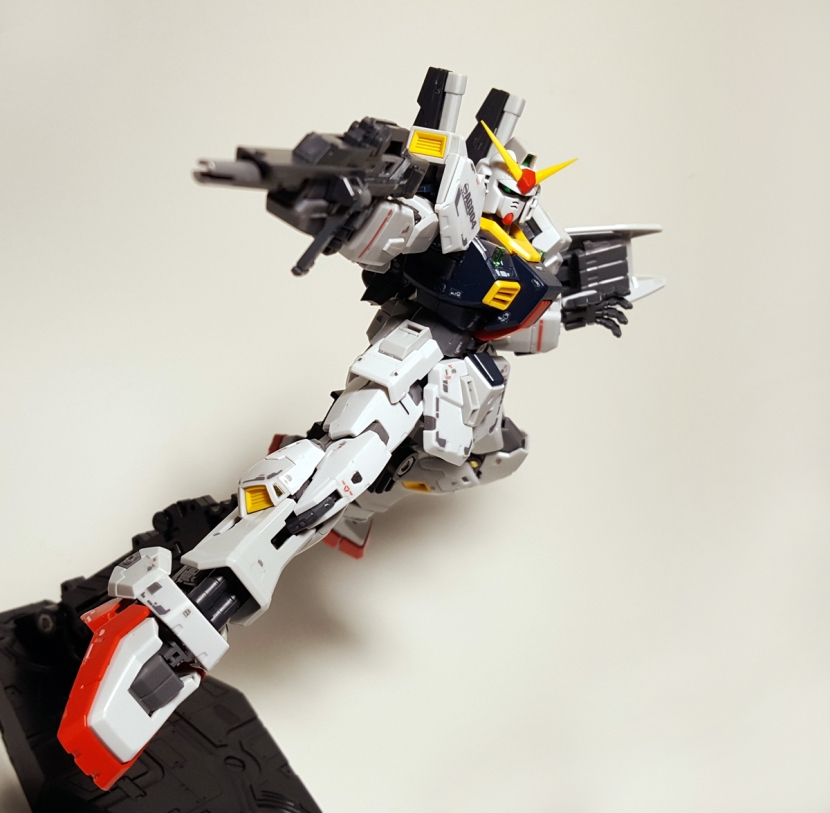
I know I’m just repeating what people have been saying for five years, but of course this kit is highly recommended. It’s fun to build, it looks great, and it just… works. If you can deal with the fussy decal sheet and the fact that maybe the thrusters could be more firmly attached, you’ve got yourself a piece of Gunpla perfection here.
This kit also accomplished what the RG RX 78-2 did for me in that it’s made me completely fall in love with the Mk-II Gundam. As I’m writing this, I’ve already bought and built the HG Revive version, and I have the MG and the PG versions on the way. In fact, I think the Mk-II may be my favorite Gundam now, and I’m very much afraid you’ll have to endure me gushing about it again when I post reviews of those other 3 kits. Probably no review of the Titans version, though, that’d really be kind of silly.
Real Grade Zaku II Char Aznable Ver.
Yep, we’re doing another Real Grade kit. I’m sort of on vacation, so I have to dig up something I wrote up a while ago and saved for a rainy day. I actually built this one the day after I completed the Death Stinger. Sort of… I dunno, to cure my hangover? Anyway, after the love-fest that my experience with the RG RX 78-2 turned out to be, I figured it only made sense that I add a Zaku to my collection (because I did indeed have neither, and that’s no way to live), but I have to say I’m not a big fan of this one.
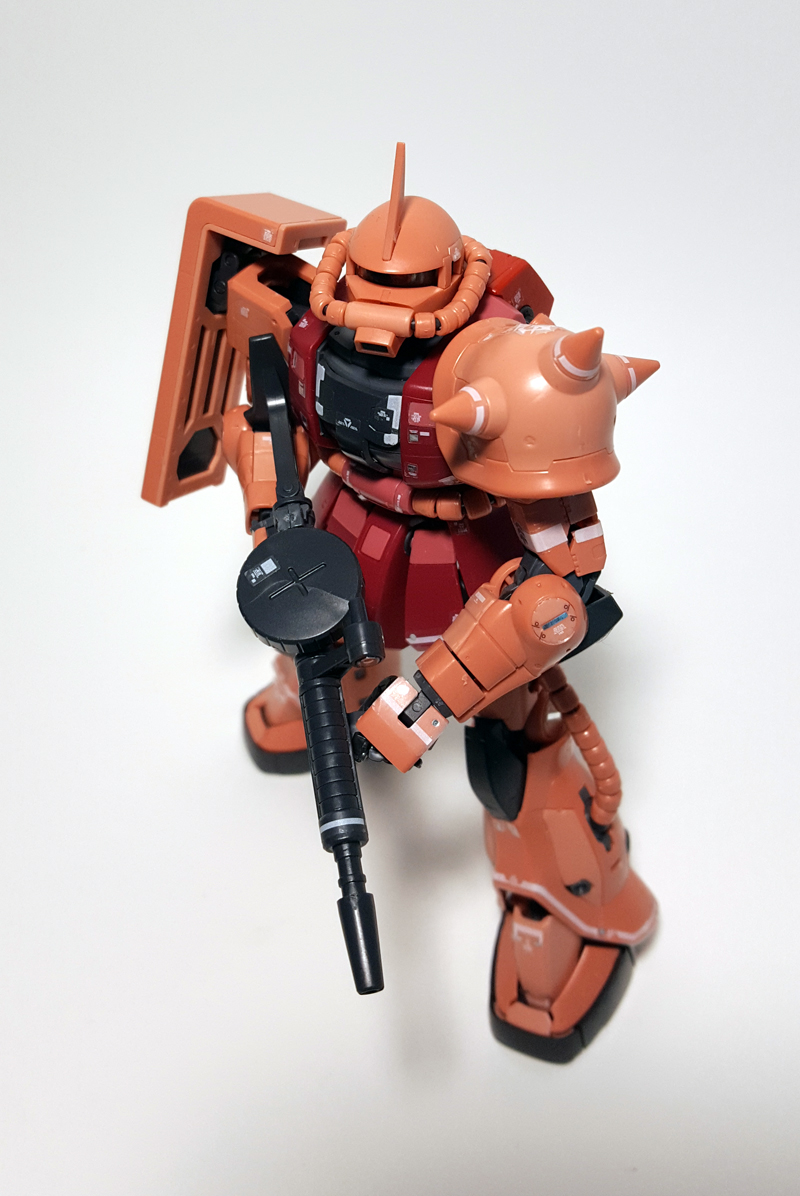
But let’s look at the build first. Here’s a shot of the sprues.

Being an early RG kit, the Zaku is relatively simple. You get the B sprue with the inner frame, three sprues of dark parts, plus four different shades of red and… I dunno, salmon pink or something, I guess. Like the RX 78-2 before it, the design of the Zaku relies heavily on adding color separation to create a more detailed impression, but it doesn’t work all that well here.
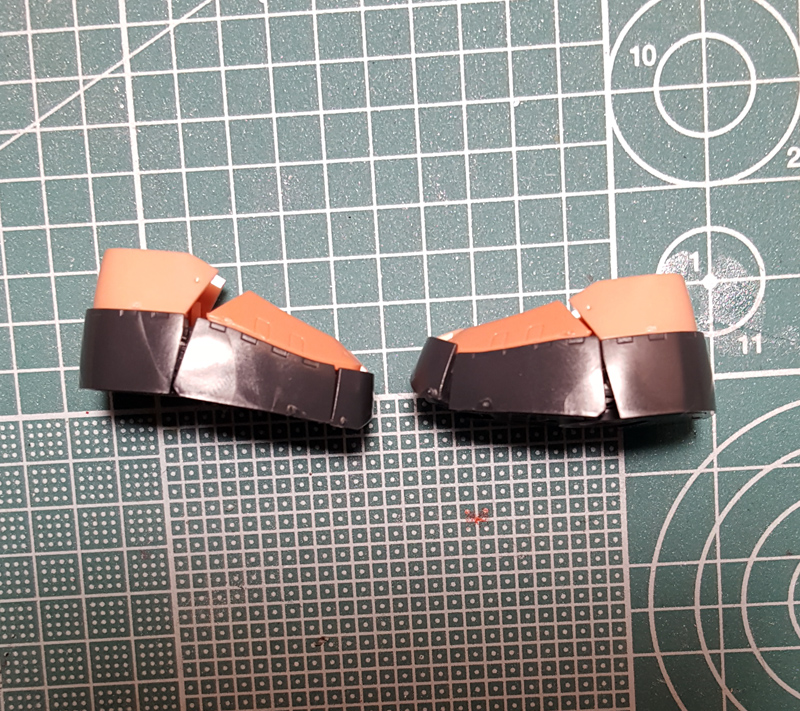
Shockingly enough, the build starts with the feet. Since the inner frame is the same as the RX 78-2, they’re also articulated in two points, as you can see, but you don’t get a whole lot of movement out of them.
The build then continues upward with the legs, as you’d expect. There’s a good amount of detail on these – each leg has five boosters attached to the inner frame that show through gaps in the armor. These boosters are insanely small, but they’re attached firmly, so there’s no issue with potentially losing them.
Articulation is excellent – the knee and upper thigh armor move to allow the leg to bend almost 180 degrees despite being covered in very bulky armor.

Up next is the waist, and then you can put it all together. More on the assembly of the various hoses later, but the ones for the legs here are round plastic parts threaded onto coil springs so as to be flexible enough to allow the legs to bend, and it works perfectly.
The side and rear skirts attach fairly well, but the front ones are on these tiny balljoints, and they pop off a lot when you’re posing the kit. That’s something I’ve kind of come to expect with Gunpla kits, though – I can’t think of too many where the skirts aren’t one of the most fragile sections. What I don’t expect is that the skirts are exactly the right length to get caught on the moving upper thigh armor when you’re trying to pose the legs. That’s just crappy engineering, and I’m afraid it’s very much the case here.
Next are the arms, which of course bend all the way up, and the shield and that silly looking Bowser armor piece, both of which are attached to the shoulder by means of a very simple hinge that consists of four ABS parts. One of the advantages of small scale models is that this sort of simple solution works just fine and dandy. Because it’s simple, it’s sturdy, and the shield moves every which way you want it to, so it does its job.
Then comes the torso. I’m really not sure why you build the arms first, there are other models where you can’t finish the torso before you attach the arm, but that isn’t the case here. Anyway, it looks really simple from the outside, but it’s actually super complicated somehow. Among other things, that’s because of the opening cockpit hatch on its left; as usual with RG kits, there’s a fully detailed pilot seat in there, but no seated pilot figure. You do get a Char Aznable miniature, of course, but it’s standing up.
Now about those hoses. When you first look at the sprue with all those hose parts, you pretty much break into a cold sweat, unless you’re some sort of sociopath who actually enjoys this sort of thing. Turns out, though, that Bandai at least tried to make this somewhat bearable.
What you do is, you thread the inner piece that holds the hose together through the rings, then either just break them off the sprue or cut them loose with a knife. I can’t read the instructions, obviously, but while it looks like you’re meant to just break them off the sprue (they connect in a way that allows this pretty easily), I’d still recommend using a knife. You end up with nubs that you’ll have to trim either way, but you can actually avoid some of them if you use a knife. For the torso and the head hoses, once you’ve threaded everything on the inner piece, you cut off the long straight part – that’s just there to catch the rings, so to speak. It’s all still pretty fiddly, but it certainly does save a lot of time.
And here’s the Zaku sans head. No separate backpack assembly, so the head is all that’s left. I also have no idea why that one elbow is facing the wrong way in this picture, by the way. I think it was past midnight at this point, so, um, yeah.

Now the head… ugh. The head exemplifies why this kit is a disappointment to me. I’ve always thought Zakus looked more silly than threatening, but I’ve also always liked the sort of retro sci-fi space Nazi look they’re clearly meant to evoke with the crude armor and the head vaguely resembling a gas mask, so there’s potential here. I was never too enamored with the RX 78-2 either, but the RG with its sharp, rich detail completely changed my mind. This kit, not so much.
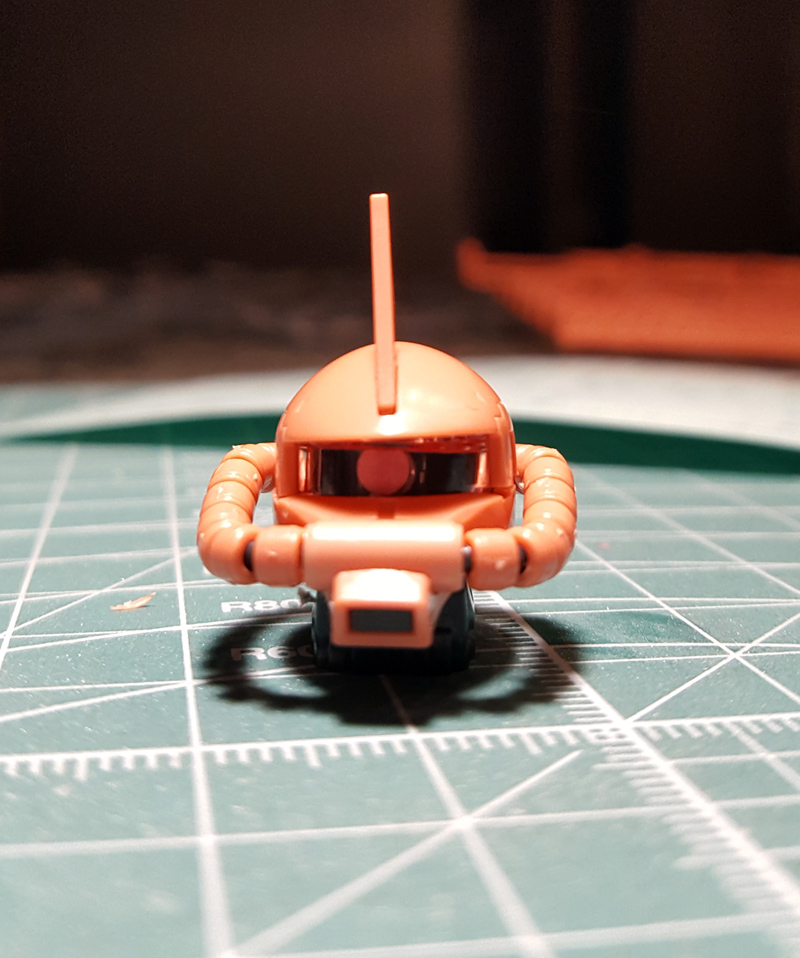
I’m sorry, but it’s a fucking upside down soup bowl stacked on top of a bunch of plumbing supplies. Where’s all the detail? There’s a few panel lines, and that’s it. I know this is anime accurate, but that doesn’t really matter if it looks like crap.
And the worst thing, clearly, is that sticker on the mono-eye. It’s even worse in real life, if you can believe it – it basically looks like a holepuncher clipping fell in there because it’s so dull and paper-like. I’m not exaggerating, it’s terrible. So much so that I broke my “no painting on RGs” rule the following day, pulled the head apart and painted the mono-eye (which is molded in clear plastic, mercifully, so it’s salvageable) silver on the inside and clear red on the outside. I know it’s supposed to be purple, and actually the flat purple circle here is exactly what it looks like in the original Mobile Suit Gundam anime, but, well, refer to “looks like crap” above.
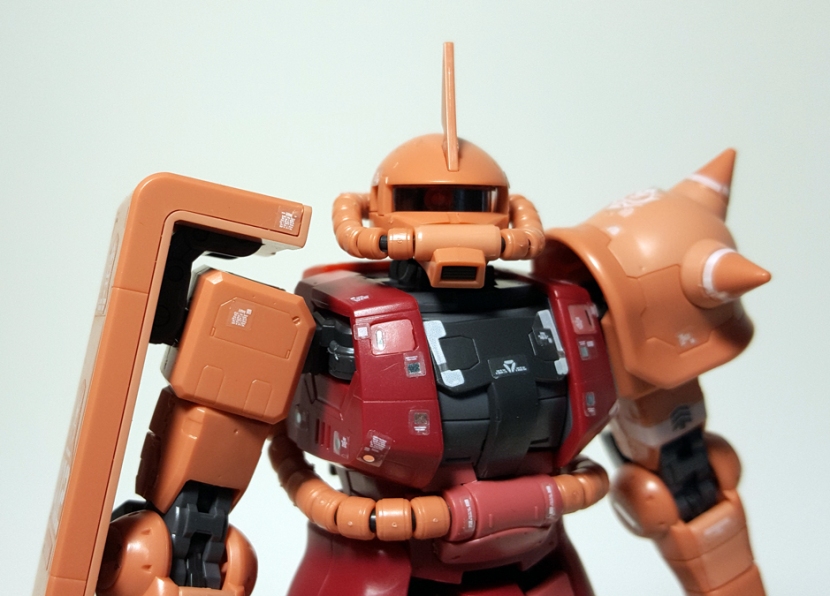
Here’s the result on the finished kit. As you can see, this didn’t work too well either. It’s preferable to the sticker, at least in my opinion, but of course now the problem is that it’s too dark and practically disappears. Sigh.
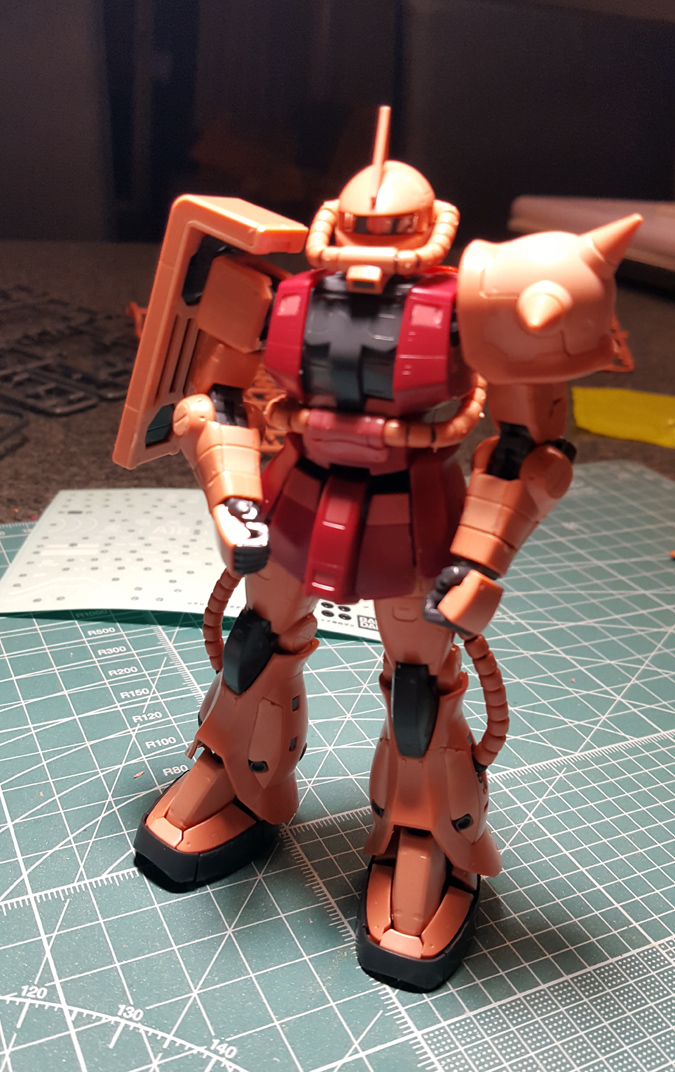
Anyway, to wrap up the build review, here he is all did up straight out of the box (including the aforementioned mono-eye sticker), sans decals and weapons. My camera somehow thought the legs were what needed to be in focus and I didn’t notice because it was late, ahem.
You don’t get a lot of accessories with this kit, but what’s there is solid. There’s the machine gun with that tommy gun style ammo pack, the bazooka, the Heat Hawk axe, two closed fist and two articulated hands, plus an action base connector (not pictured) and a clip to mount the Heat Hawk on the side or rear skirts. Detail’s good, but I kinda wish there were a few more colors to break things up a little; the RX 78-2’s weapons look a lot more interesting. They do fit on the kit much better, though – aside from the stock on the machine gun getting in the way, everything works really well, especially the way the handles fit into the articulated hand, which is the only serious problem with the RX 78-2. The only thing that doesn’t work is mounting the bazooka on the rear skirt. It’s supposed to clip on top of a part that folds out, but it doesn’t stay attached at all.

Also, the closed fists not only look weird, they also don’t match the articulated hands at all, so mixing and matching them to have a weapon in one hand and the other making a fist isn’t really an option. You’re pretty much stuck using the articulated hands at all times.
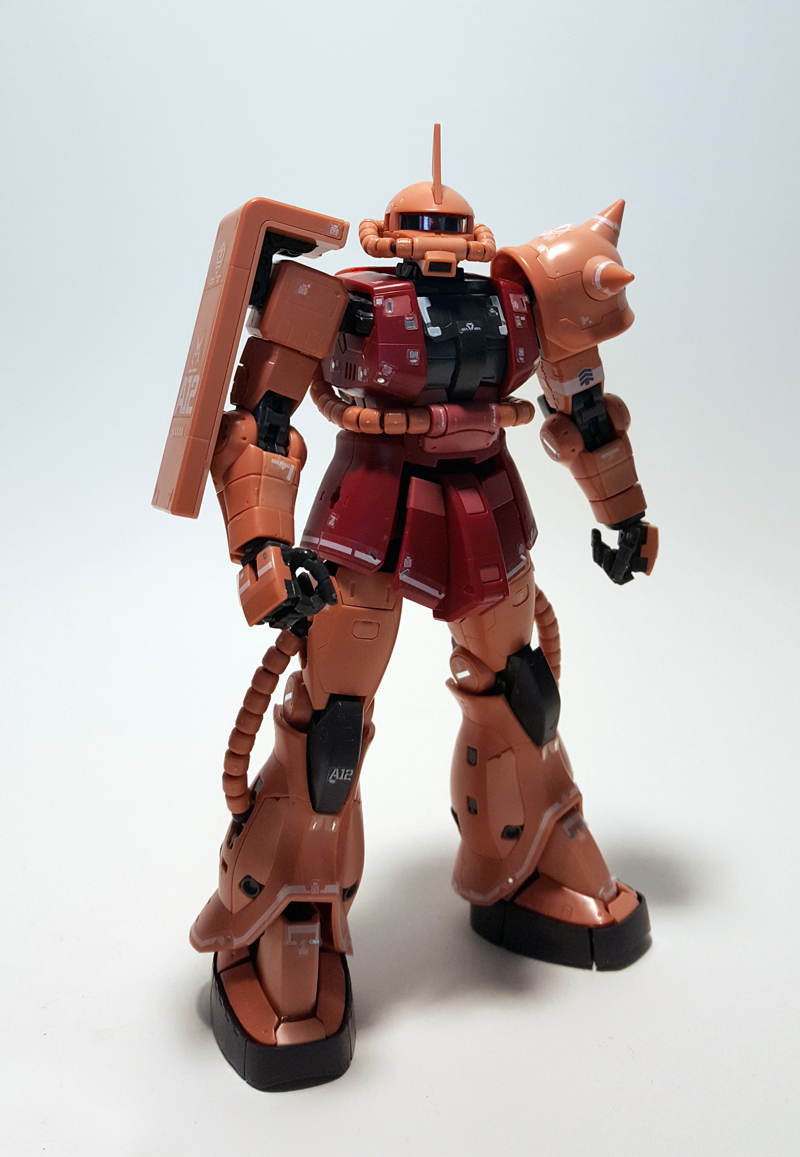
Like all Real Grades, the Zaku comes with a ton of stickers. Well north of 100, and I used most of them, except, as usual, the (shitty, shitty, no I won’t stop saying it, they’re shitty) foil stickers for the inner frame and some that were so tiny that I really found them impossible to apply. Like one quarter of a square millimeter and you get two that are close together and supposed to be lining up symmetrically? Nope.
Poseability is okay, I guess. You can get some fun poses with the various weapons, as you can see – though with hindsight, I don’t know why I took so many pictures with the bazooka. Except for the aforementioned problems with the front skirts, the kit is nice and sturdy for a Real Grade. I also like that little mechanism that makes the mono-eye move when you turn the head, but it’s hard to demonstrate here, especially with the aforementioned effect of my painting.
Overall, my verdict would be a resounding “meh.” Maybe I’m biased – like I said above, I’ve never been a fan of the Zakus. I pretty clearly remember the first time I was looking up Gunpla kits online, probably around ’99 or 2000, not knowing anything at all about the series, and thinking, you know, there’s some cool robots here, but these Zakus and Goofs or whatever they’re called, they look silly. And while I’ve now learned a thing or two about the Gundam universe and changed my mind about a lot of things, that really hasn’t changed. Zakus look silly. And this one’s pink. So it’s a silly robot in a silly color. I’m well aware that they tried to be faithful to the anime here, but if they updated the look of the RX 78-2 numerous times since then, why not the Zaku as well? I dunno, guys. I guess this is one problem with all things Gundam that I’ll always have.
Though of course now I have this idea bumping around in my head that I should get one of the MG Zakus and see if I can actually make it look good with some added detail and weathering.
Real Grade RX 78-2 Gundam
Yeah, um… remember how in my review of the RG Sinanju, I said I probably wouldn’t get any more RG kits? I bought this one like two weeks later. Basically the reasoning was that I really needed to have at least one version of the RX 78-2, and I wasn’t sure I was interested in actually devoting the time necessary to one of the MG versions, so I got this one.
Now the reason I’m writing this blog is basically that this kit changed my mind about both the RX 78-2 and the RG line. Because it’s friggin’ awesome. But it took me a bit to get there.
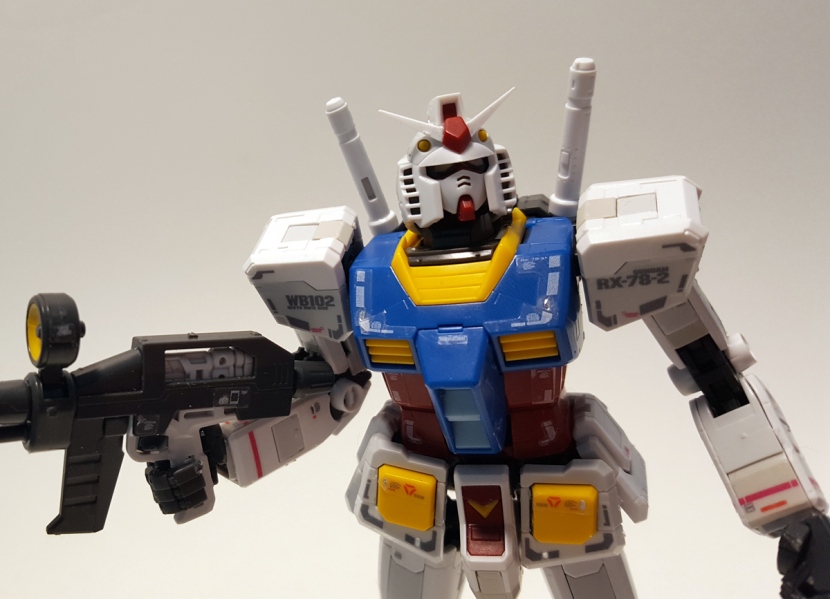
If you’re wondering why there aren’t any build pics here, aside from the fact that everyone and their grandmother already has this kit anyway, I really thought I wasn’t going to write about it at all. See, about five minutes into the build I applied a little too much pressure to one of the feet trying to clean up the panel lining I’d attempted to do, and the inner frame seriously just exploded on me. I screamed and I cussed and I fixed it with superglue, but at that point I pretty much had my mind made up that I hated this kit and wasn’t going to waste any time taking build pictures for a blog that I wasn’t going to write.
Until I completed it, and now I’m in love with the little guy. It’s just such a great looking kit and unlike others, apparently, I really also have fairly minimal issues with parts falling off – certainly compared to the rickety pile of flimsiness that is the RG Sinanju.
I’m not sure I’d say I enjoyed the build all that much – I still have the same issues that I had with the Sinanju in that I just don’t like working with these incredibly tiny parts, and this one has them in spades, much worse than the Sinanju, actually. It’s insane how small some of this stuff is – sometimes you really have to be careful not to lose a part among the sprue clippings on the table. And yet the detail is sharp and the end result looks fantastic. Just look at the core fighter. This thing is about 1.5 inches long, it’s fully detailed and transformable, and it looks excellent just out of the box. Actually it’s so tiny that I never realized that sticker on the left winglet had peeled off until I looked at it in this picture at about three times its actual size. Oops.
And that’s my segue to talking acessories. You don’t get a whole lot – the rifle, the bazooka, a beam saber with a peg that fits in the hands, two closed fists, and the shield. But it’s all really nice looking – again, just OOB like I’ve decided I’m building all of my RGs. You can also attach the bazooka to the back and the rifle to the shield, so the kit can actually carry both, plus the shield, and still have a hand free to wield the beam saber. Which, by the way, is ridiculously big. I could barely fit it into the picture.
My only complaint here is that the part on the shield that plugs into the arm is way too thin. There’s no friction at all, and it just falls out. It’s actually the hand holding up the shield here. If you want this thing to actually do its job, you’ll have to modify it.
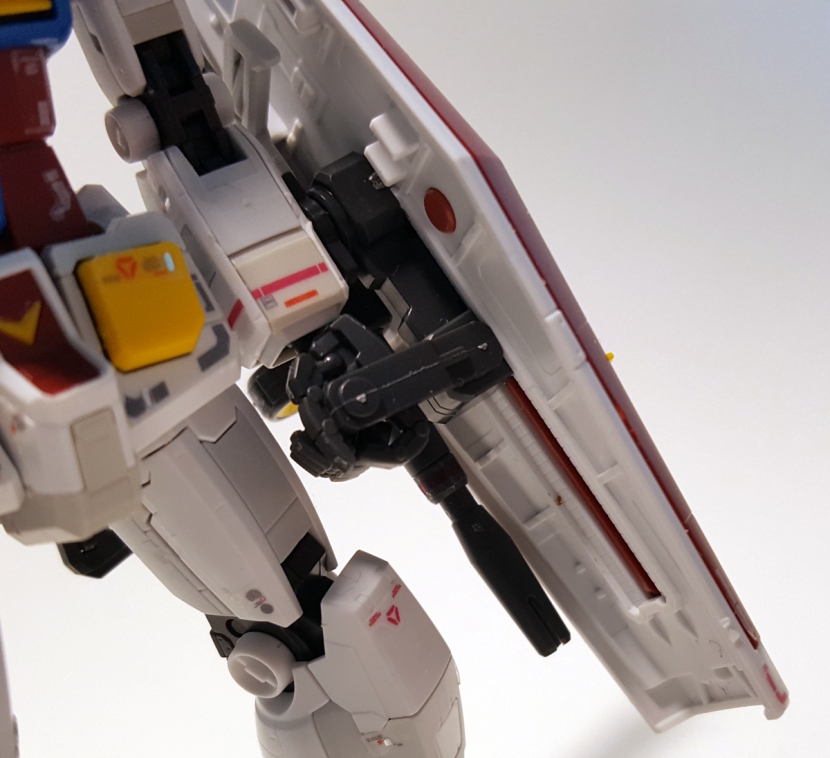
I didn’t use any of the regular foil stickers because fuck those (seriously, they do nothing but look ugly and yes, I’ll probably bring this up in every single Gunpla review), but the kit also comes with a whole bunch of regular clear stickers that have small foil sections that fit on various details. These actually look excellent, and of course because the armor is mostly white and other light colors, there’s also very little silvering. I ended up using all of the stickers on the armor, and between those and the effect of the different shades of off-white, the kit really looks so good that I just don’t feel like it needs any painting. It’s perfect the way it is.
This being the first RG kit, poseability is actually not all that great yet – as you can see, the arms and legs only bend a bit over 90 degrees, and I had a difficult time getting the suit to kneel for that bazooka pose. It’s perfectly serviceable, but not all that impressive. The limbs do already have the sliding armor parts that move out of each other’s way to improve poseability, though.
And I just have to stress again how great this kit looks. The detail is sharp, the proportions are just about perfect, the colors somehow make the simple color scheme look good, just everything about this thing is awesome. You’d think it shouldn’t be possible for a design that’s almost 40 years old to translate into a model kit that can compete with absolutely anything from the modern era of Gundam, but it can. And I don’t really have much of a nostalgic attachment to the original Mobile Suit Gundam show. This is just a damn awesome kit.
Building this kit has also convinced me that I need an MG RX 78-2, and obviously it has to be the 3.0 because I sure do love me the color separation with those different shades of grey and off-white. I may have to actually just build the kit and not do anything but do panel lines and clearcoat everything, but we’ll see what I think once I actually get it out of the box.
RG Sinanju
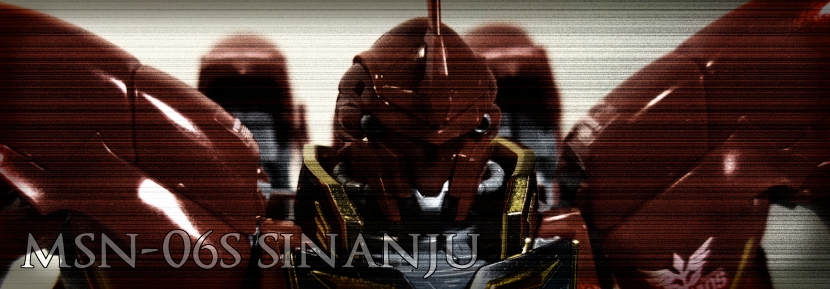
A few weeks ago I built the RG Sinanju, my first Real Grade kit. While I like it quite a bit, I can’t see myself really getting into the RG line. I just wanted something quick and simple after the momentous undertaking that was the PG Unicorn, and this kit was kind of an obvious choice. Like everyone else it seems, I’m a big fan of all the suit designs in the Unicorn storyline, and I was already planning to build the MG version of the Sinanju (which as of this writing I’ve actually completed, btw), so a quicker version of that suit that looks good just out of the box made sense.
If you’re like me and you’ve never built an RG kit before, the line is basically Bandai’s attempt to bring an MG level of detail and complexity to 1/144 scale models. Here’s a shot of all of the sprues laid out before I started, to give you an idea of what that means.
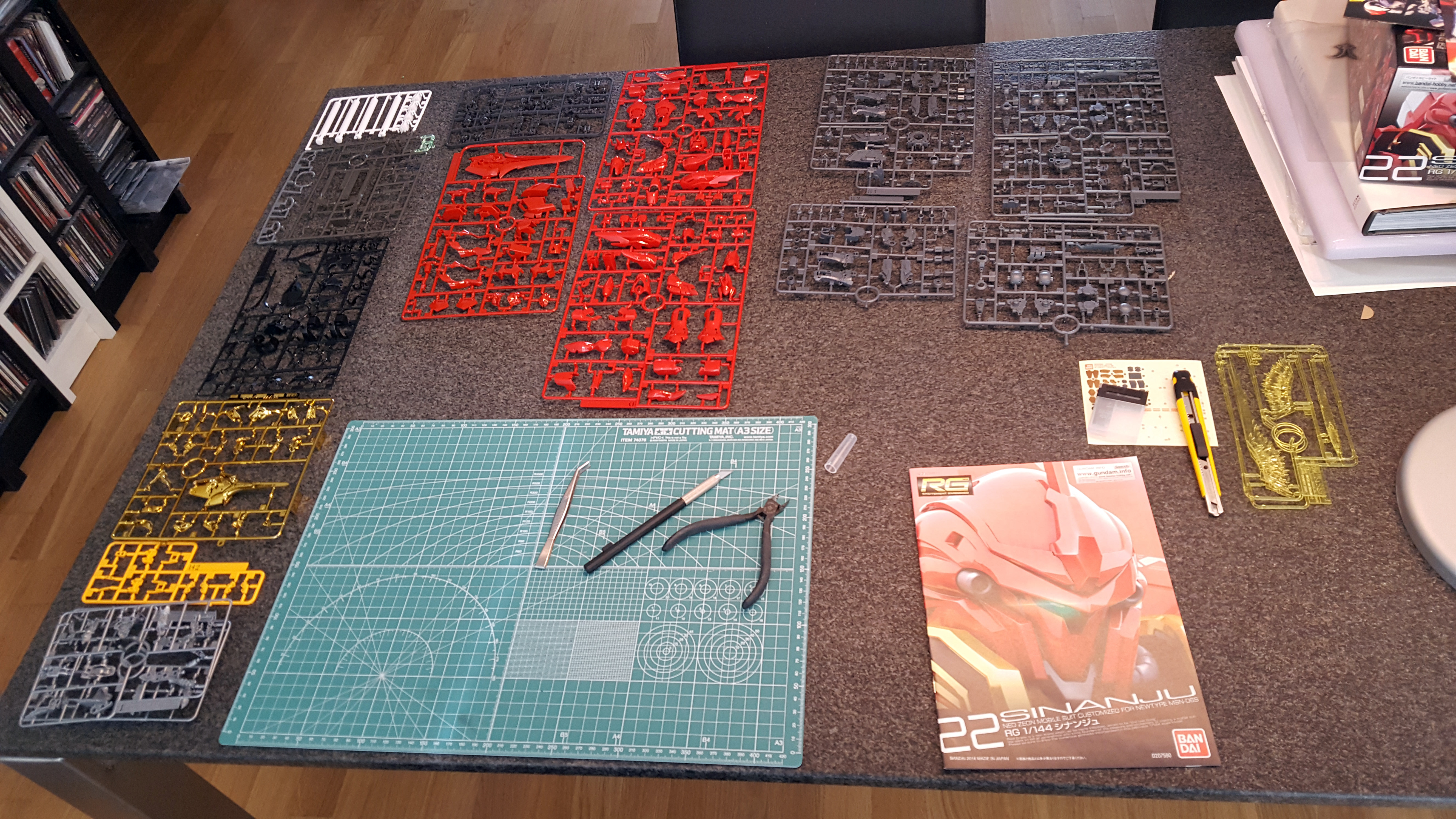
Yeah, you’d pretty much think I was building an MG if it wasn’t for the conspicuously small size of all those sprues. There are over 350 parts on this kit, and I’m not frickin’ kiddin’. The box is almost the same size as the box of the MG Tallgeese. Granted, that’s a small MG box, but again, keep in mind that this is for a 1/144 scale model.
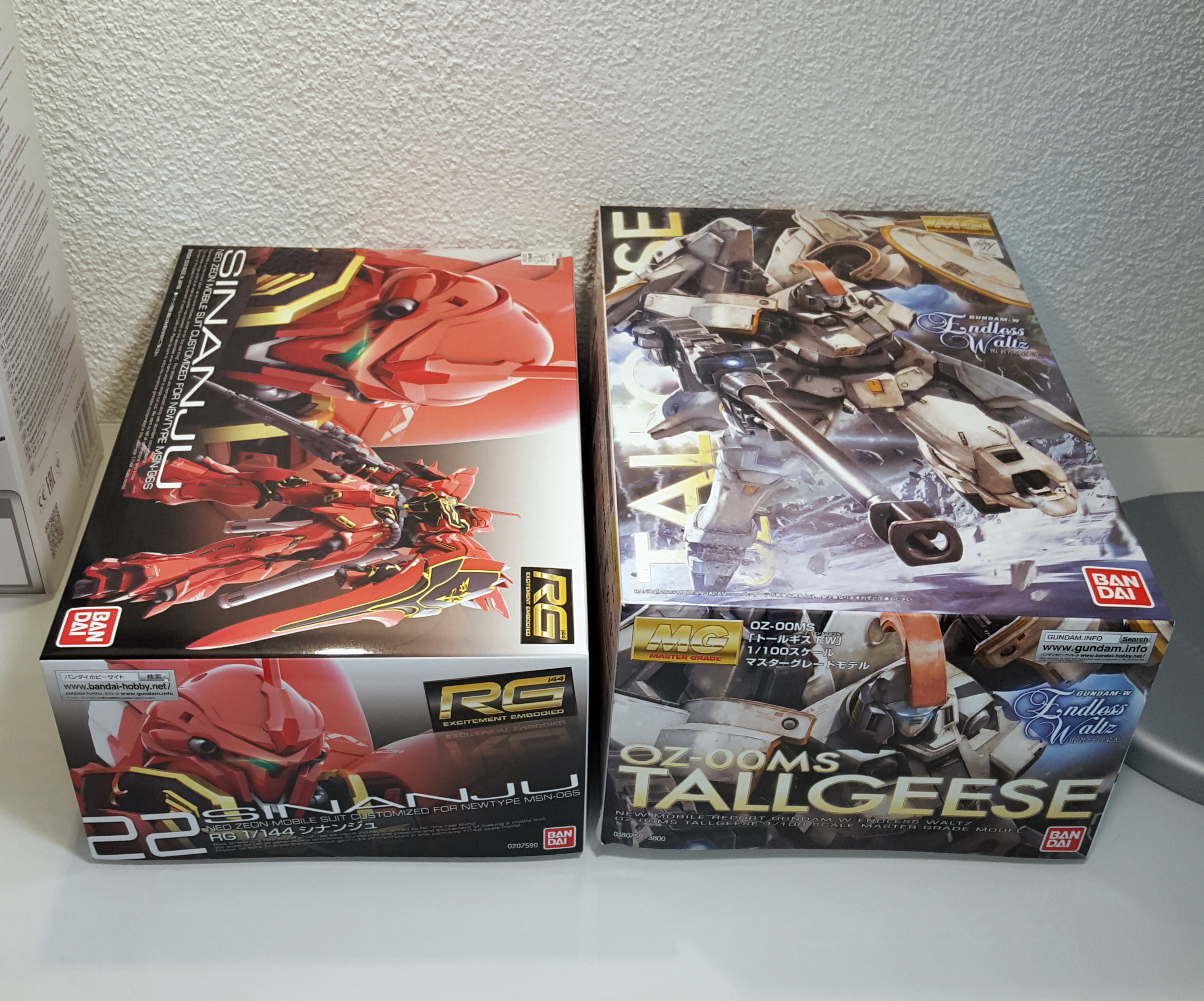
Also for the benefit of my fellow RG noobs, here’s a shot of the B sprue. Instead of polycaps, the RG kits have these parts that combine to form the inner frame of the suit. As you can more or less see, the entire limbs are on these sprues, joints and all. You may have seen what I assume is the same plastic casting technology in action with the more recent PG and MG hands that come pre-molded – here it’s the entire inner frame.
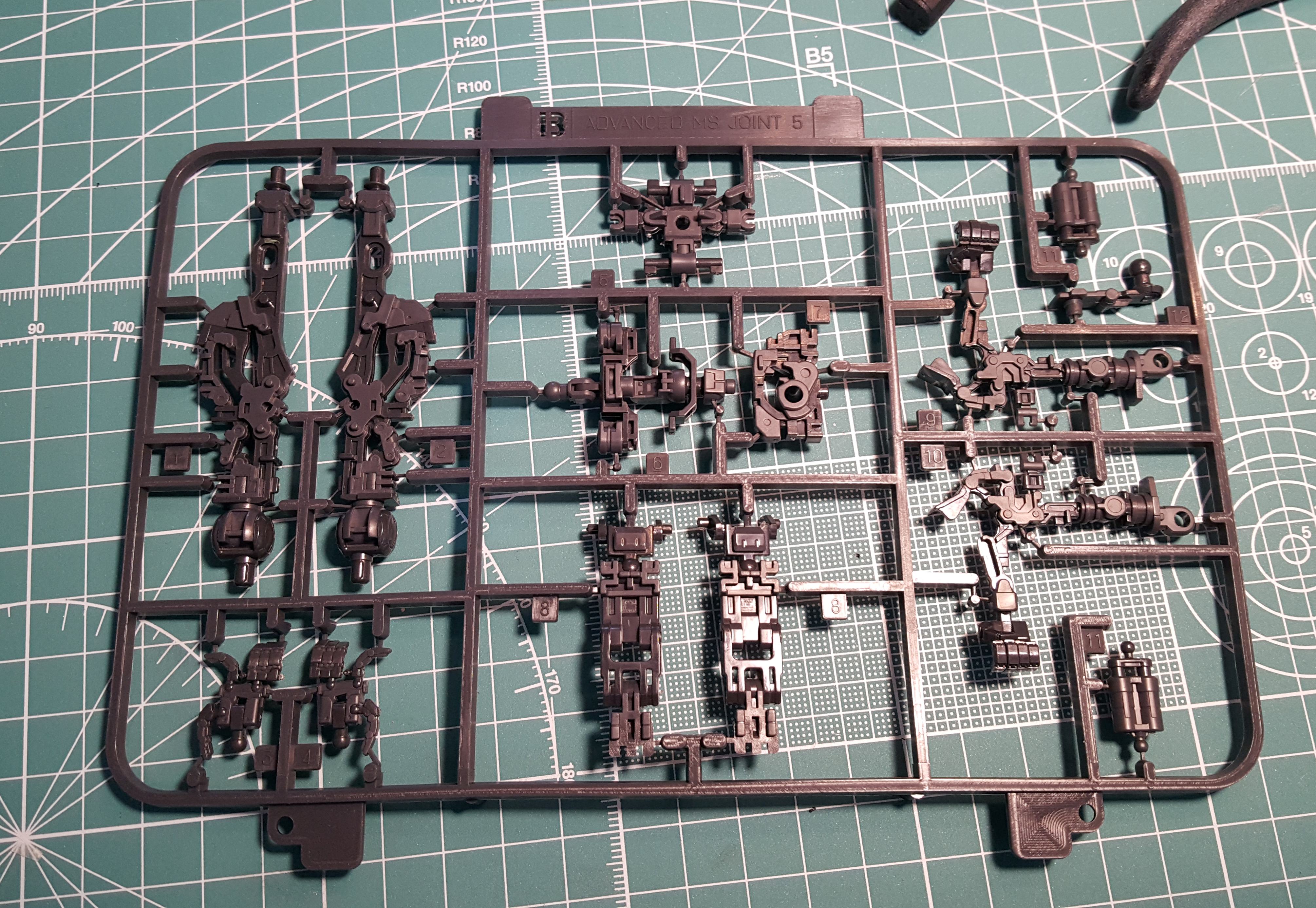
From a technological standpoint, it’s impressive, but I’m not sure how I feel about this. Since the build is still more than satisfyingly complex, it doesn’t exactly seem fair or reasonable to compare this to, say, the Murasame Liger in the Zoids line, but it does bring back unpleasant memories of that kit, and I hope the completely pre-built inner frames stay confined to the HiRM line.
Anyway, on to the build pics. You pretty much build the Sinanju from the bottom up, starting with the feet.
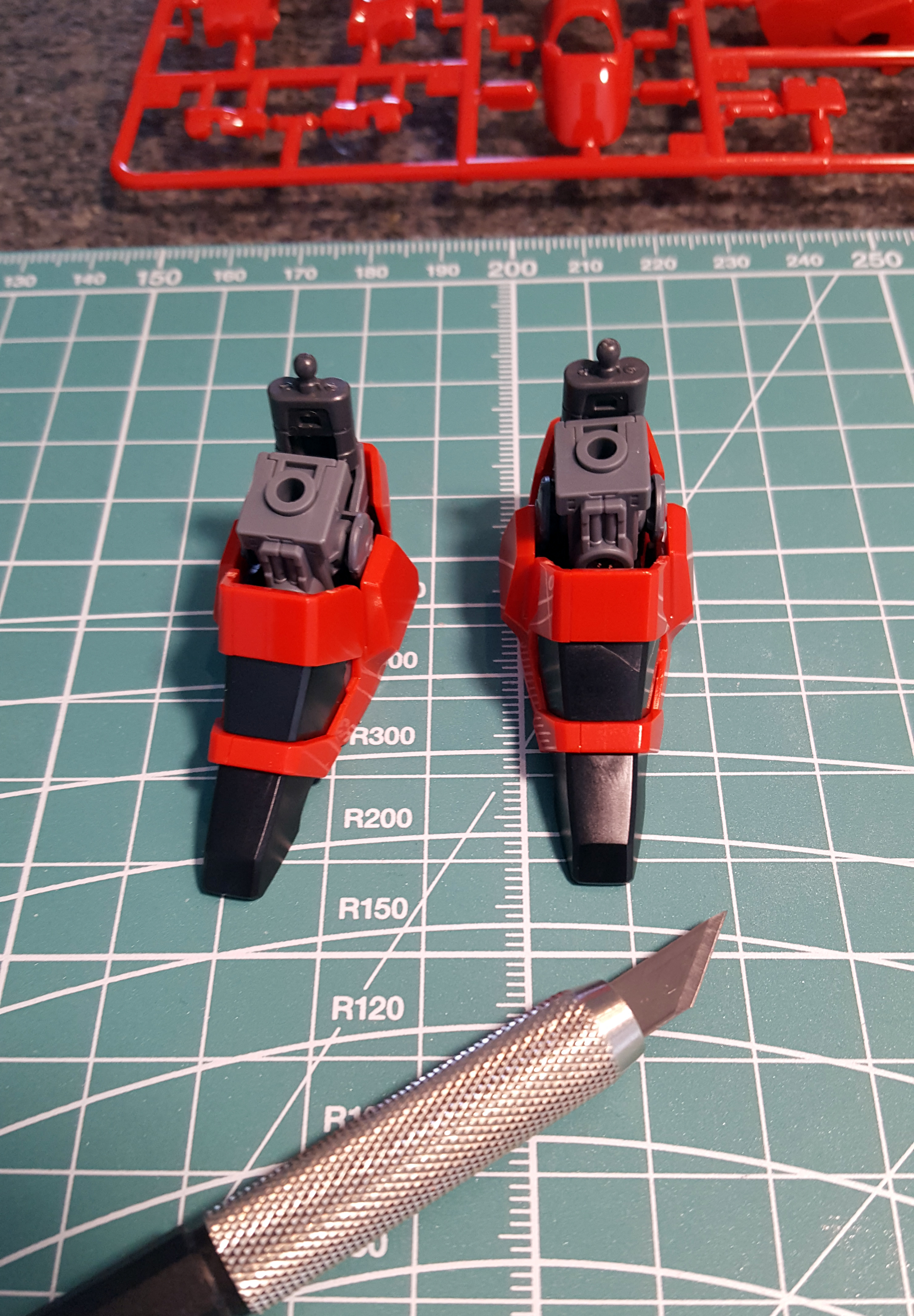 These are about as complex and articulated as on your average MG kit, but tiny. I left the knife in the picture for scale. Up next are the legs, and this is where you run into your first problem with this kit.
These are about as complex and articulated as on your average MG kit, but tiny. I left the knife in the picture for scale. Up next are the legs, and this is where you run into your first problem with this kit.
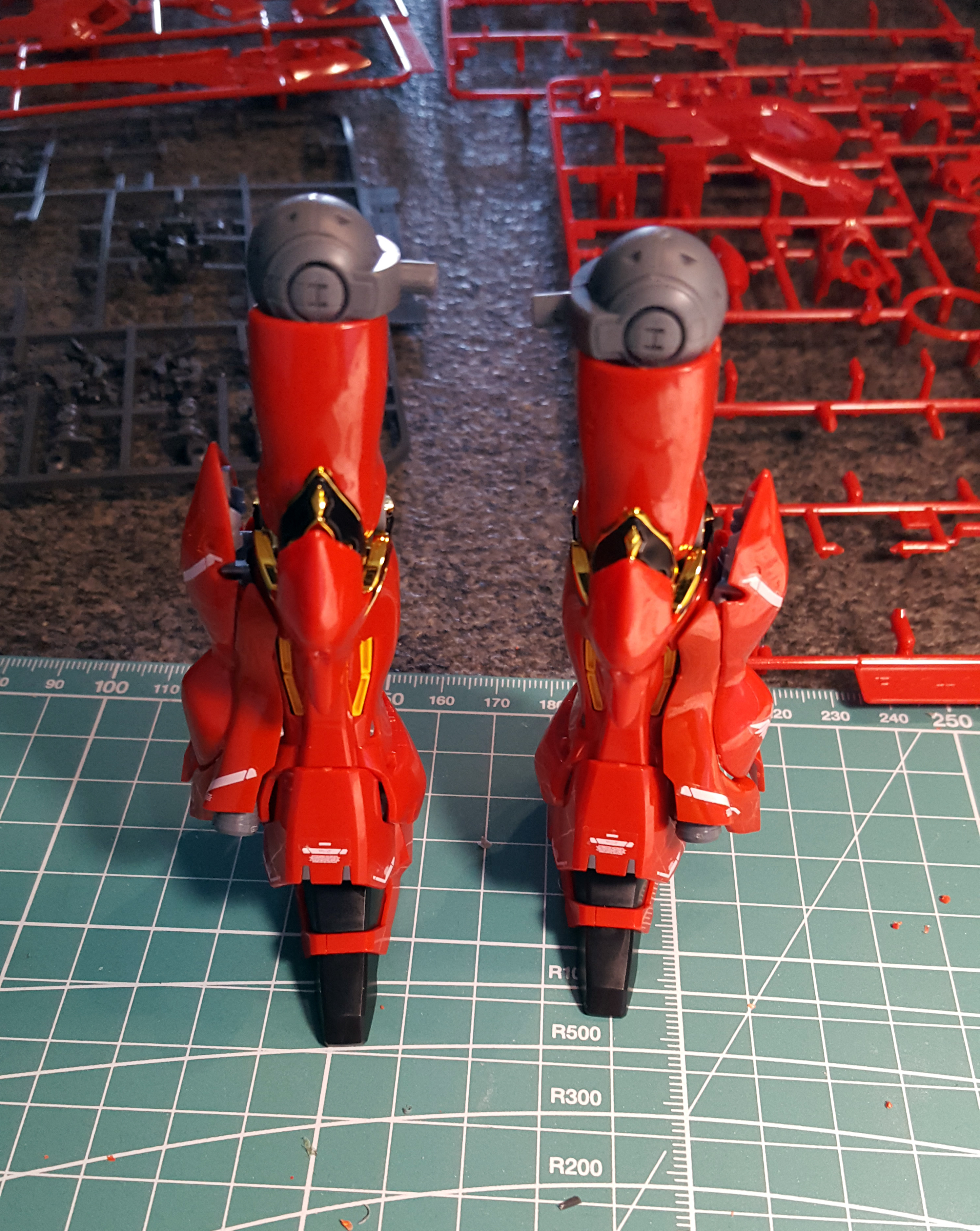
The legs are often the best constructed part of Gunpla kits, at least in my somewhat limited experience, and the RG Sinanju is no exception. The knees bend back very far, the booster pods on the sides open and extend, and, well, they look good, don’t they. But those damned kneepads just will not stay in place, and it’s difficult to tell how dangerous it is to glue them – so far I’ve decided not to because I’m worried I’ll get glue in the joint or that it’ll damage the material of the inner frame. It just seems like there’s not much you can do.
Note also that I decided to decal this kit as I went. I don’t usually do this because I like to see things put together before I decide what decals to put on them, but I’ve kind of come to go the everything route with Gunpla lately, and I really didn’t want to have to take this one apart again at the end.
After the leg comes the hip section with the skirts. No trouble at all here, this part’s rock solid, though those hoses on the front skirts severely limit poseability. They press the skirts down, making it more or less impossible to lift the legs up forward.
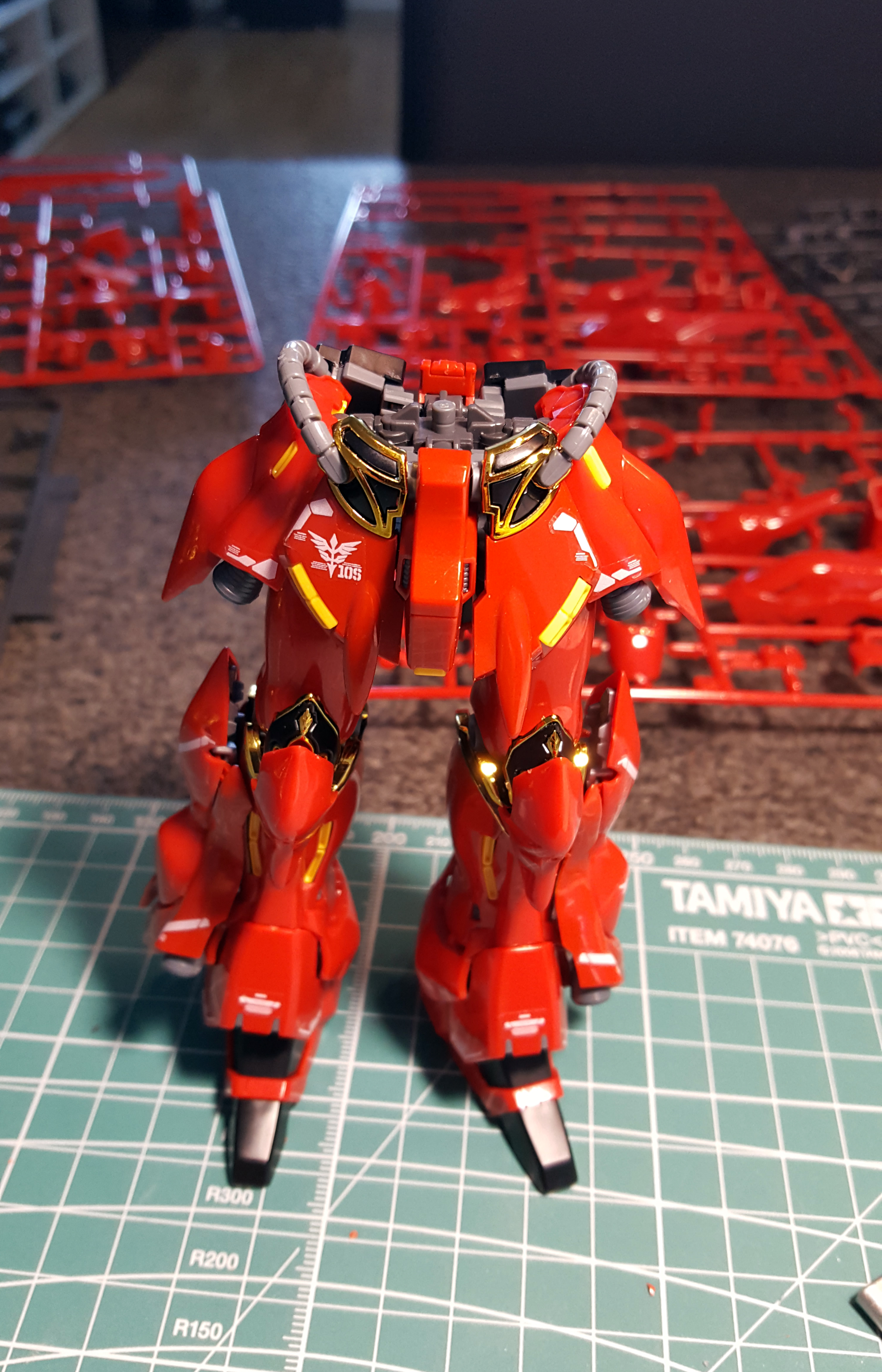
You build the arms next because you can’t complete the upper torso without attaching them first.
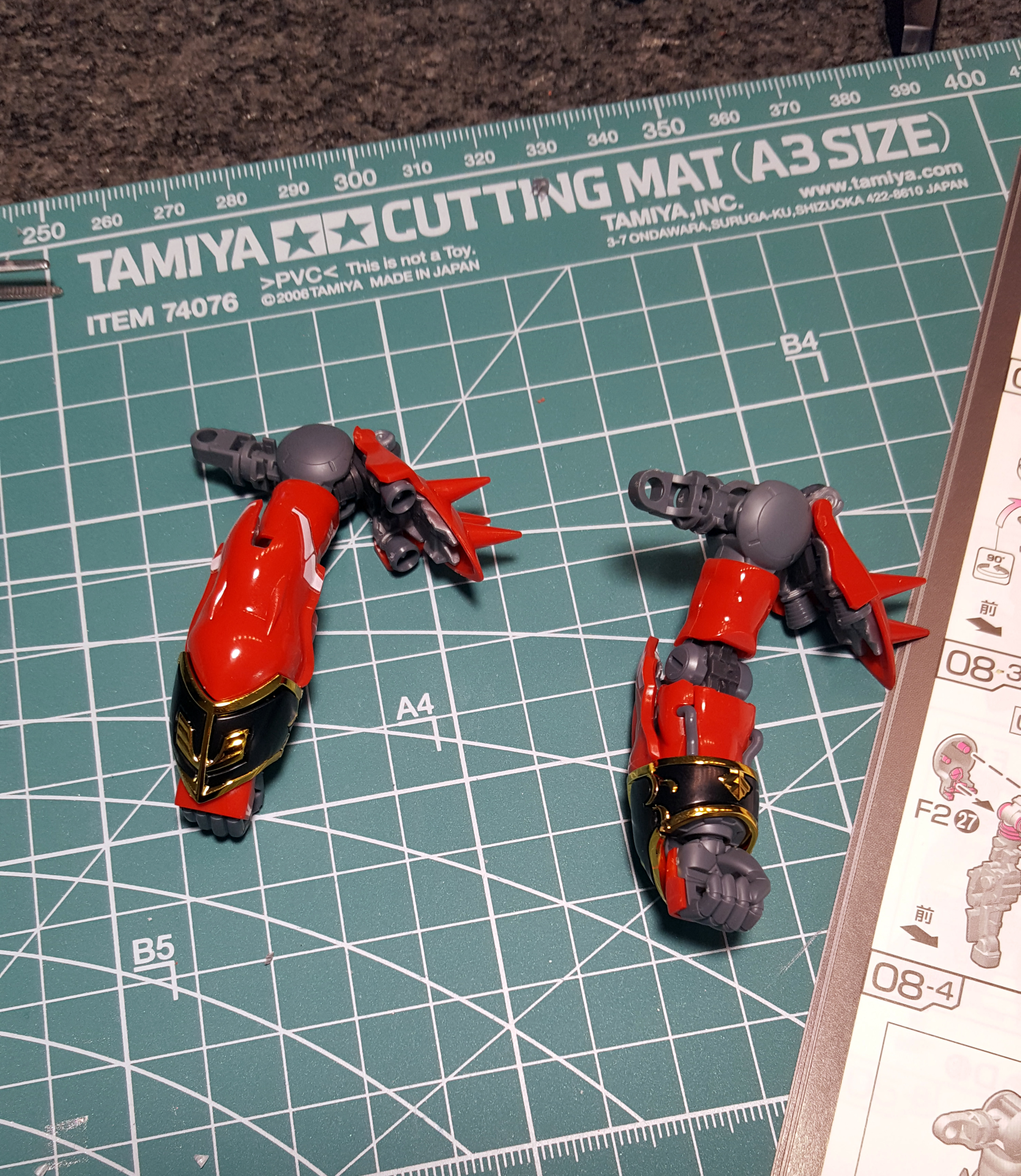 Now the thing about the arms is, they, um, how do I put this… they suck. First of all, the wrists are a goddamn disaster. The black cuff is made up of two halves that always come apart if you so much as look at them, and if it’s not that, then it’s the entire wrist assembly just falling off the arm because of the way it’s attached. You also get basically zero movement out of the wrists except for rotation, and because the expansive cuff armor gets in the way of so many things and you can’t rotate the elbow, this becomes a problem as soon as you want the suit holding any accessories. Oh, and while the elbow does bend almost 180 degrees, if you try to completely straighten it out, the armor halves on the upper arm pop off. This happens all the time. It’s really just infuriating how flimsy the arms are, and it makes posing the kit a nightmare.
Now the thing about the arms is, they, um, how do I put this… they suck. First of all, the wrists are a goddamn disaster. The black cuff is made up of two halves that always come apart if you so much as look at them, and if it’s not that, then it’s the entire wrist assembly just falling off the arm because of the way it’s attached. You also get basically zero movement out of the wrists except for rotation, and because the expansive cuff armor gets in the way of so many things and you can’t rotate the elbow, this becomes a problem as soon as you want the suit holding any accessories. Oh, and while the elbow does bend almost 180 degrees, if you try to completely straighten it out, the armor halves on the upper arm pop off. This happens all the time. It’s really just infuriating how flimsy the arms are, and it makes posing the kit a nightmare.
Anyway, the arms then go on the torso, followed by the shoulder pads.
I’m a bit iffy about the stickers, to be honest. I decided to put them all on because I really like the white pin-stripes on the MG Sazabi Ver. Ka, so I liked that this kit mimics that, but the Sazabi has waterslides, and those work a lot better on curved surfaces than stickers. Plus a lot of the stickers on this kit are really big, especially basically every one of those Neo Zeon emblems, and it’s somewhere between difficult and impossible to apply them without air bubbles or having them peel off an hour later. The one you see on the Sinanju’s left shoulder here is particularly maddening – if you look closely, you can see that it couldn’t really be applied any more to the right because of the groove in the armor there, but the way it is now, it has to bend almost 90 degrees inward on the left, causing it to peel off. It’s pretty literally stuck between a rock and a hard place. I somewhat alleviated this later by cutting off most of the excess clear material, but it still won’t stay completely attached.
Up next is the head. I thought it looked funny without the armor on, so here’s a picture. This is also the only time you really see the green foil sticker on the mono-eye because it pretty much disappears once the armor’s on. Sadly, there’s no way to paint this piece that would look any better than using the sticker; I really don’t like these foil stickers much, but the reflective surface gives it at least a tiny little bit of pop if you look at the head very closely, and that wouldn’t have been any better painted.
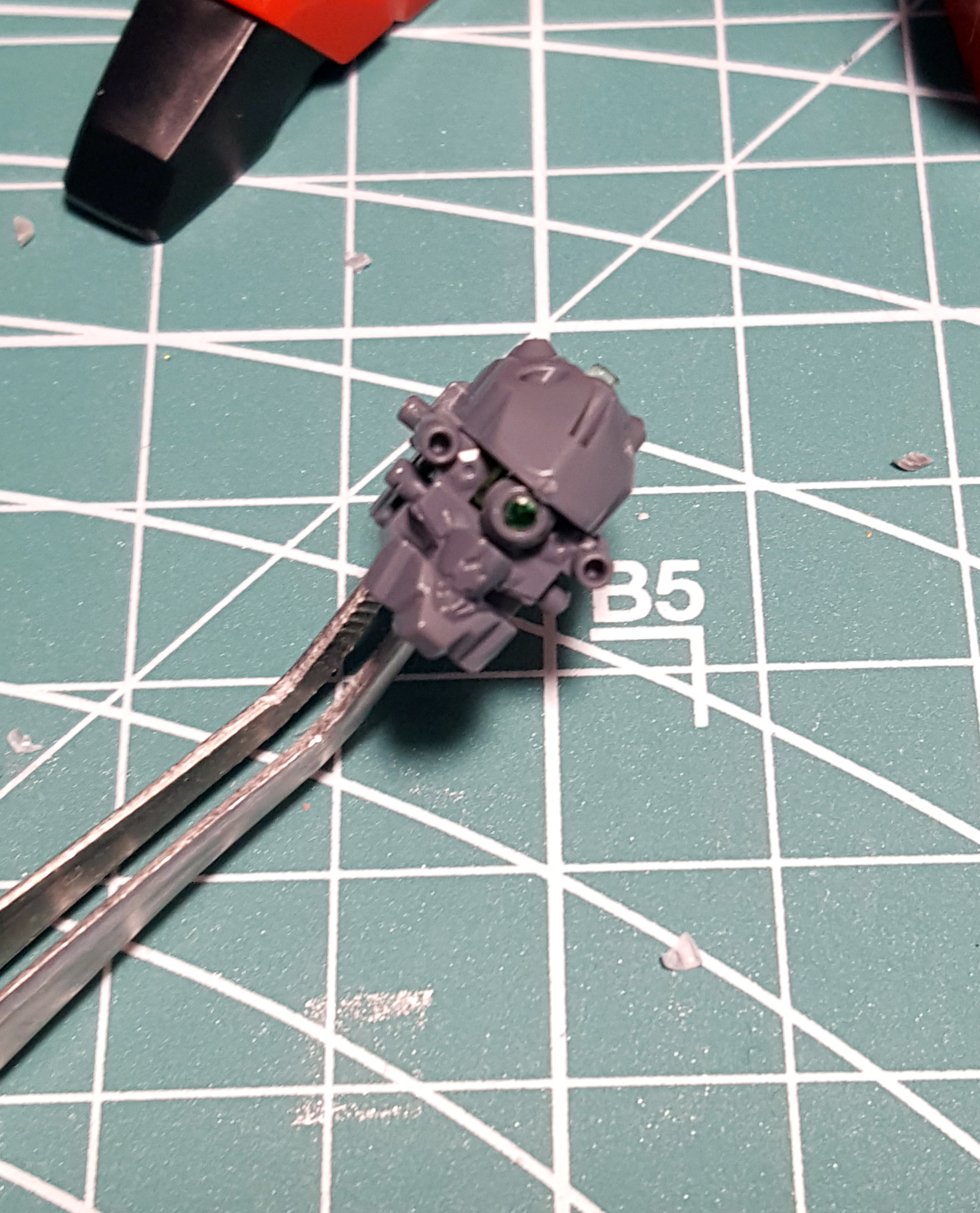 Here’s the head all finished. It looks… well, it looks dang-blasted awesome. It’s about the size of the tip of my pinky, and the amount of detail on it is staggering. Keep in mind that nothing is painted here – the vulcans, unlike on the MG, are actually molded in grey. Everyone knows about the gold trim, but there are other small details like this in other places that require painting even on the MG and don’t here.
Here’s the head all finished. It looks… well, it looks dang-blasted awesome. It’s about the size of the tip of my pinky, and the amount of detail on it is staggering. Keep in mind that nothing is painted here – the vulcans, unlike on the MG, are actually molded in grey. Everyone knows about the gold trim, but there are other small details like this in other places that require painting even on the MG and don’t here.
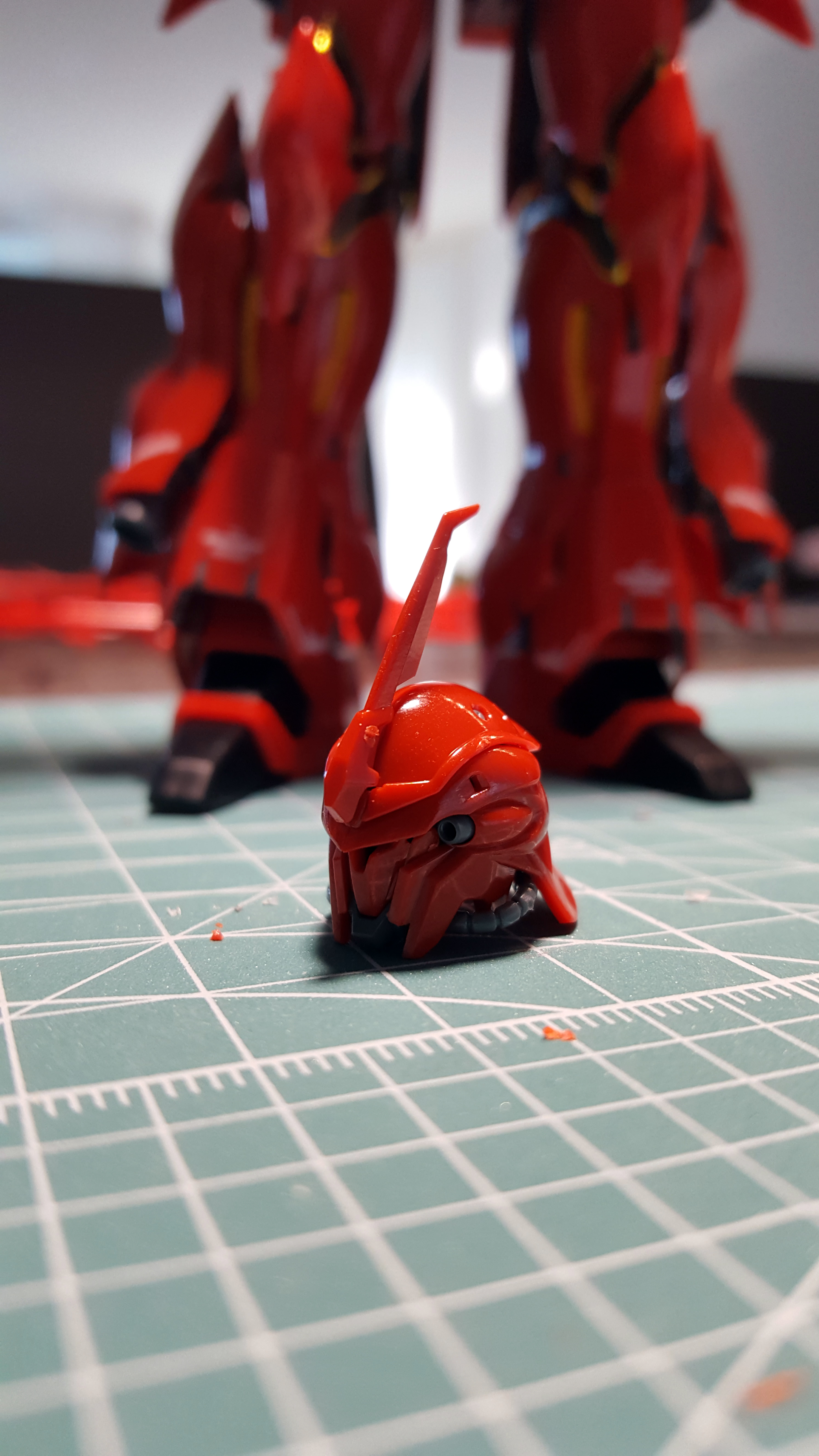
It also has a lever at the top to move the mono-eye that you can access if you take the top of the armor off, but since you can’t see the mono-eye anyway, that’s kind of pointless. Nice idea, though, and I hope they keep it in mind for future kits of other mono-eyed suits. Like the PG Sazabi that has to be coming out any day now because I want one.
The head obviously goes on that little ball joint you saw in the previous picture, but it’s not attached very firmly and likes to come off.
The last thing you build, as usual, is the backpack. And what a beauty it is. I’m sorry, but I love these excessively large fuel tanks, and I wish every mobile suit had them. Note also the grey vents that are separate pieces and not just molded into the tanks like on the MG.
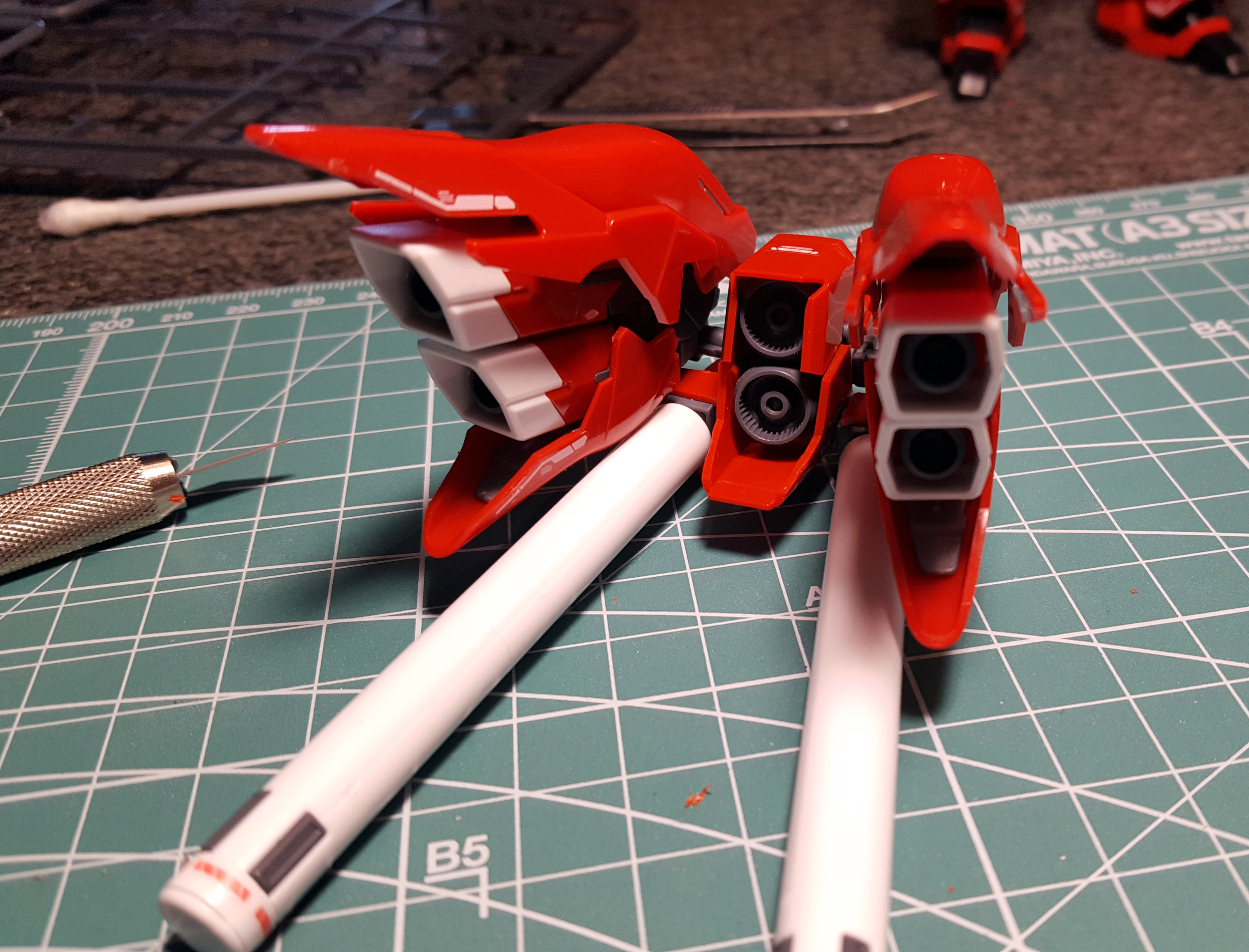
Everything here moves and opens and expands, and of course it’s also an insanely good-looking backpack that adds to the overall visual dynamic of the suit. You’re reading this because you’re a Gundam fan, so I doubt I need to explain to you that the Sinanju is one of the best looking designs in the franchise, and I think the backpack’s a big part of that.
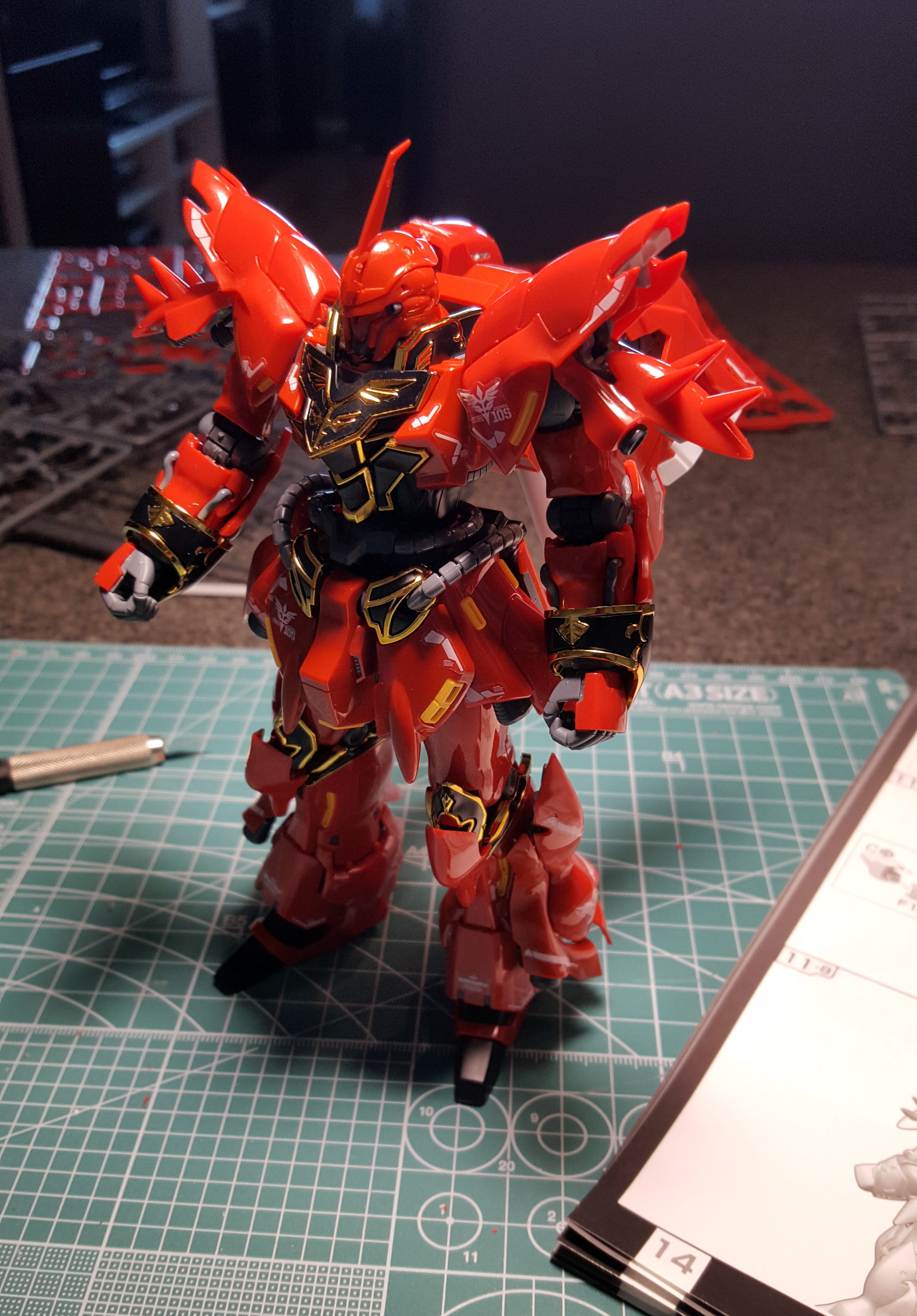 And here he is all built and ready to blow up a squad of ReZELs!
And here he is all built and ready to blow up a squad of ReZELs!
Except he’ll need some weapons to do that, so let’s talk accessories. Aside from the shield, you get the beam rifle, a grenade launcher, two beam sabers, two beam axes with a long and a short blade effect part for each, two weapon-holding hands, one open hand and two poseable hands, plus enough armor parts for all of the hands with one spare. The beam axes can be combined into one long weapon, and the grenade launcher opens so you can pose it as though it’s being reloaded, or it attaches to the beam rifle. There’s also a figurine of Full Frontal that’s so tiny that I couldn’t get a decent picture of it.
While this is certainly a good number of accessories, I’ll join the choir of those who complain about the absence of proper closed-fist hands and a bazooka. It really smells of BS that Bandai decided not to include these here and instead released an insanely overpriced option set with two bazookas, closed fists and a handful of other gimmicks. Needless to say, I’m not buying that set. One bazooka and two closed fists should’ve come with this kit, and don’t talk back to me because you know I’m right.
Also, the poseable hands suck. I’ve never been a fan of these because of how spindly and weird they look, even on the PG Unicorn, and here you don’t even get much poseability out of them because only the index finger is separate. Since they’re on the B sprue anyway, it’s nice that they included separate armor pieces that fit them so you could use them, but no thanks.
I may have to go back and paint the rifle and the beam axes at some point, I just didn’t have the motivation to even touch my airbrush when I was building this kit. As you can see, they’re molded in totally standard-looking bland grey plastic, and it just really stands out against the glossy finish of the suit and the shield.
Of course the main attraction in terms of accessories is the shield. It looks absolutely fantastic. Just look at all that raised gold detail. And don’t forget none of this requires painting – all the gold trim is separate parts.
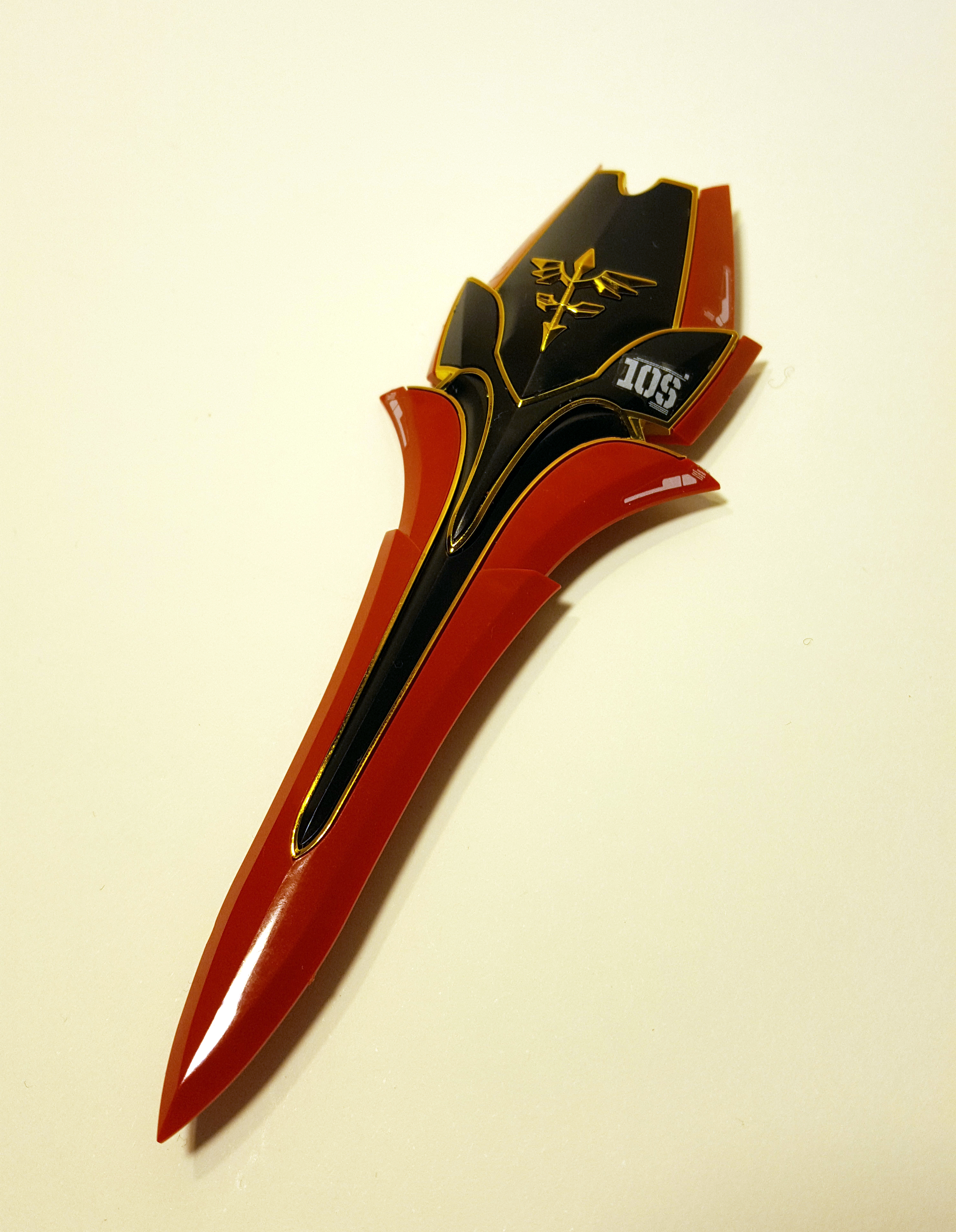
You can also attach the beam axes and the grenade launcher to it, which is nice and actually works really well, but because of the extremely limited poseability of the arms and the fixed way the shield attaches, you can get basically one pose out of that and that’s it. Although admittedly it’s great to see that the arm has no trouble at all holding up this massive contraption.
Connecting the shield to the shoulder armor works much better. Getting the connector bit attached is frustrating and fiddly, but once it’s in there it’s very secure and holds the shield up really well.
Another thing that works surprisingly well is attaching the beam saber blades to the arms. The armor folds out like this to reveal a slot that mimicks a beam saber handle being stored in the arm. It all moves very smoothly and nothing pops off randomly.
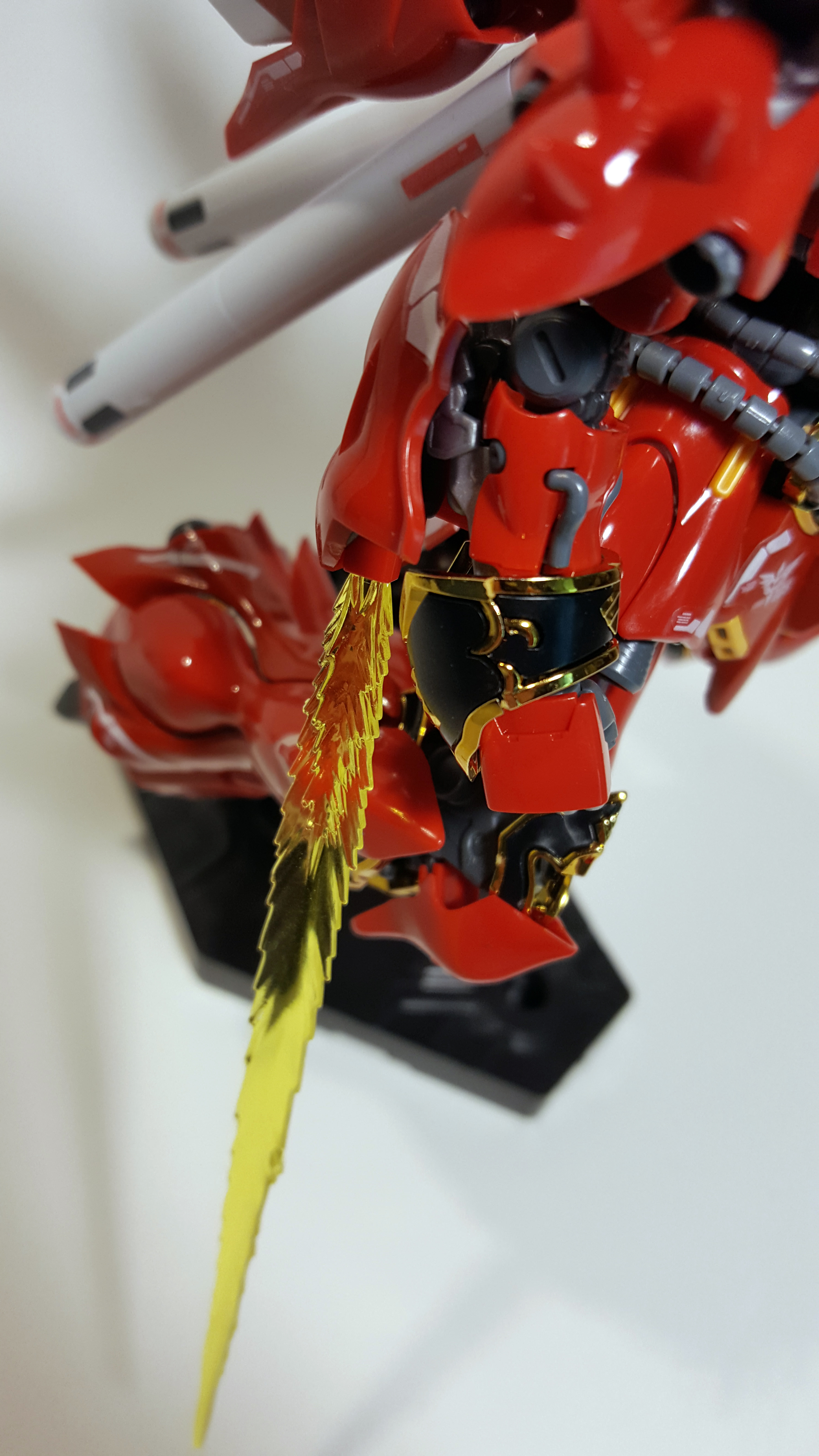
It also allows for some pretty cool poses, though I still don’t really understand why this is such a big deal to some people. I also like the beam saber handle in the hand, not to mention the wrist version would look better with, ahem, cough, proper closed fists.
And that’s it for the accessories. There are a few other gimmicks I could mention – the cockpit hatch on the chest opens and there are opening and closing armor bits on the shoulders and the legs. Instead, I’ll show you this.
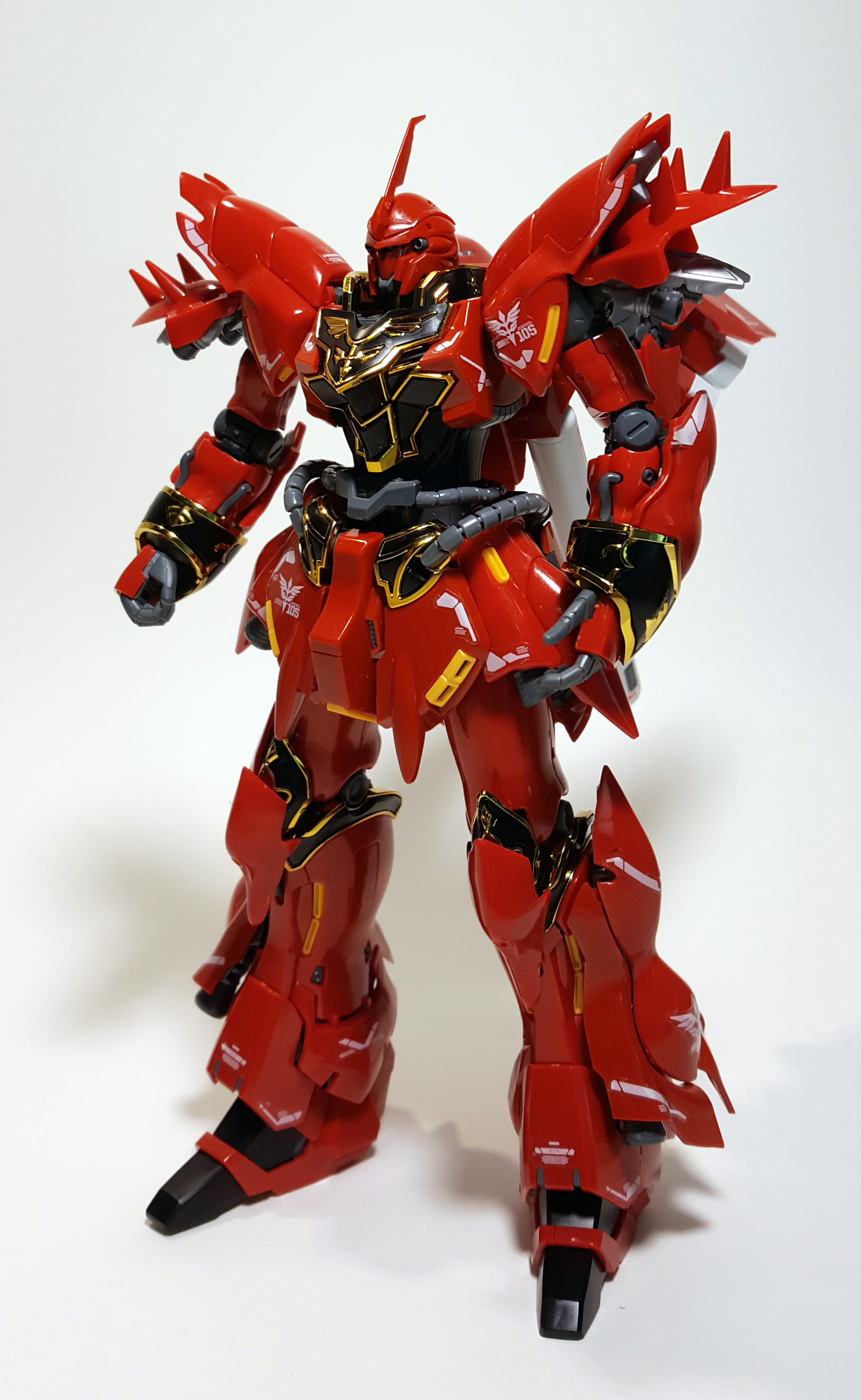
For all its faults, one thing you have to give this kit is that it stands up perfectly fine on its own with the backpack attached and not leaning forward at any kind of ridiculous angle. I’m also not really experiencing the problems other people seem to have with the waist being floppy – it clicked into place nicely and it’s been holding up fine.
Also, just pay attention to how good this kit looks in closeups. Depending on your screen resolution, you’re probably looking at it twice its actual size in some of these shots, and apart from the silvering from the decals and a few nubs here and there, it looks fantastic.
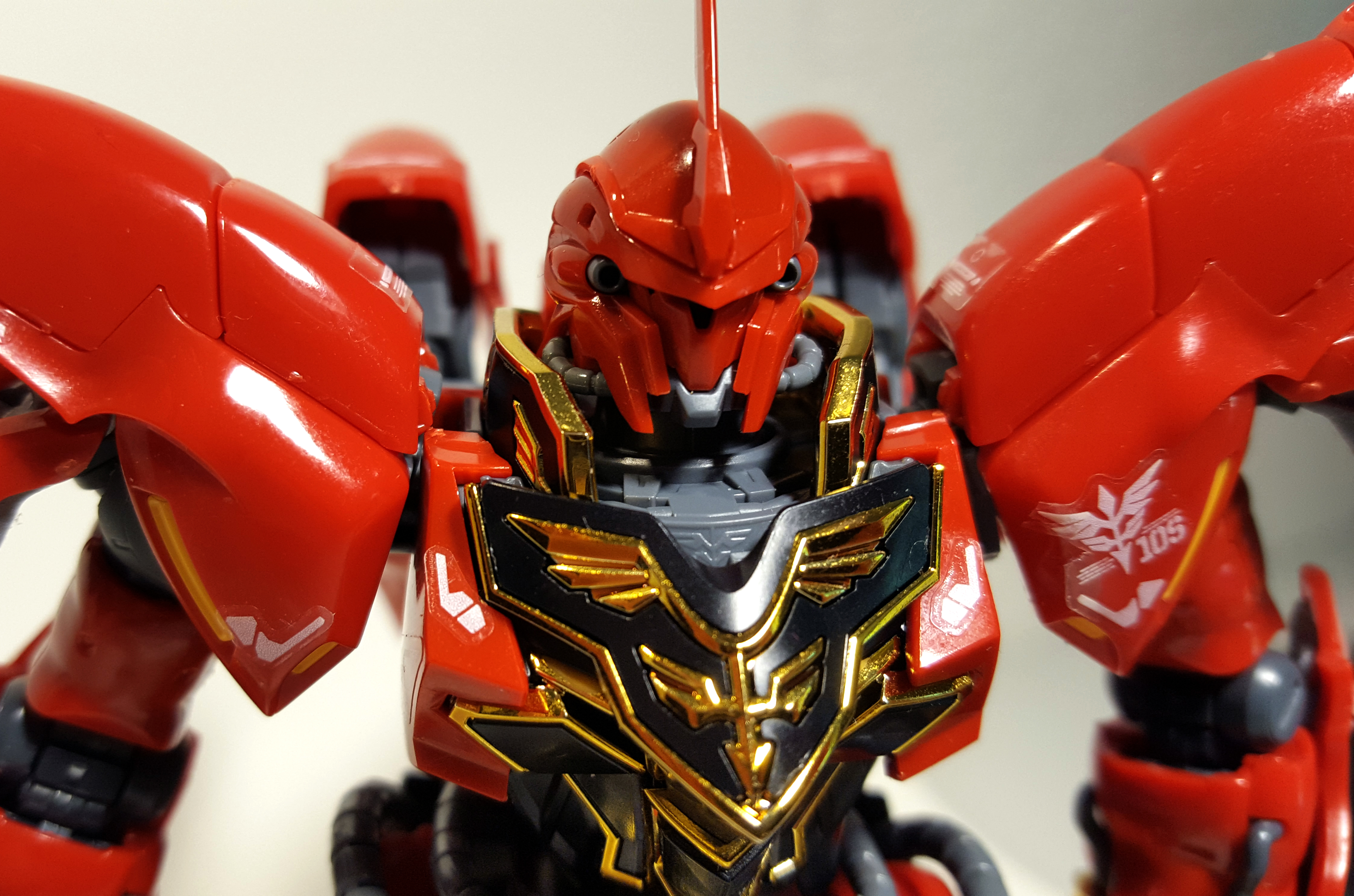
Here you can also see how I tried to fix the problem with that peeling Neo Zeon emblem. Sadly, it started peeling off again a day or two later. I really wish Bandai would include waterslide decals with all their kits for those of us who aren’t afraid of them. How expensive can that be? There’s so many kits that come with multiple sticker sheets of varying types already anyway. I really don’t get it. Sigh.
One final shot before we go. This is how I like to display the kit – airborne action pose, beam rifle in one hand, double beam axe in the other and the shield attached to the shoulders. Looks awesome.
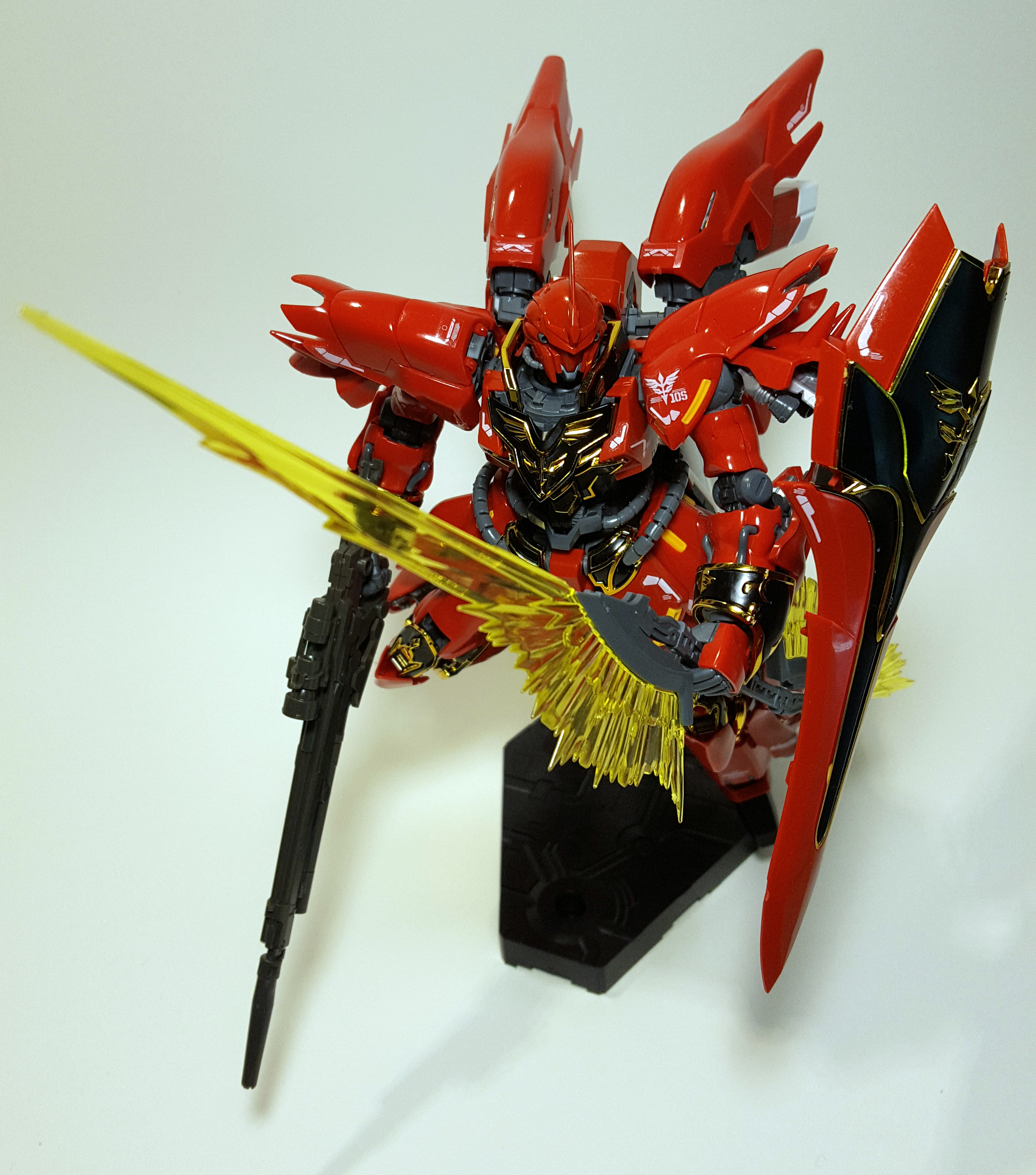
Now, why did I say at the beginning of this blog that I don’t see myself buying too many more RG kits? It’s mostly down to the scale of these things, to be honest. I’ve never enjoyed working with extremely small and fiddly parts, and of course there are many of those on a complex kit of this size. This just wasn’t as enjoyable to work on as the MG and PG kits, and while the end result an absolute beauty to behold, if I’m honest, I just like my mecha models bigger. Maybe it’s just because my real love is Zoids, but I’ve always thought the 1/144 Gundams looked kind of puny.
Plus, while I’m impressed with Bandai’s recent successes at making their kits look great without any painting or even detailing, that’s not really what I’m into anymore, so it’s kind of lost on me. I’d just rather build something bigger and paint it. And if I really want a quick fix with a small kit, I’d rather build an HG kit that doesn’t take this long to put together. For some people, the RGs are probably the best of both worlds, but for me, it’s the opposite.
So should you get this kit, seeing as how everyone who has one seems to have kind of a love-hate relationship with it? You should get it if you like 1/144 scale Gunpla, and if you don’t mind that it’s fiddly and flimsy as long as it looks good, especially just out of the box. Because it certainly does that. It’s a beautiful, beautiful kit, and you won’t need so much as a marker to make it look fantastic.
It’s also flawed and kind of frustrating to work with, but the bottom line is, I have it displayed right next to my MG Sazabi Ver Ka, also unpainted but with panel lining, and the RG Sinanju looks at least as good as its MG ancestor. The glossy finish really makes the detail pop, and there is actually something about the small size that makes it more impressive once it’s all posed up and behind glass.





















































































































































































































































































